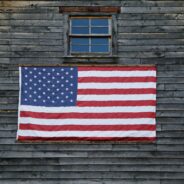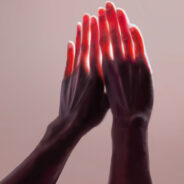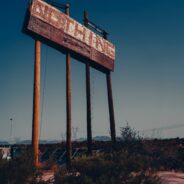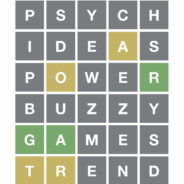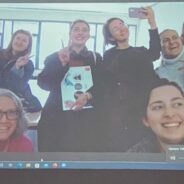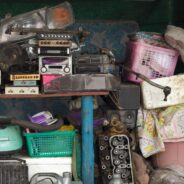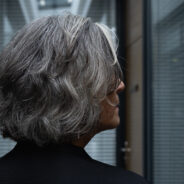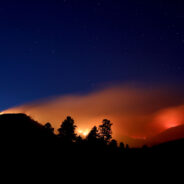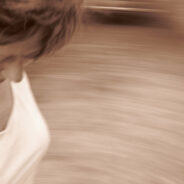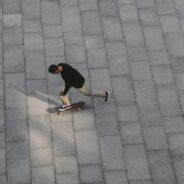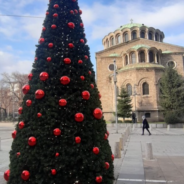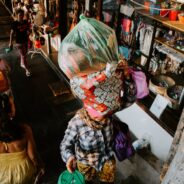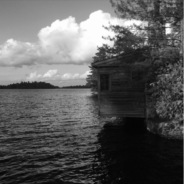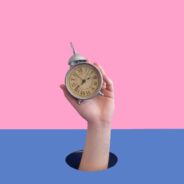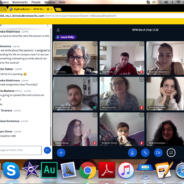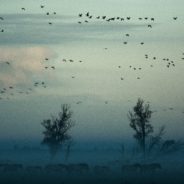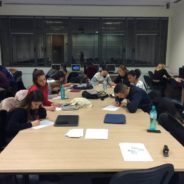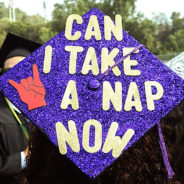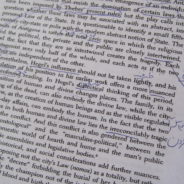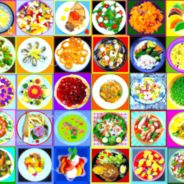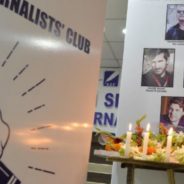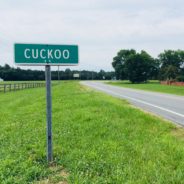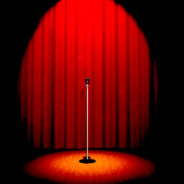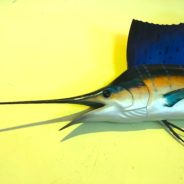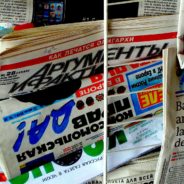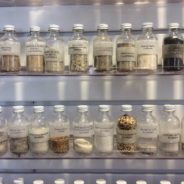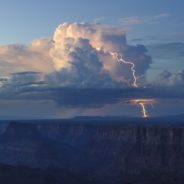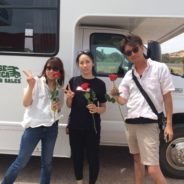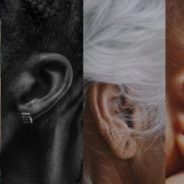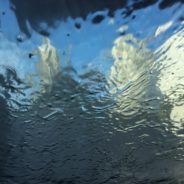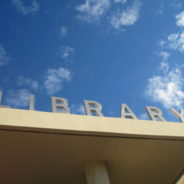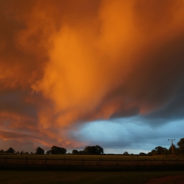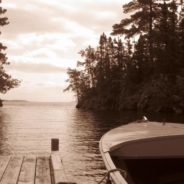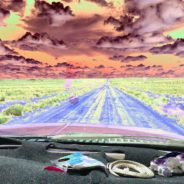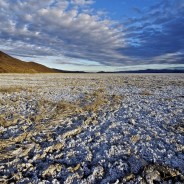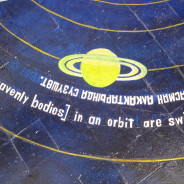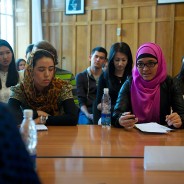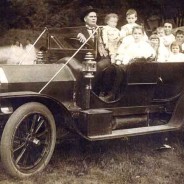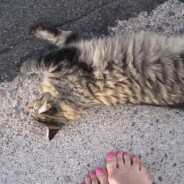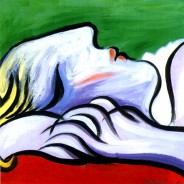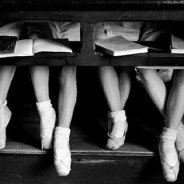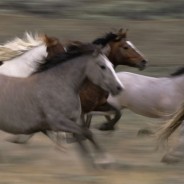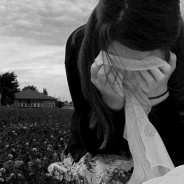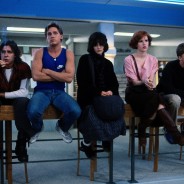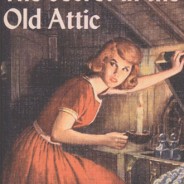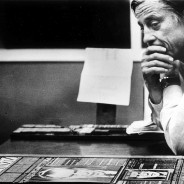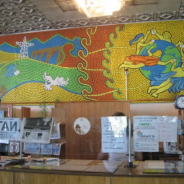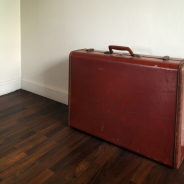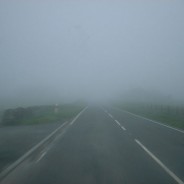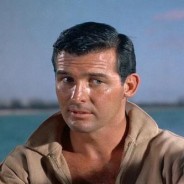Cut, Paste, Repeat
In mid-January, a post from something called Februllage appeared in my Instagram stream. The post was dominated by a calendar of February with a word for each day. Beside the calendar, a small B&W collage of a schoolgirl wearing a hand-drawn crown and hoisting a pair of scissors significantly larger than her head. I clicked onto the post and read further. A clumsy mashup of the words February and collage, Februllage began five years ago when the Edinburgh Collage Collective and the Scandinavian Collage Museum created an open-submission, month-long project. No cost. No entry form. No jury. Simply make a digital or analogue collage every day for the month of February using the calendar of word prompts as a creative springboard. Tag your work with #februllage, and post it onto Instagram. I scanned the word prompt calendar printed in more than a dozen languages and saw concrete nouns, fuzzy emotional states, politically tinged terms and enough ambiguity to create wide pastures of possibility. From this year’s list: bubble, capitalism, escape, encounter, song, plaster, spill, curtain, wrong way. I thought about the shoeboxes of paper scraps I had saved over the years: brochures in foreign languages, vintage medical drawings, maps, flyers and posters from urban life. I’ve been decorating my journals over the years with paint sample strips, ticket stubs and candy wrappers. I am never far from a glue stick. I decided to commit. I imagined crafting collages might bring me a sweet trifecta of satisfaction: play, working with paper, and making art with my hands in a way that evokes the fragrant joy of childhood. What I found during my month of making was that I was not only in with my commitment to produce a collage a day, but I was in a vibrant, active, wildly imaginative global community of collage artists. Kolaj magazine, a Canadian quarterly that “surveys contemporary collage with an international perspective” calls Februllage a 21st manifestation of Surrealists’ parlor games from the 1920s. “If the internet is the house of the 21st century collage movement, then Instagram is its living room. It is the place where artists come together.” The word collage is from the French coller, which means to stick together. Collage is both the process and the product. Though the practice of assembling fragments of paper to make art is believed to have originated in China when paper was first invented there around 200 B.C., the first example of Collage Art with a capital C A appeared in 1912 within Georges Braque’s Fruit Dish and Glass, where he glued imitation wood-grained wallpaper into his painting. Shortly thereafter, Pablo Picasso began to add newsprint to his paintings and glued rope around the perimeter of some of his canvases. Those two gave collage cred. Collage traffics in a DIY high/low culture sphere. Paper, cloth, paint, maps, books, matchboxes, found objects, refuse, magazine and newspaper clippings, samplings of other artworks and texts—the list of usable materials is limited only by imagination–are cut or torn, reassembled, and glued onto canvas or paper or any other field to create visually powerful fusions and juxtapositions. The form often has whiffs of political and social commentary, Dadaism, Surrealism, Absurdism and all the other isms that disturb the status quo and subvert the hoity toity patina that art sometimes...
read moreI Can See Clearly Now
Although Buffalo Park was a slip and slide mud festival after last week’s snowfall, I walked a mid-day lap on Sunday. People who had driven up the hill to see the snow clustered around the entry to the park, squealing as they made snowballs and snapped photos. I sloshed alone through the melting snow patches on the Nate Avery trail. About a half hour in, I heard the steady cadence of a runner behind me. He trotted by, buffed and sturdy and splattered with mud. He looked like the human equivalent of a rugged offroad sports utility vehicle in a car commercial. He wore what looked like a heavy backpack, sunglasses, and shorts. His legs were muscular magnificence. He radiated a musky, feral life force. Just ahead was a chin-up bar. The runner detoured off the trail, glided to the bar and tucked into a half dozen pull ups. As I passed by, I watched him exert, heard his labored breath, and marveled at the human body—its beauty, its capabilities—all more acutely compelling in the face of their eventual decay. I was transfixed, as if I were in the presence of something too powerful to fully understand. On my way home I thought about the runner and those feelings. When I told the story later to a friend, she chided me. She heard it as a lament about my aging body. The runner is at his apex; I am in decline. Stop whining, she said, your body still works just fine. But that wasn’t it. Yes, my age was a factor in my swirl of feelings, but it wasn’t the violin section for a pity party. It is my age that gave me the vantage point to take in all the marvel the runner unleashed in me. If my life is a hike, (my analogy of choice) what I know now is that the further along I go, the better the view, the higher I climb, the better the vista. When I watched that runner I wasn’t thinking of my body—my creaky knee, my fading eyesight, my inability to do chin ups any longer–or of his body, really. Instead, I was thinking of all young bodies everywhere and their offhand beauty, the gravitational pull of their physicality, the beguiling and beautiful sight of a human being in top physical form. From my vantage point now as a woman in her sixties, I not only see a bigger picture, I feel a more acute depth to my response. Beauty is everywhere, calling me to witness it. This, I find, is easier from my vantage point. When I was young girl, one of my favorite Olympic sports to watch was high diving. It was only seconds that they twirled and tucked between board and the water, but it mesmerized me. The perfection of their bodies and their movements. The contours of their thigh muscles, the industrial strength of their shoulders. The control and mastery and command. My feelings were never sexualized; instead, it felt to me like watching music and being silenced by my good fortune at beholding something close to perfection. I read a story recently in Forbes about a 46-year-old California billionaire obsessed with reversing his aging process. It has become his life’s work. He has a herd of...
read moreSing With Me
The year after I graduated from high school, I crisscrossed the U.S. in a flotilla of Greyhound buses with about 150 people my age. We were one of three traveling casts of Up With People, a wholesome performance troupe singing across small town America and spreading a message of global goodwill. I wasn’t selected because of my superior pipes or formal training; I was chosen because I could hold a tune and I played well with others. I had sung in my grade school chorus, sung in Sunday church, sung to vinyl my friends and I would spin at slumber parties. But singing in Up With People was next level. We sang as a group for hours every week: in rehearsals, during performances, on the buses. We sang in schools, in prisons and hospitals, on stages, in amphitheaters, in downtown plazas. While I can no longer solidly remember the names of all the cities where we performed, what I can viscerally conjure is the powerful feeling that surged through me when we sang. It was warm, sudden, shimmery and profoundly stirring. I’ve been chasing that feeling ever since–kama muta, a Sanskit word that means moved by love. Researchers at the University of Oslo’s Kama Muta Lab define the emotion as a sudden feeling of oneness, union and belonging. What my year in Up With People taught me is that singing in groups bathes me in kama muta. And the more I feel that good feeling, the more I want to feel that good feeling. When we sing, large parts of our brain buzz and illuminate, says Sarah Wilson, a clinical neuropsychologist at the University of Melbourne in Australia. “There is a singing network in the brain quite broadly distributed,” Wilson says. When we speak, one hemisphere lights up. But when we sing, both sides of the brain light up.“What we are doing when we sing is developing this specialized network, which gives us that physiological reward hit, the chills, the dopamine release, the sense of feeling good,” says Wilson. Singing is ancient, universal and resoundingly primal. There is no human culture on the planet, no matter how remote, that does not sing. Some researchers believe that singing preceded speech. We, as a species, sing for entertainment, for storytelling, to celebrate rites of passage, to beseech our various gods, to recount our victories, to memorialize. Some cultures sing themselves into being. In the belief system of the Aboriginal people of Australia, songlines are the melodic, history-holding paths of the creation ancestors. The origin story goes like this: From what was a vast void, the Dreaming began. Creation ancestors sprang forth and began forming the earth. As they travelled, they created living things and the landscapes that would be their homes. Those travelling paths became songlines of dance and music, song and story that unfurl over generations and carry who they are. Singing in the car, in the shower, as I push a Swiffer over a dusty floor. Singing solo just doesn’t have the emotional oomph as singing in a group. Like some spiritual adhesive, singing in groups binds us, connects us in a form of unity we can’t seem to replicate when we speak with one another. “There is evidence that, in general, singing in a group enhances our empathy and...
read moreMy Lipstick, Myself
It is the 1960s, and I am five. I’m with my mother in our suburban bathroom, watching her apply makeup. I am mesmerized. And I am imprinted. She holds her Maybelline oval cake of eyeliner under the faucet and coaxes a few drops of water, swirls it with a tiny brush, and swooshes it atop her lash line. She dabs at her nose with a powder puff. She darkens her brows with a pencil. And then the ritual de la resistance—the lipstick–always the final, dramatic act. She swivels the lipstick up from its tube, leans into the mirror. She sweeps some frosted orange shade back and forth, rubs her lips together, dabs away some excess at the corners of her mouth with her pinkie. When she’s done, she pulls off a square of toilet paper to blot her lips, leans back, takes it all in, and smiles like a Cheshire cat. I started wearing makeup when I was in high school. Some mascara, some blush, a smidge of eyeshadow usually in a garish blue that was in vogue at the time, but never lipstick. Lipstick was for moms or movie stars. When I was in my late teens and early 20s at university, I embraced the flavor of feminism popular at the time. Scholars call it second wave feminism. Loosely defined, this wave saw the conventional ideas of femininity as incompatible with feminist beliefs. We had serious work to do, rights to fight for. We didn’t have time to apply eyeshadow. Fashion and glamour were considered superficial and diminishing. So, I spent my college years rejecting bras, pantyhose, curlers and girdles—the femininity food groups for my mother’s generation. Giving those up was not a sacrifice because they weren’t my jam anyway. They belonged in the province of old ladies. But I wanted to fit in with my feminist crowd and fight the power, so I didn’t shave my armpits. I cancelled my subscription to Glamour magazine. And I boycotted the cosmetics industrial complex. Sort of. I still wanted to wear makeup. I liked it. The ritual, the transformation. Nothing too much but just enough to get the psychological boost that felt like a sugar high. I liked painting myself, playing with color and contour. But to remain true to my newly found personal politics and the unspoken rules governing that belief system, I wore my cosmetics on the down low and developed what I considered a morally righteous taxonomy: Mascara yes. Blush yes, but sparingly. Eyeshadow no. Lipstick absolutely not. Could I be a feminist and still wear lipstick? I didn’t think so. Some might say that wearing lipstick is a superpower. Coloring the lips has been a practice for at least 5,000 years when Mesopotamian women crushed gemstones and mixed them with beeswax to adorn and color their lips. Reportedly, Cleopatra blended pulverized carmine beetles and ants to create a crimson hue for her lips. Lip color didn’t morph into lipstick until around 1880 when it moved from being kept in tiny pots and applied with fingers to being something akin to a skinny Vienna sausage–a rigid, tubular mass that was congealed with grape seeds. The stick didn’t swivel; instead, it was pushed up out of its tube and locked into place with a mechanism similar to...
read moreBored Certified
This summer I joined a large group of broken people. After a torqued misstep and a hard fall onto a broken sidewalk, I ripped my meniscus and watched my knee swell into what looked like a head of angry cauliflower. Inside, it felt like a batter of hot lava spiked with razor blades. As I awaited orthoscopic surgery in July, I hobbled around the house, ice packed the joint into submission, and felt sorry for myself. I believed I had some valid reasons for my self-pity, but because I had a three-month summer vacation, a backyard full of pine trees that rustle in the summer wind, and loving friends, those poor-me feelings didn’t find sufficient traction. Instead, I moved onto boredom. I am someone who does not get bored easily. Or perhaps I don’t admit it as often as I feel it. We live in a culture that assigns status to busyness. Stimulation is only a scroll or click away. Productivity is the holy grail, and boredom is not a celebrated state in our attention-hijacking economy. I have spent much of my life regarding boredom as a personal failing, much like Dino did, the protagonist of Alberto Moravia’s novel called Boredom. “Boredom to me consists in a kind of insufficiency, or inadequacy, or lack of reality.” That’s how I saw it, too. If my inner life was a multi-plex, couldn’t I just cue up another reel to capture my attention and ferry me into stimulation? Like everyone, I suppose, I can get bored cornered at a party by someone who drones through a story, by a professor bloviating through a lecture, or by an unexpected empty evening colliding with a lack of energy and imagination. Like many, I suspect, I’ve tucked into binging Netflix or pouring another glass of wine as diversionary tactics to combat my occasional bouts of boredom. Boredom has vexed evolutionary psychologists who believe that emotions should evolve for our benefit–not to push us to self-destruction. “The very fact that boredom is a daily experience for many suggests it should be doing something useful,” says Heather Lench at Texas A&M University. Feelings like fear help us avoid danger. What does feeling boredom achieve? First off, boredom does not mean you have nothing to do. “When we’re bored, there are two key things happening in our mind,” says John Eastwood, a psychologist at York University in Canada, and author of Out of My Skull: The Psychology of Boredom. “The first thing is what I would call a desire bind. That’s when someone is kind of stuck because they desperately want to do something but they don’t want to do anything that’s on offer. Secondly, when you’re bored, your mental capacity is lying fallow.” Laying fallow like soil left to rest and regenerate. Contemporary research shows that being in a state of boredom encourages us to create because our brain is signalling that our current situation is lacking. Letting our minds wander is crucial for creativity; we can only attain this state if our mind is idle. Boredom beautifully idles the mind. Even though I felt housebound and irritable, my boredom this summer didn’t feel as if it were a response to being stuck. Eastwood, like other researchers who study boredom, encouraged me to see boredom as a...
read moreOh Say, Can You See?
I used to write occasionally for the Miami Herald, my local daily newspaper. One day some years back I visited the newsroom to make changes to a story I’d submitted. I sat amidst the din, my head bent over a computer keyboard in pronounced concentration. “May I have your attention?” I looked up to see a knot of people. One woman carried a little cake covered with chocolate frosting and crowned with a lit sparkler and a plastic American flag. About three dozen people formed a semi-circle around the desk that held the cake. In the midst of everyone was a young man in pleated trousers, tasseled loafers, and a red, white and blue tie. “My name is Etienne, as you all know, and today is one of the proudest days of my life,” he said in a soft voice, laced with a Caribbean cadence. “Although I was born on the island of Haiti, I had to leave my country because of the troubles. And though my island will always be in my heart, another country is there, as well. Today, I became a citizen of the United States.” Etienne beamed as if he’d just won the lottery. “I am so proud, so thankful. And I would like to sing this song to you.” He cleared his throat, ceremoniously clasped his hands in front of him and began “The Star-Spangled Banner.” Etienne’s voice stumbled a bit as he negotiated the tricky melodic patches. I hummed along, wondering when the last time was that I had sung the national anthem with so much genuine emotion. Ever? “O’er the land of the free and the home of the brave,” his voice rose into a crescendo. Tears leaked from his eyes and fell toward his prideful smile. Silence coated the air before the crowd again broke into applause. A handful of reporters went forward to congratulate him. I returned to my computer to complete my editing. The memory of that afternoon has been flickering in my mind. I’ve spent more than 12 years as an ex-pat, working and living abroad. I view my country’s maneuverings refracted through the eyes of friends and acquaintances from Eastern Europe. Sometimes I am asked to explain our foreign policies, to decode our relationship with guns, to help make sense of political leadership. I cannot. Instead of feeling the strain of pride I saw I Etienne, I’ve spent my adult life questioning, bemoaning and criticizing the United States, a practice whose acceptability is dwindling even though we are a country where challenging the status quo is baked into our national DNA. The summer after I watched Etienne sing the national anthem, I was in the midst of a two-week business trip to a handful of Caribbean islands. Jetlagged and sunburned, I arrived the morning of July 4 on Saba, a rocky, green speck of an island within eyeshot of St. Martin. Saba has fewer than 1500 people living quietly on four square miles of stingy soil. I spent the afternoon with Will Johnson, the local newspaper editor, talking about his minute Dutch island and his 25-year-long, self-appointed mission to produce and distribute the only newspaper his island has ever known. As his wife refilled our coffee cups and served us our second slices of carrot cake, Will and...
read moreThe Tragic Balkan Poet
About 20 years ago, I was awarded a Fulbright grant to teach journalism in Tirana, Albania, the capital city of what was then Europe’s poorest country. At that time, Albania lurched and sputtered in its rebranding from a mysterious Communist outpost to a capitalism-fueled democracy. When I arrived there, the country had no ATMs, no constitution and no steady stream of electricity. Classes at the university were held in a three-story Italianate building, painted in a fading rose and mustard color. Two columns flanked a central staircase in the foyer, which always smelled faintly of the hygienically challenged Turkish toilets down the hall. Tucked in the foyer corner was the librari, a bookstore the size of a garden shed with broken, dusty panes of glass and a chunky padlock on the door. There were no closets fattened with supplies, no humming Xerox machines, no glossy catalogues and no textbooks. Entry to the school was by examination or by forking over a hefty bribe. My classroom sat on the third floor, room 305. The students shared desks and wobbled on mismatched chairs. A square of black paint swathed onto the wall served as the blackboard. No eraser. No chalk. Casement windows along one wall provided the only source of light. It’s the first day of class. I’m nervous, but curiosity propels me past fear. Diana, a television reporter who is also my translator, stands beside me. I ask the students to introduce themselves. They wear jeans and backpacks. Their names are dissonant jazz: Etjola, Gjergj, Xhulieta, Zylyftar, Ermal, Manjola. One of my students is Alfred, a young man with a slight scowl, cheekbones like diving platforms and zealously moussed hair. His hands are luminous with long, white fingers. In my mind I nickname him Tragic Balkan Poet. I scan the 29 faces and return to Alfred’s. I am drawn to how pale and haunted he looks. I ask the students to write a paragraph explaining why they want to be journalists. Diana reads their responses later as we sit in Cafe John Belushi and drink warm, foamy Turkish concoctions called salep. Alfred wrote, “I love the horror of being with a white sheet of paper that has to be filled.” Mira wrote, “It is something difficult and things difficult are also beautiful.” Alban wrote, “Suffering is the most important thing in life. I am nothing if I cannot tell my stories.” Perhaps they’re all tragic Balkan poets. I write a comment on Alfred’s paper, complimenting his lyrical prose. “There’s a hint of poetry in your writing, your word play,” I say. After the next class he approaches me. His hands tremble slightly and his eyes dart. In a soft, papery voice he asks Diana to tell me that he is indeed a poet. He says he has published a slim volume of his work. It is entitled, “I Am Born Dead.” The semester unfolds. I announce that every Friday I will park myself from 11 a.m.-3 p.m. at Cafe Pergolah, a small place with outdoor tables near the university. If anyone wants to come by and chat, I will buy the coffee. We’ll be on our own with language, I say. Diana won’t be there to translate. About a dozen students show up on those Fridays. Alfred is always among them. We...
read moreMuch Ado About Nothing
About a decade ago I was invited by Dan, a jazz pianist, to be a participant at an artist’s retreat. I met Dan at a Nevada Arts Council meeting held in the conference room of a swanky Vegas mega-hotel. We were panelists awarding grants to arts organizations around the state. I could hear the faint musical encouragement of casino slot machines as we sat behind name cards discussing the dozens of applications stuffed into lethally sized binders. Cigarette smoke drifted into the room whenever the door opened. Dan told me about the retreat over lunch. He was looking for jazz musicians and poets, he said, because “metaphor and improvisation are two of their food groups.” I was game. In late July, 10 of us met on a dock outside of International Falls, Minnesota and boated to a small island in the boundary waters between the United States and Canada. No agenda, no schedule, no wake-up calls, no Wi-Fi. We spent most of our time solo, canoeing, swimming, staring at clouds and retreating into our cabins to read, write or work on whatever we were working on. In the evenings, we gathered, cooked a communal dinner and sat around a scarred, wooden table sharing the meal and conversation that circled around the idiosyncrasies of creativity. When Dan had invited me, he asked if I would be interested in leading a loose discussion around the dinner table one evening. Any topic, he said. I chose nothing. Nothing. No thing. The opposite of everything. The absence of anything. I wanted to talk about the role of nothing in the things we made. What kind of nothing was something for each of us? I know that talking about nothing can make your brain curly and overheated. It’s like thinking about infinity or what it feels like to be dead. There’s no satisfactory landing pad for your thoughts, and the more you think, the muddier it can become. Philosophers have been duking it out over the concept of nothing for millennia, beginning with the recorded history of the Greeks, who took the stance that nothing was not a viable concept. It isn’t possible, they posited, for nothing to exist. Even metaphysicists, who most often train their pointy-headed hypotheses on what does exist, have ventured into the business of looking at some of the more popular scientific flavors of nothing: omissions, vacuums and void. We weren’t metaphysicists or philosophers. We were a bunch of artists sitting around a table drinking boxed wine, deconstructing what we do. When we spoke of nothing, our conversation tilted toward ideas of rest, pause, space and silence. We talked about the kind of nothing that makes our something, something. The rest between notes. The silence between sounds. The space between words. We turned toward Eastern philosophies where nothingness is cousins with emptiness. Taoist teacher Lao Tsu said, “We shape clay into a pot, but it is the emptiness inside that holds whatever we want.” The Chinese word for emptiness is kong; it is seen as the space between, a fertile place between lives, breaths, musical notes, words. The Japanese have the concept of ma, which is applied to all aspects of life. It is described as an interval, the artistic interpretation of an empty space. It is the vital place...
read moreMy Old Friend Grief
My father’s death in my mid-20s introduced me to grief. The sorrow I felt had a language and texture all its own. So I did what my journalism training taught me to do: drink more and dive into research. I learned about the stages of grieving, the physical symptoms, the scientific blah blah blah of it. Armed with all that information, I felt soothed and masterful, and after a respectable number of months, I thought I’d Marie Kondo-ed my way out of it. The knee-buckling weeping, the dream state numbness, the radioactive sorrow were jettisoned because they did not spark joy. I pushed them into the past tense. Dad was tucked neatly into my memory. I’d made peace. Found closure. Was moving on. Then I ran into a friend in a bookstore. She looked like a crack addict—haggard, glassy-eyed. With my grief-vision goggles, I could see that she had a dust cloud of the stuff billowing around her. She told me her father had died a few weeks earlier, and this was the first time she had left the house. “You lost your father too, didn’t you?” she asked in a trembling voice. Then the world went small, and we stopped talking. We leaned against a table full of books, crying and holding hands. I didn’t even really like her that much, but grief had branded and fused us. Familiar and dreaded feelings resurfaced, and I was again swimming through oatmeal, back in the gluey eddies of grief. I had yet to learn that grief can play a perverse version of Mother May I, sending us back to the starting line for pretending that we are okay or for hurrying it along. Grief really does not like for you to tell it to go faster. Amplifying my grief was my subterranean shame (I should be getting over this faster!), my confusion (Am I a freak?) and my fear (I will never feel good again.) The more I sought to fold and bend grief into soothing shapes like some sort of emotional origami, the more it gormed all over me, the more it roared back. I was a novice then. Loss now is more familiar, as is the grief that is its travelling companion. I have learned that grief has riptides. Grief is bossy. Grief makes me—makes us all—its bitch. And instead of fighting, denying or managing, I have learned to fall to the ground and roll onto my back like a submissive animal. Grief feels these days like a long foreign film with no subtitles: I am not always sure what is going on, but if I roll with it and stay for the entire film, the end eventually comes, and I am left with a lot to think about. The call came last week. A longtime friend has died. We were once lovers, neighbors, buddies. He was my age, and he died doing what he loved. As I heard the news, I blurred into a feeling of gauzy dislocation. Ah, this. This again. I’ll go to my friend’s memorial service and mourn with the others. I imagine I’ll have trouble sleeping and may find myself crying when I speak of him. I’ll consider the terror of the unknown and the satisfaction of a life still unfolding. I’ll reach...
read moreFrom Here to There
It was late morning as I sat in an emptyish Munich airport cafe, bleary from a transatlantic flight. Six hours loomed before my connection to Sofia. I decided to spend the time drinking coffee and feeling sorry for myself. A smartly dressed older man and woman came to the table beside mine and laid down their carry-on bags, coats, water bottles and backpacks. After a brief discussion in what sounded like Danish, the man and the woman began reassembling their belongings. I glanced, but was lasered into Wordle, determined to keep my winning streak going despite the jet lag brain fog. When I looked up a few moments later at what was their table, I saw an empty water bottle, a crumpled napkin and a small leather bag, the kind people use to carry money and passports when they travel. Despite the state-sanctioned suspicion, we are encouraged to brandish with strangers when we are in airports, I picked up the bag and walked into the concourse. The couple was nearby, ogling muffins in a bakery window. I approached the woman, said nothing and handed her the bag. She looked relieved and sheepish. I smiled at her and walked back to my seat at the café. A few moments later the woman approached my table. She had the countenance of a librarian. She thanked me, stepped closer and reached for my hands. As we clasped, she said, “I shall think of you on this day when I travel. I shall think of your kindness.” We held hands for a beat longer. Then she turned and walked away. My eyes teared at how beautiful and necessary and tender it had been to connect in a wilderness of strangers. Aesop, the ancient Greek storyteller, once said, “No act of kindness, no matter how small, is ever wasted.” Aesop’s idea sounds like a primo blurb for a self-help book, but honestly, those small acts of kindness are a bitch to muster. Especially when I travel. Whatever particles of glamour and ease that may have percolated the air travel that I remember from 20 years ago have evaporated. My usual air travel survival strategy is to hate everyone, avoid interaction and endure. I am the surly and silent passenger in 27C with ear plugs burrowed into her skull and an eye mask that says Leave Me Alone. Post-pandemic bad behaviors, FAA glitches, apocalyptic weatherpaloozas, yipping dogs in carry-on bags, price tags on what used to be complimentary onboard services, ample bodies spilling into my seat. I turn inward, cataloguing my petty miseries. I am a rock; I am an island. I am myopic. What I have difficulty seeing is that all the factors that make air travel so fraught are also the factors that are ripe for small acts of kindness and the rippling goodwill they bring. As individual as I’ve been trained to be in my culture, air travel plops me into a churn of humanity, a Petri dish of nearness, a likelihood of unpredictability. It offers conditions ripe for a reminder of ubuntu, a Zulu word that expresses the idea of interconnectivity. South African human rights activist Desmond Tutu said that ubuntu speaks of the very essence of being human. “It is to say that my humanity is caught up, is inextricably...
read moreMy Friend Elmo
It was in the late 1980s when I was indentured at the University of Florida and saw an ad in our campus newspaper looking for marketing managers for some unspecified “family focused” entertainment business. The ad promised the trifecta: travel, independence and big bucks. Even though I was in my senior year, close to the college finish line and anticipated an internship and subsequent job as a newspaper reporter, I had a dodgy relationship with patience and a dramatic familiarity with instant gratification. I was also on the exit ramp of a relationship with a taciturn older man who preferred the company of bees to people. So I peppered my cover letter with adjectives, inflated my resume and was called for an interview. I got the job. At the age of 22 I was hired as one of four marketing managers for the Clyde Beatty-Cole Brothers Circus. Yes, I am that cliché: the one who ran away and joined the circus. Clyde Beatty-Cole Brothers has folded its tent poles now, but back then it was an old-fashioned circus that travelled by train, paraded its animals through the center of small towns and set up a three-ring venue in a parking lot, using elephants to hoist the red-and-white striped tents. While Ringling filled auditoriums with whiz-bang-glitz pyrotechnics, the Clyde Beatty-Cole Brothers circus hewed to a modest production saturated in nostalgic Americana with sideshows, airborne acrobatics and a fairway that featured a bearded lady!!! And the world’s tallest man!!! My job was to drive into town three weeks before the show. I set up ticket sales, hung posters, schmoozed locals, secured permits and did what I could to froth up the locals. The job had sounded exciting in the ad; it was instead cripplingly lonely. I was in obscure, forlorn towns where I knew no one. During the day, work filled my time, but in the evenings I returned to my cheap motel room, ate dinner from a vending machine and medicated with wine and lethal amounts of network television. For the 10 months I had the job, my only companion was Elmo. Elmo the clown. Elmo was a white-faced clown. He wore a massive, marigold-colored Afro wig and stuck a red Ping Pong ball on his nose. A fat, white crescent moon of an upturned smile outlined in black took up most of his face. A black X crossed the white circles around his eyes, and his painted-on brows were up near his hairline. Baggy overalls covered a blue-and-white checkered shirt that looked like a tablecloth from a shopping mall Italian restaurant. He waddled on puffy, oversized shoes and carried a four-foot-tall yellow foam hammer that he tapped on people’s heads as an exclamation point to his sight gags. About a week before the circus pulled its pomp into town, Elmo arrived in a pickup truck pulling his little bubble of a trailer. Elmo was an advance clown, and his job was to work the town. My job included accompanying Elmo to everything. The first time I met Elmo, he knocked on my motel room door one evening in his full clown gear. “What’s your real name?” I asked. “Just call me Elmo,” he said. Then he hit me on the head with his foam hammer. He was smiling. He...
read moreOptimism is my superpower
Optimism is the faith that leads to achievement. No pessimist ever discovered the secret of the stars, or sailed to an uncharted land, or opened a new doorway for the human spirit. Helen Keller Mad respect to Helen Keller and her starchy endorsement of optimism, but I don’t subscribe to the notion that pessimists have never swashbuckled or furthered the species. I don’t have any hard science on this, but pessimists are everywhere. And we can’t just write them off. They teach university courses. They cut our hair. They friend us on Facebook. They marry and breed. And they outnumber us. Us optimists. “I am an optimist” is not the small talk nugget I am keen to deploy at a networking mixer hoping to impress strangers. Optimists are pegged as naïve, as 24/7 happy-mongers. We are dismissed as lacking the intellectual heft to see the world as it truly is: hopeless, dark, destined for failure. Pessimism skews as fashionable, cool, the POV of the counterculture. Ever stylish, it drapes itself in cynicism. But, pessimism is standstill. Optimism is locomotion. Ample research says that we are all hardwired for optimism; it’s baked into our mainframes. Countervailing research says optimism is learned. In her quote above, Helen Keller calls optimism a form of faith, implying it as a choice, a decision. Others see it as a force. Christopher Peterson calls optimism a constructive power. Peterson is a former psychology professor at the University of Michigan and one of the founders of positive psychology. He published a crystal ball-gazing paper 22 years ago about optimism and its relationship with wellbeing. In his research findings, he calls optimism “a Velcro construct to which everything sticks.” Rather than a form of attitudinal flypaper, I think of my optimism as a lens through which experiences are viewed as invitations rather than laments. “Optimism is seeing problems as challenges that are solvable,” says Hannah Ritchie, a senior researcher at the University of Oxford. She echoes the sentiment of Winston Churchill: “A pessimist sees the difficulty in every opportunity; an optimist sees the opportunity in every difficulty.” Ritchie’s focus is on the intersection of human development and environmental sustainability. She views optimism as vital for large-scale problem solving. We need it to make progress, she argues. Instead of cataloguing problems in a reflexive loop, optimists imagine the uncharted terrain of other ways of being, of solutions the imagination may be as yet unable to conjure. Infused with hope and confidence, optimism is my propulsive belief in possibility. I learned it from my mother. But I don’t wear the team T-shirt or go to club meetings. At times it feels as if I am part of a closeted subculture, but the only person keeping that door shut is me. Why am I embarrassed by my optimism? Hesitant to declare it loud and proud? It could be the superficial misconceptions. Maybe it is because I shy away from the trope as an American living in Bulgaria, a country beset by a pessimism that curdles into defeatism. Or perhaps it is the semantic baggage of the word itself. When I feel self-conscious about my optimism or fatigued maintaining it under the barrage of doom spewing, I think about my large-hearted friend Julie who calls herself a possibilitarian. I think about...
read moreGame Theory; I Give You My Wordle
Each morning I ARISE, brush my TEETH, heat some WATER, make some TOAST and THINK about my day. But first I open Wordle, the tasty online word game less than a year old and more addictive than potato chips. In an interview with the BBC earlier this year, game inventor Josh Wardle said his aim was to make Wordle something akin to “a delightful snack.” And so I bite. But briefly. Unlike chips or the mindless overindulgence snack food can induce, Wordle rations itself: One word a day, five letters, five chances. I traffic in language, make my living talking about words, revere Scrabble, parry with friends over vocabulary, thumb through the dictionary for fun. I had a cat named Alphabet. These I offer as my wordplay dorkus maximus bona fides. When Wordle appeared in my social feeds, I was an immediate acolyte. Lots of us were. According to British psychologist Lee Chambers, Wordle activates the language and logic parts of the brain. My brain—and millions of others—lights up over puzzles because they represent a low-stakes challenge. With Wordle, I get to embark on a challenge wearing my pajamas. However frustrating a game might occasionally be, the dopamine reward for playing the puzzle is a small hit of morning bliss. Wordle’s start cute origin story sounds as if it were conjured by the Hallmark network. Wardle, a Brooklyn-based software engineer, created the game in October 2021 without an intent for worldwide distribution. He made it as a present for his sweetie, whom he has called a word game fangirl. They played it and shared it with some friends who shared it with some friends. And on it went until it found me. A month after it was created, about 90 people were playing Wordle. In early January of this year a function was added to the game that allowed an easy sharing of results on social media. Popularity mushroomed. At the start of this year the number of players began at 300,000 and ballooned to over 2 million players a week later. Twitter added to the velocity. When players began tweeting their results, curiosity and interest spiked. Today millions of people play Wordle in 91 languages including Cornish, Kazakh and Klingon. What began as a gift became a hot commodity. In January the New York Times bought Wordle for its game stable at a price the paper reports was in “the low seven figures.” Time magazine named Wardle one of the 100 most influential people of the year. Wardle tweeted his astonishment at the viral popularity (“I’d be lying if I said this hasn’t been a little overwhelming”) and listed some of the effects of playing the game: “from uniting distant family members, to provoking friendly rivalries to supporting medical recoveries.” Wordle as wellness; that’s some game. According to a March 2022 article on Medium that calls itself the authoritative list of the highest form of commercial flattery, Wordle spinoffs number around 100 and include Absurdle (a cranky version of Wordle), Dordle (two words), Trordle (three words), Hardle (billed as more difficult than Wordle), Xordle (two Wordles in one), Sedecordle (16 words), Gordle (for hockey fans) and my favorites: Dawdl (make as many guesses as you want to solve the puzzle) and Sweardle (a “sweary word guessing game”). Were...
read moreAnd there it was; The return of collective effervescence in my classroom
It was about a week ago, a late Thursday afternoon. Outside the classroom windows, golden hour saturated the light with amber. My advanced writing class had just concluded. Seven students Zooming in through laptops vanished from the checkerboard of faces on the projector screen in front of the room. At my university, we are hybrid teaching, a serve-all-customers approach that shortchanges everyone involved. For my advanced writing course about one-third of the students join the class on Zoom; the other two-thirds are there in person. The 15 students who attended in the classroom gathered their backpacks and scrolled through their phones. Chairs scraped the floor as they were tucked under tables. Chatter rose. Students trickled out into the hallway, but about half of them hung back, gathering into a loose circle, goofing in front of the camera that is now a fixture in all of our university classrooms. They seemed giddy. As I collected my things, I watched the students cluster and giggle. And stay. They shot peace signs and teased one another; their delight was sweetly contagious. Palpable. I was drawn to the presence of something being created among them. I’d seen it before in the classroom, but it has been mostly absent since the pandemic arrived. Let’s make a Zoom selfie, one of the students suggested. They beckoned me over. Even though my blood sugar was low, my mood went high. Pinging between us was a stray, spontaneous moment of shared joy, a joy built on the most fundamental of needs: human connection, nearness. I left the classroom and walked home, happy in a way I haven’t been for quite some time. After two years of remote and remove, I had felt once again something vital to my human experience—collective effervescence. In a piece published in The New York Times last summer, organizational psychologist Adam Grant defines the term this way: “Collective effervescence is the synchrony you feel when you slide into rhythm with strangers on a dance floor, colleagues in a brainstorming session, cousins at a religious service or teammates on a soccer field. And during this pandemic, it’s been largely absent from our lives.” During the last two years, like billions of others on the planet, being with others is what I have missed most. I despaired its absence in my personal life, but have felt its tentative return in that arena. I waded, as we all have, through the initial exhaustion and clumsiness of reconnecting. But in the wake of that adjustment, small gatherings, celebrations with friends, dinners out—they are back on my social menu and bringing the connecting satisfactions that they always have. The volume is lower, the gatherings are less frequent, and the groups are smaller, but the peak happiness of sharing an experience with my friends and beloveds is once again part of my spiritual health regime. But that feeling, that possibility, has been more difficult to rekindle in the classroom. There the pandemic remains everpresent and looming. Hybrid teaching does not let me forget how teaching and learning have been denuded. During each class I deejay the technological gear, teach into a camera and talk over the hum of the air purifying machines. I try to yoke together the two learning groups: the students online, a collection of pixels who...
read moreFirst love: Where are you Lawrence Perez?
On a muggy August day before my fifth grade school year was to begin, Mom circled my three brothers, my sister and me. She told us that we were moving to Indiantown, a scratchy, green patch of inland South Florida that we’d visited a few times. Indiantown was all I knew of “the country.” Mom said we’d be moving in a week and living in Indiantown in a trailer on my grandfather’s cattle ranch. It’s just for one school year, she said. She told us that we would move back to our same house on our same street with our same friends in one year. It will be an adventure, she said, which is pretty much how Mom advertised all changes. Mom had told us a couple of times all about Henry David Thoreau and his idea about living a life he made up himself. She said that moving to Indiantown would make us kind of like Thoreau because we too would be marching to a different drummer. Mom said we would be richer because we were trying something new. Money doesn’t make you rich, she said to us over and over again; experiences make you rich. Adventures make you rich. I was 10. I believed everything she said. So we moved to Indiantown. We rode the bus to school and on the days I wore a bra, I sat in the seat in front of Lawrence Perez so he could see through the back of my shirt and maybe notice the wide, white straps. There was nothing yet to notice in the front of my shirt, but I knew from good authority that wearing a bra made your boobs grow. That’s what JoAnn Dwyer told me, and she was one of the only girls in fifth grade whose boobs had budded. Lawrence Perez had oily, black hair and wore the same pants to school every day. He had 11 brothers and sisters. Some of them rode the bus, too, and I heard them behind me speaking Spanish, a language melodic and mysterious. Because Lawrence could speak two languages I thought he was a genius. He sat next to me in class and smiled all the time at everyone, his teeth extra white against his brown skin. During the boring parts of math class he drew pictures of horses in dresses or cows wearing hats. He passed his doodles across the aisle to me when our teacher, Miss Wells, wasn’t looking. Lawrence lived at the turn off onto Fox Brown Road in the migrant worker houses, a cluster of pale blue, concrete houses that all looked like game pieces on a Monopoly board. Mom told us that migrant workers were the people bent over in the fields picking the bell peppers, crook-neck squash, watermelon and tomatoes growing in the farmland all around Indiantown. I saw the migrant workers every morning and afternoon from the school bus window. They wore straw hats and lobbed vegetables into baskets. From the distance they looked like figurines. Near the migrant worker houses sat the Starlite Roller Rink, a corrugated metal building with a neon sign that buzzed and crackled like one of those lights that fries mosquitoes. I didn’t see Lawrence at the rink much, but a bunch of kids from my school...
read moreThe Bins; Goodwill Hunting
Fred went to prowl for vinyl. Audria was a frequent flyer who lasered in on collectible china. Aude and her husband had the eye for mid-century modern in the midst of cheap motel room castoffs. I was fixated on classroom globes from the USSR era. We weren’t a group, but almost every weekend we were regulars at The Bins, the unofficial name of a long gone Goodwill store on Steves Boulevard. The Bins has since migrated to Route 66, and that place has no story for me. But when I moved to Flag in 2005, I made my way to The Bins on Steves to do some thrifting. There I found not just a treasure hunt, but a kooky cosmos that I wholeheartedly joined. The Bins had a recurring cast of oddball characters who orbited there on the weekends and an unrehearsed element of experimental theater. The first time I went, a group of high school boys found a cache of gaudy ball gowns, put them on over their clothes and continued shopping. A woman and her children sported witches hats. Someone was wearing a skirt made out of AstroTurf. Okay, I thought, so this is how we roll in here. I put on a gold lame jacket and a tutu. Kids swarmed, a scratchy radio played KAFF country tunes, and workers rolled dollies of fresh goods in and out of the room with purpose and oomph. The place was an ant farm, a blend of vaudeville, chaos and costume party. And it was like that every time I went. The Bins was a thrift store by definition. It had the usual flotsam and jetsam of discardable contemporary life: obsolete electronics, books of all stripes, dusty textiles, kitchen gear, toys, tools, furniture. But instead of arranged into clusters of similar goods—the standard taxonomy of most thrift stores—The Bins trafficked in surprise, weird juxtaposition and heaping piles of stuff. A mask and snorkel beside a three-ring binder of someone’s vacation slides from Venice on top a Twister game beside a Weed Whacker with bent blades on top of a picture frame adorned with elbow macaroni and glitter. John was the usual Saturday cashier and shop wrangler. He cinched his oversized khakis above his waistline with a wide belt and wore a tattered baseball cap. When he wasn’t weighing and ringing up our purchases, he walked through the store with a beatific smile, as if he were beholding an arcade of wonders. He clucked over the items that had spilled onto the floor, and pinched them back into a bin with his cane-sized grabber. Another Saturday regular was Vampire Guy. He looked to be in his early 20s and wore a black cape with a stand-up collar. He colored a widow’s peak onto his hairline and sported black lipstick. Sometimes he wore horns; sometimes he had a magician’s cane. He stared into the distance as he strolled the aisles imperiously, flicking his cape when he found something interesting. One Saturday as I unearthed a bundle of slips and brassieres that looked like the undergarments my grandmother wore, I heard a faint rendition of “My Way.” An elderly woman, a regular, wore a pink, plastic crown and cradled a cassette tape player that she had plugged into a wall socket. As she held...
read moreGray matters: It’s the color of the year
Longtime L’Oréal face Andie MacDowell showed up on my Facebook feed last week throwing shade on the anti-aging industrial complex. In an interview with The Zoe Report, MacDowell relayed that she was embracing her 63-year-old self by nixing hair coloring and showing her gray. After being cajoled by her children and living through the pandemic curtailment of personal services like haircuts and coloring, MacDowell decided to let her gray flag fly. “I think women are tired of the idea that you can’t get old and be beautiful,” she said. “Men get old and we keep loving them. And I want to be like a man. I want to be beautiful and I don’t want to screw with myself to be beautiful.” One woman’s screwing with herself is another woman’s adornment ritual. MacDowell almost sounds as if she weaponized her hair to brandish it in ideological combat. MacDowell debuted her salt and pepper switch this summer at the Cannes Film Festival. She and others who are professionally beautiful generated frothy copy by walking the red carpet with visible grays. Instead of stories that dove beneath the surface, most of the going gray articles generated from Cannes skewed toward obsequious with distinct whiffs of condescension and sexism: She’s a silver fox! How spunky to go gray! You go gal! In June, The New Yorker ran a photo parade of soft porn hair shots entitled, “Silver Linings.” The images portray women from the realms of the non-famous who decided to let their gray grow in during the COVID-19 pandemic. Instead of cheerleading through the article, the writer Rebecca Mead questioned the women into examinations of the deeper currents flowing beneath the decision to stop coloring their hair. The women touched on issues of acceptance, transformation, cultural stigma, ageism, social pushback and identity. It’s not just about skipping the monthly marinade of eye-burning chemicals. Going gray means goes deep. According to Statista, a private market and consumer data company, women around the world spent close to $29 billion on hair dye in 2019. Then the pandemic happened. From what I’m reading, hair dye expenditures must have dropped significantly. With the isolation and introspection of lockdown, people slowed and questioned. Significant numbers of women, it seems, decided that gray was OK. We’re all aware (and the advertising industry does not let us forget) that hair has long been regarded for women as a symbol of beauty and femininity, sexual potency and vigor. The Kryptonite for that symbolism has been gray. Gray is an age signifier (even though hair can turn gray at any age) and our hair is a visible message board. It’s not only the melanin that is dwindling, says the gray hair, it is youth. The collateral damage is appeal and power. Maybe we participate in drinking that Kool-Aid. Might coloring our hair actually be ceding power rather than grasping it? Anti-ageism activist Ashton Applewhite posits this counterintuitive idea: “Covering the gray is a way we women collude, en masse, in making ourselves invisible as older women.” In 2014 I was living overseas. I had not yet had the time to suss out a recommendation for a hair salon, but hair coloring is needy habit, demanding monthly hits of time and money. After selecting a random salon for a cut and color,...
read moreFeeding the fire
Photo by Jake Bacon I was a kid at the circus the first time I saw someone eat fire. The circus tent was darkened and a man stood on stage in a circle of light. He wore a sparkly jacket, removed his hat, bent his head back dramatically and used what looked like barbecue skewers to insert balls of fire into his mouth. He closed his lips around each fireball and poof! The fire was gone. It was creepy and thrilling. I also didn’t get it even though I joined in the applause. People eating fire? Why? Doesn’t fire burn you? Aren’t we supposed to be afraid of it? It didn’t win me over, but fire eating has wowed people for thousands of years. As far back as 133 B.C. there is written record of a fire eater named Eunus. Eunus lived in Sicily and, though enslaved, he engendered respect for his reported ability to receive messages from deities while he was asleep and awake. To gin up support for a rebellion that he said was backed by the gods, Eunus made a small fire in a nutshell and tucked the shell into his mouth. He stood before a throng and breathed out smoke, sparks and spikes of fire. It worked. He rallied the troops, freed the slaves and became king. This, however, should not be considered a prudent activity to jumpstart a career as a political activist. Penn Jillette, the vocal half of the American magician duo Penn and Teller, eats fire as part of his job. For my job I have eaten crow, humble pie, my words and my hat. Jillette prefers flames. He described how he taught himself to willingly eat fire at 19 in a 2012 interview with Smithsonian Magazine. “I practiced all afternoon and burned the snot out of my mouth and lips. My mouth looked like wall-to-wall herpes sores, with cartoonish, giant teeth glued to my lips. There were so many blisters I couldn’t press my lips together. I am sure I couldn’t have whistled. I thought I had to ignore the pain and I did.” Why not, instead, ignore the impulse to eat fire? Today, fire eating is associated today with showmanship, street performers and very poor judgement. However, it has a much loftier lineage and was previously used as Hindu, Sadhu and Fakir displays of communing with the divine and proving spiritual elevation. I see the light; I eat the fire. Outside of being eaten, fire itself takes on the heavy mantle of religious symbolism encompassing opposites and extremes — passion, desire, rebirth, resurrection, eternity, destruction, hope, hell and purification. Of the four essential elements outlined by Aristotle, fire is the sole one that can be created by man. In Greek mythology fire was the genesis of man forming civilization. In Hinduism, fire transports, reducing the corporeal form after death to an airborne ash, cleaving the body from the soul to expedite its way toward reincarnation. Zoroastrians believe fire represents God’s light. Other religions deployed less benevolent interpretations and uses for fire. In Christianity, fire symbolized religious martyrdom and punitive zeal. Death by burning or burning at the stake were gruesome public spectacles of punishment for the highest crimes: treason, heresy, apostasy and witchcraft. From religion to literature to folklore to...
read moreDancing with Sir Isaac Newton
A half dozen of us gathered recently for Easter dinner, a collection of single friends. Jazz, rack of lamb, Alsatian wine, animated conversations about politics. It felt like the Before Times. As we tucked into our dessert, the neighbors dropped in—a youngish couple with their 10-year-old son, Andre. About half of the group drifted to the balcony. Andre and I stayed inside, and one of the hosts told him about Zydeco music. Spotify obliged, an effervescence colonized the room, and Andre started dancing on the living room carpet. His open face radiated as he smiled at me. Sir Isaac Newton’s First Law of Motion asserts that a body at rest will remain at rest. It appears that this is especially true for older people at dinner parties. But the latter half of Newton’s law offers the counterbalance to inertia. Law One says that a lack of motion can be broken when it is acted on by an external force. An outgoing child, fizzy music, and an invitation: it was my winning trinity of external force. I joined Andre, and we danced on the carpet, which was checkerboarded with colored squares. Our dancing morphed into a free-style Twister game. We flowed into a stream of play, improvising rules about jumping and freezing in place, daring each other with new moves, squealing in our delight. I didn’t notice when the rest of the grown ups drifted back in. For a good, long spell it was me and Andre and lightness and improv and play and joy. It had been a long time since I felt joy. It had been a long time since I played. The well spoken and wise Belgian psychotherapist Esther Perel says that play is kinetic problem solving. My problem? Overeating from an emotional menu many of us have been tasting since the pandemic descended: ennui, depression, uncertainty, disapointment, stress, burnout, worry. I’m a university professor and like billions across the globe, my work migrated onto a computer screen and my ass found permanent residence in a chair. As David Byrne says: “This is not my beautiful life.” After the initial numbness of the new reality last year, I thawed and knew I couldn’t spend the upcoming academic year lamenting and kvetching. To keep my motor running, I pivoted to a larky, can-do attitude. I attended workshops to explore new ways of engaging students. I adapted. I experimented. Day by day, I put on my teacher face and soldiered into Zoomville, bearing the exhausting weight of pretending and holding space for my students to voice their struggles. I felt nothing; I felt everything. It worked for a while. Until it didn’t. About five friends sent the link to an April 19 article in the New York Times by organizational psychologist Adam Grant who talks about “the emotional long haul” of the pandemic. Languishing is his word for a feeling we may have been feeling but have not properly named. “It wasn’t burnout — we still had energy. It wasn’t depression — we didn’t feel hopeless. We just felt somewhat joyless and aimless. It turns out there’s a name for that: languishing,” Grant writes. I tried on languish for a few days but the fit wasn’t right. Somewhat joyless? Joy had evaporated. Languishers still had energy? I dragged. I...
read moreBoarding Pass
When I was growing up, girls didn’t skateboard. Girls did the dishes. I wasn’t forbidden to skateboard, but it was a boy thing, a thing my brothers did. Back then, breaking into boy territory meant wearing pants to school. We had a long, sloping driveway beside our suburban house in central Florida. After school my brothers busted out the boards and practiced their moves. I watched from the kitchen window—their long, adolescent boy bodies like human linguini as they swirled and stretched into handstands and jumps. I don’t remember envy or longing or a burning desire to join them. But I watched, feeling drifty and mesmerized. Maybe I never wanted to join; I just wanted to watch. These days I mostly move through cities on foot making my way from home to work to shop to park to café. I see the skateboarders hiving on the concrete that covers urban spaces. They cluster and whoop, practice their moves, showing off and veering around walkers, strollers, joggers. They scrape railings, scallop down steps, launch themselves and flip their boards. The cadence of their wheels whirring closer makes its own gritty music. Images of my brothers float to the surface my memory. I didn’t want to join. I just wanted to watch. And...
read moreSofia Audio Dispatch
“I usually associate accordion music with Paris,” the audio story begins, “but I’m not in Paris. I’m in Sofia, Bulgaria… I teach here in Bulgaria, and usually I return to the States for the year-end holidays. But not this year.” Listen to the full audio...
read moreThe Swimming Nuns
When I was about 8 years old, the scariest person I knew was a nun who taught fourth grade at my school: Sister Margaret Joseph. In my dreams Sister Margaret Joseph, or Maggie Joe as we called her, had a recurring, starring role. She mutated into a large bird with barbed wire talons and death-ray eyeballs that swooped down and pulled my hair for crimes like stumbling over a new word as I read aloud in class or asking how the clouds were able to support the cumbersome, ornate throne God reportedly sat on in the heavens above. At St. Francis of Assisi, my Pepto Bismol pink elementary school, Maggie Joe was one of about a dozen nuns who strode the halls, shepherded us to daily Mass, outlined the fundamentals of heaven and hell, and scowled at most of our behavior. The nuns were a stern and joyless lot. We were told they were women, but I could find no proof. I’d never seen legs or hair. They wore no rouge like Mrs. Osborne, the third-grade teacher. They didn’t wear lavender cologne or clip-on earrings like Mrs. McGibney. I could not see their upper arms wiggle when they wrote on the chalkboard like Mrs. Mahoney’s did. And the nuns never praised or hugged me as the lay teachers—and pretty much all the rest of the grown-ups in my life—did from time to time. For the nuns, wooden rulers were the behavior modification tool of choice, and they roundly thwacked our backsides when they said we sassed them. When they scolded us, which was often, they paced menacingly between the aisles of desks. Their folded hands rested on their breast ledges, the only topographical feature in the cascading black robes that began at the neck and trailed to their ankles. Around their necks they wore industrial strength rosaries. Their heads were swathed in elaborate habits. The only patches of visible skin were their faces and their hands. They weren’t all as dour as Maggie Joe. My third-grade teacher, Sister Margaret Anina, had buck teeth and a lisp. She is the one who told us that people with poor penmanship were going to hell. She also spent a lot of time alluding to venereal disease as God’s way of punishing sexual sinners. None of us were that interested. We were fixated on fart cushions and oversize STP stickers we stuck on our three-ring binders. Every day a pack of us in my neighborhood filled the hours until dark playing kick the can. One afternoon my best friend Andrea and I split off from the group to play on our own. It was twilight and time for us to think about heading home for dinner. We hid in the bushes that encircled a neighbor’s swimming pool. We heard voices and saw four women swimming. They wore old lady bathing suits. One of the women sat on the side of the pool and unpinned her hair. Long, grey waves cascaded down her back. As they swam, Andrea and I thrilled at the success of our spying mission. Then one of them stepped out of the pool and put on her glasses. It was Maggie Joe. My face felt hot. I wet my pants. Andrea went to public school, so she did not understand...
read moreThe Things We Carry: Weights and Measures of Living
When I first moved to Flagstaff about 15 years ago, I taught 12th grade English at Northland Prep Academy. The class centered on close reading of a handful of texts. One of my choices was Tim O’Brien’s raw carnival of a book, “The Things They Carried,” a cluster of interlocking stories informed by O’Brien’s service in the Vietnam War. I have a freeze frame memory of the day a student’s face illuminated with an epiphany. Maybe, he said, this book isn’t just about the things that we know the soldiers are carrying—love letters, bug spray, photos—but it is about what they are carrying inside them, their memories, their hopes, their fears. The class hushed as they climbed into the interiors of the characters they had come to know and imagined that dark cargo. That memory bubbled inside me about a week ago as I walked home from work. My energy tank neared empty after a day of hybrid teaching and Zoom meetings. My messenger bag crisscrossed my torso and burrowed into my shoulder. Over my arm, a jacket I would need once darkness swept in. I toted a bag of groceries in each hand. As I made my way through the city center, a radiating weariness befell me. It wasn’t just fatigue; it was a weariness with deeper waters. I stopped to adjust my shoulder strap and dropped all my bags, all my seen burdens. Streetlights had blinked on, and the city center was quiet. I could hear the world breathing, as author Arundhati Roy so beautifully puts it. Why is it that I felt even heavier when I let go? It was as if I could feel all of my life within my body and no amount of rest would restore me to a place of having never known this sensation. My mind drifted back to O’Brien’s book. It wasn’t the things I carried on the outside that gave me pause that evening. It was all I carry with me day in and day out. The loss, the witnessing, the memories of friends and lovers now passed. It was the chapters and costume changes of a long life. As I grow older, I gather more and more into my spiritual folds. My step slows. My burdens grow. I carry sorrow and grief, outrage and disgust. I carry despair. I am in my early ‘60s. As I winnow and Kondo my external life, my internal life grows weightier in an eerie inverse relationship. The tangible possessions I willingly jettison; the stories of aliveness I continue to greedily accumulate. The encounters, the adventures, the gorgeously reassuring ordinariness of day after day. I carry them. We carry them. As I write this, I swerve to a memory, a Roz Chast cartoon in The New Yorker years ago. The cartoon portrays the inside of a head as a finite space, something akin to a dusty basement in a police station where evidence files are stored. As new information comes in—maybe the details about how Kimberly Guilfoyle was let go from Fox News—some older information is jettisoned—maybe the name and biography of a minor Renaissance painter or two? According to Chast and the agitated scrawl of her cartoon, we can only hold so much in our brainpan. Perhaps. But what I know is...
read moreMallard Island/5
This week, something a little different. Laura Kelly recorded this piece for Flagstaff Letter from...
read moreWait for it; Finding the spacious inside the restless
Queueing at the post office yesterday to send a package. Social distancing, masking. I joined the chorus of obliging customers, willing to take our turns. I felt patient and cooperative in my waiting. Video conferencing a week ago with my sibs to discuss our ailing mother. Four there, one late. We small talked and we waited. And then we waited some more. I felt prickly and irritated in my waiting. Digesting the recent dismal numbers showing spikes in COVID-19 infections after all 50 states eased quarantine restrictions. I feel resigned and philosophical in my waiting. How can I get better at it? We can’t go out the way we used to. We can’t be together the way we used to. As much as we want it to be the way we want it to be, reliable data points in another direction. And so we as a nation and me as a person must take this bitter medicine, the prescription that is anathema to our drive-thru, swipe-right, click-here culture. We. Must. Wait. Waiting is a curious, shape shifting enterprise and something that besets us all. We wait in public. We wait in private. We wait alone, and sometimes we wait together. At times we take it on willingly; at other times it is imposed. Vladimir and Estragon waited for Godot. Penelope waited for Odysseus. I am waiting for my UPS delivery guy. We are all waiting for a time when we can dance together, embrace one another and throng in a pageant of humanity, skin to skin. Some of us are perhaps more graceful with waiting. I struggle with it. As a child, I learned that waiting had something to do with not now. Waiting for my birthday, for Santa Claus, for school to end, for dessert to be served. In my childhood religious training, waiting was associated with patience. And patience, I was told, is a virtue. Waiting was inherent in sublimating my timetable for the unforeseen schedule of the Almighty. It felt imposed and unchosen but I was a child believing all that adults told me. As I grew, I moved into other ways of understanding waiting. For the reader in me, waiting is in the taxonomy of suspense. Anticipation builds as my imagination flexes its muscles and sorts through the foreshadowing to see if I am clever enough to predict an outcome or a twist. Waiting has noble elements of discipline, sacrifice and steadfastness. But the most pungent lessons our dominant culture teaches me about waiting are that it is passive and powerless. And worst of all: it is unproductive—a potent, un-American adjective. The contemporary philosopher Dr. Seuss speaks to the thrill of moving outward into the larger world in his book Oh, The Places You’ll Go! The book is a graduation speech staple. In one passage, Seuss relays the pitfalls of The Waiting Place, a way station peopled by lethargic losers: “Waiting for a train to go/ or a bus to come, or a plane to go/ or the mail to come, or the rain to go/ or the phone to ring, or the snow to snow/ or the waiting around for a Yes or No/ or waiting for their hair to grow./ Everyone is just waiting.” Waiting, he admonishes, is not for you. Go getters...
read moreThe crying game; Flying into a vulnerable reality
“Laughing and crying, you know it’s the same release.” —Joni Mitchell I made my way back to the United States last Saturday after the completion of a disorienting spring semester at my university in Bulgaria. The notion of flying internationally unleashed trepidation, but my primal need to be near my ailing mother in Florida was the stronger force. As I walked off the jetway into London’s Heathrow Airport Terminal 2, the vast, empty corridors made my gauges spin. No throngs. No announcements. Nothing. The scene felt confusing and profoundly forlorn. I followed the signs to passport control. As I rounded the corner, I saw the cavernous room cordoned into the maze travelers are usually inching through. I was the only passenger in the room. It was The Truman Show meets The Twilight Zone. I wound my way toward the one open desk and stopped midway. I turned in a slow circle to acclimate to the science fiction. Time and place, near and far, large and small—all of it has been upended. Quarantining at home for two months caged me in the center of a city. Teaching online unhooked me from place. An empty Heathrow Airport liquidated what little was left of the internal architecture I had built to knowingly move through the world. I burst into tears and let them stream down my face. The passport officer was a woman with a halo of curly hair, large brown eyes and sparkly violet eye shadow that extended up to her eyebrows. She softened with sympathy and edited the officialese out of her voice when she asked, “Are you OK?” “I will be,” I said. “But I’ll have to cry my way there.” I cried as she checked my passport. Cried on the airplane that brought me to Miami. Cried when my brother pulled up to the curb to fetch me. Since the pandemic, I have cried watching internet videos of high school choirs, cried when I click “End Meeting” at the finish of my classes. Cried from my Sofia balcony in the evenings when neighbors applaud health care workers. Crying has been my pandemic salve. I have had baklava and potato chips for breakfast, too much wine for dinner, video chats with sympathetic friends and power walks through empty city streets. Nothing feels as spiritually chiropractic as crying. It is a tiny car wash for my emotional traffic jams of the past few months. And it is, as we all know, the dress code for grief. The biggest influence on my life has been my mother, who is an anti-crier. She calls crying sentimental (read: weak). As a child, I learned from her that crying as a response to physical pain was OK; crying as a response to emotional pain was not. Points are earned for bucking up and carrying on. Extra points are earned for not feeling the feelings in the first place. As an adult I have come to see that my mother wasn’t tutoring me about crying per se, but her notion that crying is a signpost of vulnerability, and vulnerability is weakness. As a child I drank that Kool-Aid; as a grown up, I reject this tired, patriarchal definition. I choose instead to subscribe to the ideas of Dr. Brené Brown, a researcher who studies human...
read moreTiny faces; I teach. I learn. I isolate. I yearn.
My brother called last night just as I’d climbed under my covers. We traded stories about emotional numbness and our lapsed personal hygiene. I’ve spent the whole day wearing nothing but my underpants, he said. I countered with the admission that I hadn’t showered in five days. He told me that my nephew—his 25-year-old son living and working in New York City—has a new girlfriend. They’d all shared a Zoom dinner last night. My nephew and his new sweetie cooked pasta in Brooklyn; my brother and sis-in-law cooked pasta in Miami. How is she? I asked. The new girlfriend. I dunno, my brother said. She was a tiny face on a tiny screen. And this, it seems, neatly encapsulates pandemic togetherness. Tiny faces, tiny screens. I teach media writing and storytelling. Before the pandemic, I was an action film. Now, I am a Cubist painting. Like millions of others around the world, I am now a teacher who talks into a machine. I look at a checkerboard of tiny faces and say what it is I have to say. It gives me vertigo as I undergo this disruption of my identity. After class I twitch with feelings of incompleteness and inadequacy. Not in regard to mastering the technology, but for my disrupted participation in the nourishing, physical space of university. In our university we are a small, enmeshed community of learners and thinkers. Students live on campus; it is there that they meet the world and discuss it deeply. Through this, they engage in the messy ongoing process of creating themselves, and so do I. We participate in what Professor Gert Biesta calls “the beautiful risk of education.” It’s a Monday, and I have class at 4 p.m. I sit in my kitchen wearing yoga pants. I’m barefoot. Half a sandwich sits in my lap. I talk into a silver portal and speak to my own face. Inside my head I am distracted by the places where my hair sticks out and self-conscious about my propensity to gesture like an opera diva even, it seems, when I am the only person in the room. Is there learning happening online? Almost certainly, but I have not yet recalibrated my meters. Mostly classes feel like being together in the dark. The public chat space is where my students want to communicate but for discussion we need to talk out loud. They unmute their mics and their voices come from nowhere, startling me with their potency. I don’t want their tiny faces; I need the intimacy of their disembodied voices for any of what I am doing to make sense. I find some comfort knowing I am one of millions of teachers unfastened from the familiar architecture of our daily lives and rewriting ourselves as educators. I’ve been reflecting deeply on what my work means. What I mean to the work. I read about the Maori word ako, a concept that does not ask for the teacher to know everything. Instead the value is put on reciprocal relationships. Teachers create settings where everyone brings knowledge with them and shares it like a big potluck dinner. I read more from Biesta, a theorist and professor who is measured and philosophical in his approach to education. He calls it a practice, a slow practice...
read moreEating cake in the bed; On the pleasures of being an aunt
When my niece Carmen and her brother Lucas were children, I often babysat and stayed with them while their parents went on business trips. I am very close to my brother and sister-in-law. We lived in the same neighborhood, and I saw those kids almost every day. At times I felt like a third parent. But I am not a parent; I am something far more delicious. I am an aunt. One evening while I was in charge, they were cranky, I was cranky, and it was dinnertime. Carmen must have been 8, and Lucas was 5. The cupboard held no palatable options, and the task of creating a meal for the three of us that night was outside my ken. I opened the fridge. Inside was half a cake. The night before had been a family birthday celebration for my brother and what remained was a chocolate-slathered temptation oozing cream between its layers. I turned to Carmen and Lucas. “Get three forks,” I said. “We are going to eat cake in the bed.” They squealed; the cranky evaporated. We took the forks and the chocolate mound to their parents’ bedroom, sat on the vast plain of their California king and ate cake off the plate until we were stuffed. Then we jumped on the bed in a sugar-induced frenzy. Was cake for dinner a nutritionally sound, parent-approved dinner choice? Probably not. Was eating cake in bed something the two of them remind me about all these years later? Yep. I don’t have any children of my own, but I do have three nieces and a nephew. I have godchildren, and I am entwined with the children of my closest friends. To all of these children I am an aunt, an aunt who relishes her role and has come to know the potent and singular love it coaxes forth. My love extends to my brothers and friends for making these children and enfolding me into their families. As an aunt I have a ringside seat. I am a loving mother-sister-friend combo platter and a third eye. I don’t have the flash or the cash of Auntie Mame, but I do have my revered place on the council of elders. If it takes a village, then I am the Minister of Culture & Fun. No relationships are as essential to children as the ones they have with their parents. As an aunt I have responsibilities, but the benefits far outweigh them. As an aunt, I don’t have to set the bigger boundaries, do the daily herding or slog through the essential caretaking. Instead, I offer a safe harbor for advice. I live another idea of what a woman is in the world. I pay attention and give attention in ways their parents cannot. I have two close friends who also don’t have children. Though the three of us have never discussed it as a trio, we have a shared ethos about our auntie-ness. Erica’s Facebook page is photographic testimony to the children and young adults in her orbit. She is exalted as an aunt and softened by her relationships with the children in her life. My friend Caren exercises her generosity on her nieces and nephews by taking them on trips abroad, teaching them how to be in the larger,...
read moreA bird in the hand; And fewer in the skies
It was during my early adolescence when I saw Alfred Hitchcock’s 1963 film The Birds. Critics were mixed in their reception. I wasn’t. It terrified me. Before I watched the film, I’d thought of birds as benign and decorative. I saw them as accessories for trees and the sky. They looked good sitting on docks and they made nice sounds. And they fly, which is one of the coolest things ever. As a kid, my siblings and I spent hours chasing sandpipers that skittered at the edge of ocean waves during beach visits. I watched pelicans dive bomb for dinner from the piers where locals went to fish. Mourning doves cooed their four notes from the Australian pines across the street and the wading birds that we saw when we went to the Everglades stepped gingerly on their stilt-like legs, plucking food from the marshy bits. The Birds really threw me. Even though it was only a semi-schlocky film, it leaked into my thinking. Instead of sweet things with wings, I absorbed the idea of birds as menacing. Despite their tiny size, they were capable of mischief and harm. That idea planted its dark little seeds in my developing brain. In college I read the words of Terry Tempest Williams. “Birds are wherever we are. They are our companions. Birds are mediators between heaven and earth.” The soft poetry of her notion swayed me. I thought of carrier pigeons, of the role of birds in many Native American cultures—messengers from the Creator, ferrying communication between humans and the spirit world. In the abstract realm of symbolism, I came to know and see birds as more than decorations or death machines. I saw them as envoys. “Environment is a concept. Nature a label. Birds are real, elements that live within our sensory plane. They spread their wings and bridge the gap between our world and the nature.” Those words by Pete Dunne, the director of the Cape May Bird Observatory, resonated with me, but I still harbored fear. My friend Dave has birds. Two parrots, the kind that talk and imitate sounds and language. The kind that live to be more than 100 years old. In Dave’s house, the parrots live in a cage that looks like a metal Japanese pagoda. One of the parrots is docile and has a bald patch on his head; the other was most likely the coach for the birds who appeared in Hitchcock’s film. Her name is Lillian and she bites. She is fierce and she is mean. I am scared of her. I also hate and envy her. When I visited Dave a few years ago, I took an afternoon nap when he stepped out to grocery shop. While I lay sleeping, Lillian unlocked her cage and walked through the house to my room. She squawked a stream of gibberish that sounded like 20 drunken people at a party and paced in the doorway. I was pretty sure that if I got out of that bed she would swoop in, peck out my eyes, tangle her claws in my hair and find a horrible way to kill me slowly. I stayed in bed for more than 90 minutes waiting for Dave to return. When he put Lillian back in her cage, I hissed...
read moreLetter to myself; Dear me
Last Thursday was the final meeting of my fall semester Writing for Media class. Final exams loomed. Exhaustion etched shadows beneath everyone’s eyes. There were 21 students in the room, the survivors of three and a half months of composing and editing, learning the rigors of media writing in a language that is not their mother tongue. Bulgarians, Austrians, Kazakhs, Macedonians, Spaniards, Norwegians, Ukrainians, Albanians, Belarusians. The students spent the semester forging new neural pathways and sweating their way to new muscle memory. They were introduced to thinking about their readers, adopting the discipline of accuracy, and beholding the powerful glories of the simple declarative sentence. I told them, “Tonight is our final class meeting, and you have one more writing assignment.” Someone groaned. Most of them looked at me with barely disguised dread. Am I going to hell if I admit I took devious pleasure in their fleeting agony? It was only because I suspected they would like what was ahead. I continued, “This one won’t be graded. You don’t have to fact check it or submit it to an editing group. You can write whatever you want in whatever language you choose because no one but you will read it.” Huh? I passed out blank sheets of paper. I placed a stack of envelopes in the center of the table. “You will be writing a letter to yourself,” I said. “And after you do, I will collect these letters and hold them. Some months from now your letter will find its way to you. And you can welcome yourself to the person you have become.” I encouraged them to dream. I encouraged them to reflect. I encouraged them to savor this tiny sphere of time they had been given when they were not being judged, being pushed, being talked at. I asked them, “What is it that you want to say to yourself? What is it you plan to do with your one wild and precious life?” I put on some soft music. They hung their heads and began to write. I took out my phone and took the picture you see. When I was 14, some ditzy advice column from an inane teen magazine suggested to an angsty adolescent that she should write a letter to herself, put it in an envelope and pledge to not open the letter for 10 years. I did it. When I was 14, I subscribed to the Carrie Fisher school of aerodynamics: Immediate gratification isn’t soon enough. Writing the letter to myself was a dare. It was the first time I had taken the time to project into the future with words on paper. I had fantasized about being an astronaut, a social worker and a professional tap dancer. I had hoped I would marry someone funny. I saw myself in a convertible somewhere, but that is as far as future projection stretched. Until my first letter to myself. My curly cursive looped onto lined notebook paper that I ripped from my three-ring binder. In between an enthusiasm of exclamation points I exhorted myself to not open the letter until I was 24. “Wait!!!!!” I wrote. “Just wait!!!!!” And so I did. I tucked the letter into a shoebox of photographs that accompanied me as I transitioned from high school...
read moreSinging open my grief; Into the jumble of radioactive emotions
I was 27 when my father died. I went numb and took a job in Japan as a group leader for 10 American high school exchange students. The job required that I also live with a family. When our bus pulled into the supermarket parking lot where we were to meet our host parents, all I knew about Yuko was that she was in her 40s, she taught English, and she was recently widowed. A slight woman with chin-length hair held a sign bearing my name. “My American daughter,” she said, as I extended my hand. “My Japanese mother,” I replied. We said nothing as we busied ourselves with my luggage. I thought of us as sad and weary animals smelling each other’s open wounds. I was wobbly with my grief but grateful with recognition. I had found another from the tribe of the grieving. Yuko’s two teenage daughters were away for the summer, and we were alone in her small house. “Call me Mom,” she said. Mom awakened me each morning, calling my name in a feathery voice. She rolled up my futon, fetched my slippers. She served me breakfast of cold beans, salty fish bits and noodles. She praised my dexterity with chopsticks and scolded me for my nail biting. She washed my feet. Whatever she told me to do, I did. Why not? I felt a grey sort of nothing about anything. About a month into my stay, we dressed to go out for an afternoon of grocery shopping. As I appeared before her, ready to go, she shook her head. Pointing to my skirt, which was knee-length, she said, “No so good.” No explanation from her. No rebuttal from me. I followed her to the closet. “This OK,” she said, choosing some pants. “And this shoes good,” she said, selecting an alternative pair. As I changed clothes, I felt flutters of resentment. Emotional gas hissed through a fissure. “Only one letter separates smothering from mothering,” I wrote in my journal that night. Exclamation points adorned my sentence. About a week before I was to leave, Mom announced a night out. It was our first; evenings usually passed quietly at home with both of us asleep by 9 p.m. She invited two friends. We rendezvoused in a karaoke bar. The bar had hostesses heavy on eye makeup and tarty charm, gaggles of whirly businessmen in suits and un-ironic skinny ties. Low lights, vinyl-covered banquettes, highballs spangled with neon-colored swizzle sticks. A tiny stage stood in the far corner, decorated with silver bunting. Onstage a mic and a podium groaning under a songbook as thick as the Bible. There was one on every table. I watched as businessmen unceremoniously ambled to the stage, scooped the mic and belted out a tune. No applause, no jeering, no nothing. The singing was sonic wallpaper. At some point I excused myself to the loo. When I emerged an announcement boomed across the club in English: “Tonight, special American girl to sing on us.” I heard the canned intro to John Denver’s “Country Roads.” The moment elasticized like taffy. Everyone in the room turned toward me. Mom and her friends applauded furiously. “Surprise for you,” she called out, beaming. Yes, it was. A big, fat, no-thank-you-very-much surprise. I felt like a...
read moreThere is a season; Fall as a muse and metaphor
“Spring passes and one remembers one’s innocence. Summer passes and one remembers one’s exuberance. Autumn passes and one remembers one’s reverence. Winter passes and one remembers one’s perseverance.” ― Yoko Ono I grew up in south Florida and lived with two seasons: summer, which lasted about nine months, and summer without cloying humidity, which coincided with what most of the rest of the country calls winter. I was a girl with ample sunshine, but I was a girl without seasons. During my childhood, snow was something that only happened on TV. The holiday tropes of sleighs and Frosty and ice skating were storylines from some distant place we’d never seen as kids. Winter was a foreign country, as strange to me as Mongolia or Uruguay. It didn’t seem like something that came and went; winter was a place—always white, always cold. Spring had something to do with pink and flowers and the mudlisciousness that e.e. cummings rhapsodized about, but I was not in its thrall. In Florida we had flowers year round and mud in our backyard whenever it rained, which was pretty often. When my mother played the soundtrack from South Pacific, she hummed along with “Younger Than Springtime.” I read the lyrics on the album liner; the figurative language was lost on me and the song was way too mushy. For me, fall was the least likeable. It clearly didn’t have the same zealous PR as the other seasons. Spring, summer and winter starred in poetry, films and ads for the Good Life. Those seasons had star power. Fall? It was a verb and something I did pretty enthusiastically as I was learning to ride my bike. Fall was a seasonal stepchild reduced in my lackluster visual vocabulary to a single image: trees aflame with orange and yellow leaves. And then there was the two name thing. Was it fall or autumn? Fall, autumn—the season used to be called harvest, the prevailing event after the summer incubated, coaxed, warmed and ripened what it could. Autumn, from the Latin autumnus, first appears in English in the late 14th century. Fall makes an appearance 300 years later. By the 19th century both fall and autumn were swapped interchangeably, though fall was regarded as more American and autumn the decidedly British term. In The King’s English, published in 1908, H.W. Fowler writes, “Fall is better on the merits than autumn, in every way: It is short, Saxon like the other three season names, and picturesque. It reveals its derivation to everyone who uses it, not to the scholar only, like autumn.” Fall may be the shorter, more Saxon and simpler term, but the word pixie inside me prefers autumn. It leaves a teensy lip buzz in its wake. Now that I’ve earned my northern Arizona citizenship after calling this mountain town home for 15 years, I find autumn my most savory season. As a child, seasons meant activities. As an adult, seasons become metaphors. Suffused with melancholy and anticipation, autumn is the one I treasure most. Perhaps this season appeals viscerally because I see myself in the autumn of my life, closer to my end than my beginning. Autumn is the recognition of the finite nature of plenty. It is a season of ebbing. It begins with an extravagance, cranks up its...
read moreA bump in the road; A chance encounter at the beginning of forever
It was Christmas Day, clear and sunny in south Florida, the sort of weather that makes even the most curmudgeonly among us entertain the notion that the world just might be rippling with unseen magic and possibili This was around 20 years ago. I lived in Miami then; my beau lived in north Florida. Christmas Day is his birthday, and in late morning, I set out for the five-hour drive to share a holiday meal and a birthday cake with my sweetie. Traffic was sparse on the interstate. About 90 minutes into my drive I whizzed by a car on the shoulder with its hazard lights flashing. A very young man in a suit—a teenager perhaps?—held a lug wrench and stared at a flat tire. A very young woman in a sparkly dress and precarious high heels leaned against the car biting her nails. Something about the befuddled look on his face. Something about their fancy, ill-fitting clothes. Something about the uncertain way he held the wrench. Something. What were the millions of data bits I sifted through at 70 mph that lead me to decide to turn around? I circled around behind their car, parked and approached. They drew close and held hands. They looked like high school seniors on their way to the prom. “Merry Christmas,” I said. “Having trouble?” She remained silent; he ma’am-ed me at the end of every sentence: “Yes, ma’am. Flat tire, ma’am. I don’t know how to do this, ma’am. We got a spare but I’m not sure what to do, ma’am.” When I was in college I took an auto mechanics class. I suspected then that I was destined for a succession of dodgy used cars as I made my way into the adult world, and I wanted to know how to handle minor repairs on my own. What was also true was that I had the hots for the auto mechanics teacher. My plan: Take the class. Do well. Become teacher’s pet. Capture his fancy with my prowess and ignite a romance. My scheme didn’t include the ending I had fantasized, but I did learn how to change a tire, and the skill remains a point of pride. Pride, my mad skills, weather intoxication, the anticipation of some good loving later that day, the spirit of Christmas—all factors converged like a Hollywood film plot line. “Let me do this for you,” I said. Merry Christmas and God bless us, everyone. After feeble, perfunctory refusals, they acquiesced with obvious relief and a long string of thank yous. As I loosened the lug nuts and fiddled with the jack, they stayed close by, watching. “Where are you headed?” I asked. “North,” they said. “Me too.” I told them I was going to see my sweetie. With this they smiled. “What about you two?” I asked. “You headed someplace special for Christmas dinner?” They exchanged looks as if they were uncertain how to answer. “No, ma’am,” he said. A minute or so of silence, and then he spoke again: “We’re headed over the state line to Georgia.” And then she spoke for the first time, their secret unleashed. “We’re in love and we’re going to get married. Today.” I looked up. “Married? Well, that is big news,” I said. “Congratulations to you both.”...
read morePull the trigger; Disturbing the comfortable and comforting the disturbed
WARNING: CONTENT MAY BE OFFENSIVE OR DISTURBING TO SOME AUDIENCES. Trigger warnings—alerts that material may trigger someone to re-experience trauma—have been deployed more frequently in the past few years atop news stories, in university course syllabi, on signage accompanying art exhibitions. Offensive. Disturbing. Who decides for whom? The headlines and story summaries offered here were culled from news articles last week in the Washington Post, The New York Times and the Arizona Daily Sun. None had a trigger warning. All offended. All disturbed. Breast Implants Linked to Rare Cancer Are Recalled Worldwide. Under pressure from the Food and Drug Administration, Allergan will stop selling textured implants. Thirty-three deaths have been tied to the devices. Lumberjack Football Player Allegedly Took Drugs Before His Death. The latest evidence from the Flagstaff Police Department indicates drugs could have played a role in the death of a Lumberjack football player earlier this month. Amazon Protections Are Slashed and Forests Fall. When the populist leader Jair Bolsonaro became Brazil’s president, his government scaled back efforts to fight illegal logging, ranching and mining. Discrimination Is Hard to Prove, Even Harder To Fix. Even when older plaintiffs win their suits, correcting institutional biases can take years. Fifth N.Y.P.D. Officer Since June Dies by Suicide, Police Say. The officer, whose name was not released, was found in his Staten Island home on Saturday after he fatally shot himself. Why Did This Extinct Bird Have Such a Weird, Long Toe? The Cretaceous Period flier, trapped in amber 99 million years ago, had features unlike any bird living today. Man Dies of ‘Brain-Eating’ Amoeba After Swimming in Lake. Naegleria fowleri, a single-celled organism found in warm freshwater, can be fatal if it enters the body through the nose. Hong Kong Protests: Clashes With Police Turn Downtown Into Tear Gas-filled Battlefield. For the second day in a row, thousands rallied on Sunday in Hong Kong to protest mob violence and what they say is police brutality against peaceful marchers. And for the second consecutive day, the police fired tear gas and rubber bullets at the throngs. How Turkey Purged Its Intellectuals. For more than a century, one school of political science dominated the education of Turkey’s governing class—until the Erdogan regime set about destroying it. Your Data Was ‘Anonymized’? These Scientists Can Still Identify You. Computer scientists have developed an algorithm that can pick out almost any American in databases supposedly stripped of personal information. Border Collie Trained to Recognize 1,022 Nouns Dies. Chaser, often described as “the world’s smartest dog,” made headlines worldwide for being able to identify objects by their names. 5 Things To Know About Chardonnay, The World’s Most Popular White Wine. Chardonnay is so popular that it is nearly synonymous with white wine. We feel comfortable with it. It’s easy to say, and it sounds like it ends with a smile. Juul Targeted Schools and Youth Camos, House Panel on Vaping Claims. Lawmakers grilled company officials about financing programs aimed at appealing to young people that familiarized them with Juul’s products. Shooting at Brooklyn Block Party Kills 1 Man and Injures 11. Hundreds were gathered in a playground for the annual Old Timers Day when the shooting began in Brownsville just before 11 p.m. Thieves Steal $5K in Equipment From Firefighting Truck. Police say more than $5,000 in firefighting equipment was stolen from a U.S. Forest Service truck stationed in Arizona to respond to wildfires. Trump Campaign Sees Advantage...
read moreOh, the places you’ll go; Lifelong lessons for graduates new and old
Dear graduates, You have recently crossed a metaphoric threshold signified by diplomas decorated with inscrutable signatures. You wore a black mortar board and a muumuu. You radiated relief and accomplishment. Optimally, you are poised for change, ready to be launched and eager to embrace the next phase of your life. Realistically, you are stressed, distracted and trying to cram your worldly possessions into a U-Haul trailer. Congratulations! I’m not in the forecast business, but I am in the living-out-loud business. I am also in the business of paying attention and telling people my ideas about things. With these credentials, I offer these thoughts. There is no decoder ring When I was younger, I had a foggy idea that adulthood meant you went to That Place—the Land of Knowing All. There you were masterful. What enabled that mastery was some kind of invisible cape that lets you fly over misery, failure, heartache and indecision. This does not appear to be the way the world actually works. As shiny and smart and supercalifragilisticexpialidocious as you are, sometimes you will feel lousy. Not bad-hair-day lousy, but what-is-the-purpose-of-my-life lousy. You will be addled with confusion. You will be flummoxed and vexed. This is OK. Feeling lousy from time to time is a necessary part of the messy but enlarging journey of truly being alive. It just doesn’t show up very often in advertising campaigns as part of what some call The Good Life. Sleuth Read the clues, study the patterns, observe doggedly and figure out who you are. Just as you take time to build your brain and your biceps, take time to contemplate the topography of your heart. And after you know yourself, gently let yourself off the hook. Stand back and observe how spectacular you are. A writer friend once said that awareness is learning to keep company with yourself. Knowing and loving yourself will be the two most generous and necessary things you will ever do. Gather a fan club Surround yourself whenever possible with those who applaud you, who further you, who inspire you to be your highest self. Move away as quickly as you can from anyone who tells you that you are unlovable, unwanted or unworthy. Eleanor Roosevelt said that no one can make us feel bad about ourselves without our permission. Lose those permission slips. Laugh often and much Ralph Waldo Emerson included this prescription in his classic definition of success. Emerson is onto something. Cultivate delight. Relish the absurd. In those days when the yoke of adulthood or the accumulation of disappointment tamps down your capacity to laugh, remember how humor unclutters and unleashes. And connects. Laughter is the shortest distance between two people. Sing more Sing loudly. Sing even when you stop at red lights and the people in the vehicle beside you roll their eyes. Sing even if you are massacring the lyrics. Sing especially if you are massacring the lyrics. Sing with relish. Sing with gusto. Cervantes said that he who sings, scares away his woes. One size does not fit all Not with pantyhose. Not with life and the way you decide to live it. There are plenty of people who have lots of ideas about how they think you should live your life. But it’s yours, isn’t it? The good news is that...
read moreThe marginalized experience; Keeping books alive
One of my favorite students, set to graduate summa cum laude this month, came to my office last week with a handful of books. She told me she had bought some for her literature classes and others to feed what I have come to know as her effervescent intellect. She said she was divesting of most of her possessions to prepare for a year of backpacking around Asia before strapping into graduate school and asked if I wanted a few of the books to add to my library. “But,” she said apologetically, “they aren’t perfect.” Her voice dropped into the quiet register of shame. “I wrote in them.” After she left my office I looked inside the books. Passages glowed with a radioactive yellow under the adornment of a highlighter. Pages were dog-eared and pizza-stained. The margins were pop-up festivals. In them I read snippets of quotes, questions addressed to the writers, musings—all in her handwriting, an intimacy of its own. The books she gave me were not only stories well written but the brain droppings of an engaged mind that had transformed the novels into something alive, something unlocked from the static place holding of text printed onto paper. Her books bristled with ongoingness. She had transformed the books into living things. A few months before receiving those books, I attended a teaching conference. One of the speakers was Robin DeRosa, the director of Interdisciplinary Studies at Plymouth State University. In her animated talk, she called margins contested spaces and relayed her thoughts about writing in books. “I like the idea of a text’s margins being a space to amplify the marginal subtext, make visible the marginalized experience, or subvert the dominant discourse with critique. And I like that the act of annotating is an empowering one, one that ascribes ownership over the text through the democratic act of reading.” Her words were liberating. I write in my books and scrawl in those slender white streams of margins that flank the text. I annotate, and I ruminate. Writing in books hints of something forbidden, a private and thrilling act of rebellion. Like most of you, I imagine, I grew up with the idea that writing in a book—any book except a diary or a guest registry—was verboten. In my stern Catholic school, books were presented to us as sacred objects, containers of Knowledge that we were to behold and safeguard. I assumed writing in a book was a mortal sin. We were never to smudge them, read with dirty fingers or turn down the corner of a page to mark our place. If a book spurred a question or introduced an unknown word, it was never acceptable to notate in the margins. Textbooks on annual loan to us in high school were given thorough health examinations upon their return. If there were marks, we were punished. We were shamed. I carried these ideas with me for years. I held onto the notion of the book as an object of authority, something to divest its text but never to be brought into the ongoingness of my life and of my learning. It wasn’t until I was liberated into buying my own books that I began to write in them, to doodle. Some I annotate with data points—the captain’s log...
read moreWe must want to listen; An homage to W.S. Merwin
The poet W.S. Merwin died last month on the Ides of March. According to the Roman calendar, the Ides fall on the 15th. When Rome dominated Western civilization, the Ides of March was believed to have been a day to settle debts. Who knows what debt Merwin owed on this celestial plane. What many of us know is what he gave. His publishing house issued a statement saying he had died in his sleep on his 16-acre conservancy in Hawaii where he curated and nurtured a collection of rare palm trees. The headline of his obituary in The New York Times called him “The Poet of Life’s Damnable Evanescence.” Not too paltry a job title. Merwin was a U.S. Poet Laureate, a two-time Pulitzer Prize winner for poetry and the recipient of every other high-octane prize conferred upon poets. I first found him in the text corridors of The New Yorker about 20 years ago. On a joyless, three-column page of all type, Merwin’s 10-line poem emitted a radius of soft light like a candle in a cave. It was unfastened from punctuation, economic and complex, humming with subterranean delight. As I read his poem, my head went blank, and I was liberated from all that binds me. At The Same Time While we talk thousands of languages are listening saying nothing while we close a door flocks of birds are flying through winters of endless light while we sign our names more of us lets go and will never answer I read the poem again and again and felt like an astronaut adrift in space but tethered to a mother ship that had decoded all my insides. Merwin’s poem was a treasure map, a clue, an invitation. I ripped it from the magazine, tucked it into my notebook and registered the carbonated swirling inside my chest. It was a sensation like falling in love. And it is love, isn’t it, when we chance upon someone with whom we feel seen, recognized? Someone who opens a small, secret door into the reverent astonishments all around us? I turned toward his poems like the broad faces of sunflowers position themselves into the path of the direct light. Thousands did. Merwin was one of the most influential American poets of the last 50 years. I was one under his sway. “We must want to listen,” Merwin once told an interviewer. In my swamp of competing and messy wants, I try to heed his words and invite enough stillness to allow the listening to flower. This is my practice. Often I fail. I have no sufficient words I can call mine to give to this man who deployed language with such luminous agility, and yet I offer him one: thanks. And I offer here his poem of the same name. Thanks Listen with the night falling we are saying thank you we are stopping on the bridges to bow from the railings we are running out of the glass rooms with our mouths full of food to look at the sky and say thank you we are standing by the water thanking it standing by the windows looking out in our directions back from a series of hospitals back from a mugging after funerals we are saying...
read moreThe last word; Obituaries and necrologs
As I approached my apartment building in Sofia, Bulgaria, a few days ago, I saw a necrolog, the Bulgarian version of an obituary, pasted onto a window beside the front door. In the States we read obituaries in newspapers or on websites, but the Bulgarian way to announce a death is to make simple, letter-sized notices and distribute them into public life. Instead of circumspect paragraphs, necrologs use visuals: a small head shot, a birthdate, a death date, a generosity of white space and little more. They are affixed onto doors, clustered on the outsides of buildings, tacked onto trees and gates, displayed on notice boards. I like walking by the necrologs as I go about my day. About a block away from my apartment, the side of a building is a collage of the departed, glued around windows and electricity boxes, layered over one another. The elements weather them, leach away the ink from the pictures, shred the edges. “Look,” the necrologs say, “look now at the faces that are no longer among us. See how they fade until we shall see them no more, until the freshly departed come to ask for our attention and sympathies.” Later that same day on Fresh Air, the program rebroadcast a 1987 interview Terry Gross had conducted with Jim Nicholson, an obituary writer for the Philadelphia Daily News. The occasion was Nicholson’s own death. In the interview, Nicholson called his obituary page unorthodox. He wrote in details—the way someone knew all the words to mushy pop songs, the booties of a grandchild hanging on a rearview mirror, the silky way someone had with the ladies. Nicholson said that he wrote about ordinary people who had lived good lives. Even though I chose reporting as my pursuit, I remember my deep discomfort as a university student when on the first day of a news reporting class the professor told us to write our own obituaries. At 21 years old, I had not yet begun a conversation with myself about my own mortality. The exercise spooked me, but also spurred me to scour the obituaries to see how they were written. Obituaries—notices of death—are a curious slice of culture. More often than not, the ones I have read over the years about people who were not famous or infamous have conveyed a soft focus outline in broad, blurry strokes. Most follow the same bland script: devoted this and loving that and survived by so and so. The sameness serves to dishonor the individual ways each had lived their lives but the obit had done its job: a notice of death. In the late ‘90s, I worked for a summer at the Long Beach Press-Telegram. I was there because I had been selected for a fellowship that places journalism professors into newsrooms to keep their skills sharp. I surfed into the job on a warm tide of nostalgia. The fellowship was porous, and the city editor was amenable to me doing short stints in several departments. I said I wanted to begin in obituaries. So I took to the phones and interviewed the ones left behind. I bore their grief, let them cry into my ear, heard the wrenching vulnerability that comes from loss. Like Nicholson, I wasn’t interested in the well-known or the...
read moreThe Love Ambassador; Some of the life of Pi
It was Christmas Day 2007. My sister Julia, my friend Audria and I motored on I-40 from Albuquerque to Flagstaff through a light snow that blew sideways like confetti shot from a winter cannon. We had spent a few days in Santa Fe, reveling in the New Mexico slant on La Navidad—ambling down Canyon Road singing Christmas carols on streets lined by luminaria, warming ourselves beside bonfires and drinking mulled wine for sale from grownup versions of lemonade stands. On that overcast Christmas morning the three of us turned westward and began the drive home. About an hour into the trip, the gas gauge hovered near E. We veered off the interstate and into a station on the Acoma reservation. A scrawny, brindle-colored dog speckled with dandruff sat beside the pumps. The dog was young but not a pup. No collar. No signs of care. I pumped gas. My sister went inside. Audria pulled out some beef jerky from our road trip food bag. The dog eyed her warily. I went inside to pay, and when I returned, the dog was eating the jerky but giving Audria the I-don’t-trust-you eyeball. After some discussion Audria asked if we could take her. The idea was to transport the dog to Flagstaff, clean her up, park her in Second Chance and let someone adopt her. It would be a Christmas good deed. It took a bit of cajoling to get the dog to jump into the backseat of my car, but she did, curled into herself and slept the entire ride. Back in Flag, Audria got her all shiny and healthy, and took her into the shelter. A few days later Audria returned to the shelter and took the dog home. That love thing had happened between them. That dog love thing. It’s fierce, isn’t it? I have felt it for dogs who aren’t my own. I have seen it between dogs and their owners. I’ve watched movies about it, read books about it, poems. Dogs—the good ones—give. They bring. They attend. They teach. Audria named the dog Pi and describes her as gentle and cautious. Pi was an omega dog—submissive, deferential, a pleaser. Her stubby, two-inch tail shimmied whenever she encountered another living creature. She and Audria were inseparable. I called Pi the Love Ambassador. Audria is an artist who finds solitude fertile and the natural world a wellspring of inspiration. Almost every late afternoon she and Pi headed into the woods to revere the trees and witness the golden hour distribute its shadows. Campbell Mesa was a favorite, and so was an annual springtime camping trip to the Tonto Basin. Pi was one of those dogs that epitomized the spirit the beloved poet Mary Oliver pays homage to in some of her poems. “Because of the dog’s joyfulness, our own is increased. It is no small gift. It is not the least reason why we should honor as well as love the dog of our own life, and the dog down the street, and all the dogs not yet born. What would the world be like without music or rivers or the green and tender grass? What would this world be like without dogs?” Oliver asks. Pi died this past Christmas, 11 years to the day that she and Audria...
read moreFood groups; The past, the present and all the meals in between
Last Tuesday, 23 of us sat around a sturdy conference table in the middle of our university classroom. It was my biweekly Advanced Writing for Media class, and the upcoming assignment: food memoir. Each student was to write a 1,000-word personal story about eating or cooking or something about food. Glorious food. Before the story writing was the storytelling. Luka said his grandfather looked like Stalin and owned a nameless tavern back in his home country of Georgia. It was there where Luka watched the generations of his family gather, share tales and eat khachapuri, a traditional dish of hot pastry filled with cheese. Nikoleta told us how as a girl she made cookies into characters who had personalities and adventures. An evening with a distant relative broke a language barrier for Momchil when he visited an unknown relative in Italy. As they cooked a meal together, Momchil found himself opening up in ways he hadn’t with his parents. A high school lunch quest for snail soup in Hanoi pushed Hoang to tear through his city’s streets illegally driving a motorbike. And more than one of my students spoke wistfully of learning to cook with a grandmother who was now gone or lost in the unreadable fog of Alzheimer’s disease. As they told their stories, nostalgia and bittersweetness softened their voices. Loss and connection formed an undertow. Telling and listening opened us to one another. Food was largely my mother’s domain as I was growing up. Sloppy Joes, spaghetti with ground beef, chicken cacciatore, chow mein, chicken a la king. Carb heavy, one-pot meals were the norm. Iceberg lettuce and Good Seasons salad dressing on the side. Vegetables more often than not came from cans. Except for Sundays. On Sundays my father cooked. He occasionally took charge of burgers and steaks on our backyard grill, but his claim to cooking fame was pasty, a dish I knew was vaguely connected to our Irishness on his side of the family. Beyond that, all I knew was that pasty smelled really good and tasted even better. I also knew it seemed to make Dad happy as he puttered in the kitchen preparing it for our dinner. On Sundays Dad spent the afternoon mixing the ingredients into a metal bowl as large as our kitchen sink. There were seven of us to feed, and Dad’s pasties were supersized versions of the classic pasty, which is most often an individual portion of pie crust pinched around an enthusiastic blob of diced meat and onion, and chunks of potato and rutabaga, a malicious turnip that prides itself on incapacitating vegetable peelers. While the NFL Sunday lineup squawked from the television in our wood-paneled family room, Dad nipped into the kitchen, cutting sirloin steak into two-bite chunks and seasoning them with salt, pepper and briny Worcestershire sauce, the dadliest of all condiments. During halftime, the spuds were chopped, the pie crusts were rolled and the mixture was plopped into two large Pyrex pie plates. A crust draped across the bottom, and a crust covered the mound on the top. If I was lucky, he would let me pierce the dough with a steak knife to form escape hatches for the steam as the pasties baked. By late afternoon, the pies were slid into the oven...
read moreThe pen, the sword; Digging deep for radical optimism
The news broke earlier this month on a Sunday. Viktoria Marinova, an investigative journalist, had been killed in Ruse, Bulgaria, a city in the northeast corner of this country. The Danube, on its epic flow, runs through Ruse. Bulgaria is on the river’s southern bank; Romania is to the north. Marinova’s death had been brutal, and the hypotheses swirled. She was 30 years old. Two days later I walked into a classroom at the American University in Bulgaria (AUBG) where I teach journalism. Around the conference table—23 students. AUBG is an international university with 1,000 students; about half are Bulgarians. That day my students seemed wary, saturated. Marinova’s death had been dissected and discussed in almost every class. It fogged our heads. As class began, I brought up her death. After a few desultory comments, we descended into shared silence. Then one of them asked in a voice that carried inside it both child and adult: “Professor Kelly, what can you say to us who sit here, the young ones who think of becoming journalists? What can you say to us now?” I had nothing. Bulgaria is about the size of Virginia. It joined the EU 11 years ago with high hopes for its evolution toward reforming and building the institutions that buffet democracies: a robust and respected judiciary with corruption in a minor key, an activated citizenry, watchdog media as monitors of power. Bulgaria is ranked 111th out of 180 countries in the World Press Freedom Index, an annual gauge of media freedom that uses the metrics of media ownership, transparency, pluralism, the legal framework. It has the lowest press freedom ranking of any country in the EU. (The United States is ranked 45 for 2018, falling two positions from last year.) But this isn’t a civics lesson about Bulgaria. This is a lament for journalists who are killed doing what they do. This lament coats the world, as oblivious to borders as the air or the sun. They are all fallen comrades. This is a lament for the craft, the profession that so enthralled me when I sat in a university classroom 40 years ago, flammable with zeal and purpose and all that journalism appeared to be asking of me. I saw journalism as noble because of its social utility. I was smitten with language and its power, the possibility of membership in the vanguard, and my role as detached observer and chronicler. I never entertained the idea that it might take my life. In June, four journalists and a staffer were shot at a Maryland community newspaper. Jan Kuciak, a 27-year-old investigative reporter in Slovakia, shot in his home. Six Mexican journalists killed this year in a country ranked as one of the bloodiest for journalists. Washington Post columnist Jamal Khashoggi. Disappeared. And all of the dozens of others. According to the Committee to Protect Journalists, the death toll this year is 44. Our national leader has called the media the enemy of the people. And what is it that we do with enemies? “I have a running war with the media. They are among the most dishonest human beings on earth, right?” President Trump asked in his very early days after assuming the presidency. He laces his presidency with fallacious ad hominem arguments against the...
read moreOut of the ashes; I can smell America burning
In August I sold my car Thor to a friend’s daughter who lives in Salem, Oregon. I offered to drive Thor to her doorstep, envisioning a nostalgic road trip punctuated with serendipity and fertile solitude. I had begun my cross-country drive-a-thon earlier in the summer when I flew into Miami Beach, where I had deposited Thor before returning to the university in Bulgaria where I teach. Being away from the States and viewing it from afar incubates an insistent hunger inside me to find evidence of American kindness and pluck, of goodwill and civility. In Bulgaria, I rely on a diet of stories about the States collected and curated by others. When I am here, I can find my own stories. I need to find my own stories. How better than to be a stranger in a land growing stranger. The road trip was my faith restoration tour. I spent a week zigging and zagging up the East Coast from Miami to Vermont, hopscotching from friend to friend. Then the diagonal drive from Vermont to Flagstaff across the national midriff. I surveyed my country—this vast, nascent social experiment—from behind a windshield and through encounters with supermarket workers, hotel clerks, gas station attendants, waitresses, thrift store cashiers. Then I alighted on Flagstaff to rest, restore and revel. It was with a satisfied internal hum that I set out for Salem five weeks later. After an overnight in Los Angeles with a friend and another in Berkeley, I tacked between Interstate 5 and Highway 101 into the wounded aftermath of some of the worst wildfires California has seen. The Carr Fire outside of Redding dominated the news in the days before I left. Friends advised I check for road closures. The morning I left Berkeley, the interactive fire tracking map created by the San Francisco Chronicle made northern California around the town of Redding look bloodstained, each fire a red dot, the dots coalescing into red smears. And then the news that a firefighter who had come from Utah had died. I know best what I have lived through, lived with. Water and wind have been the familiar natural destructive forces in my life. With fire I am an adult learner—removed, skeptical, analytical rather than visceral. I fear it. I respect it. And now after living in the Southwest for 14 years, I know the thrum of slurry bombers, the worrisome plumes of distant smoke, the protocol for fire evacuation. According to the California Department of Forestry, as of the end of August, almost 6,000 fires have burned 1.2 million acres in the north of the state. One of the fires—the Mendocino Complex Fire, still ablaze—is the largest in the state’s history, a superlative of loss. Day three of my trip. I slow to 30 mph as I pass through Ukiah on the 101. A line of fire trucks is parked in front of city hall. Groups of firefighters cluster nearby. As I continue up the highway, I see the ephemera of gratitude: posters thanking firefighters stuck into the roadside, car windows emblazoned with thanks and exclamation points, restaurant and hotel marquees with heartfelt messages. I motor on. An overpass north of Ukiah is lined with a row of fire engines, their red lights circling. And then the next overpass. And...
read moreOur condiments, ourselves; What our fridge doors tell us
In our fridge, the shelves lining the door are colonized by condiments. Shelf after shelf of condiments. The condiments jostle for limited real estate, obscure their labels behind the plastic railings that corral them into place and rattle a glass-on-glass chorus when the door is opened. Sound familiar? The rest of the fridge holds food from 2018. But the condiment shelves are the historical section, a kind of chilled museum featuring artifacts, fossils and oddities—jars of puckered capers, gifty homemade jams bearing faded Christmas stickers, every configuration of salsa from Trader Joe’s, lemongrass paste from a Thai cooking phase, a tin of something with a pig in a bow tie I bought as a souvenir from a trip to Weirdistan. And let’s not overlook the remnants of condiment dumping—the debris of well-meaning friends who move out of town and “gift” you with their sad and sturdy assortment of relishes, sauces, olives and horseradish. Some we use; some have become science experiments creating molds and aromas fantastical and crippling. And yet they continue to live in our fridge door, ever hopeful, ever rancid. How many condiments living in the fridge does one household need? If our house were a case study, the answer would be about three dozen. How many condiments living in the fridge does one household regularly use? If our house were a case study, the answer would be about five. There are outliers, but most of the condiments in our fridge share a decidedly middle American orientation. The ketchups, the mayos, the mustards. The condiments we reach for the most to add another dimension to whatever we are eating or cooking lean toward the unfrilly, the proletariat. One of my housemates calls herself a two-condiment gal—mayo and ranch dressing are her standards. “Yeah,” she says. “Those two. After all, I’m from the Midwest.” My friend Dave concocts gastronomical prize winners and calls himself a high-end cook. I call him Mr. Fancy Pants for his condiment collection. His fridge door bulges with a world tour: tandoori paste, jalapeño stuffed olives, chipotle tabasco, chimichurri, biryani paste, green salsa from Belize, Pinot Noir-infused shallot sauté sauce and something handmade in Brooklyn called Weak Knees Gochujang sriracha. He has at least five dozen jars in his fridge door. “They are accessories,” Dave says, insistently. “Condiments are accessories, sometimes exotic accessories, and when I cook, I need to have a lot of them. Pick one or two? I can’t.” But Dave says his sentimental favorite is Durkee’s Famous Sauce, a mustard-mayo hybrid found in the East and Midwest that was one of his mother’s favorites and held a treasured spot in the fridge when he was growing up. Condiment taxonomy is relatively simplistic and sifts into four categories: those that are our go-tos, those that mirror some idea of who we want to be as cooks and eaters, those that are experimental (and often the result of an impulse buy) and those that sit on our shelves because they remind us of the grown-ups we saw cooking when we were children. Late Sunday afternoons in our humid, suburban backyard, Dad bent over the grill with a cocktail, an elongated spatula and a bowl of ground meat that he shaped into patties. Before the meat hit the grill, Dad splashed it with Lea...
read moreDon’t bug me; Invasion of the body snackers
Dear Flagstaff, I am sorry. Truly, madly, deeply sorry. If you’ve noticed an increase in mosquitoes this summer, I have to take the blame. If you’ve been ambushed by a swarm, if you’ve slapped more than the usual seasonal dose, if you’ve returned home from a walk in the forest with what looks like a constellation chart of bug bites on your arms and legs, mea culpa. Let me explain. If you grow up in South Florida, as I did, you grow up with mosquitoes. Not the occasional mosquito or the tepid gathering of a half dozen that gingerly land on your arm but hellish carpets of mosquitoes, aggressive squadrons of kamikaze mosquitoes bent on vengeance and world domination, malevolent mosquitoes whose tinny, satanic chorus is as torturous as their bites. Mosquitoes taught me hatred. And also itching, scratching and the pink wonders of Calamine lotion. Mosquitoes aren’t the sole province of Florida, but the state does have more species of the bugs than any other. States along the East Coast are also technically considered part of the occupied territories. In the Florida of my childhood, mosquitoes were both action verbs and states of being. They were irritating and omnipresent but mostly they just were. Everywhere. All the time. They haunted our backyards, colonized our neighborhoods, infested our riverbanks and organized death squads in our state parks. We grew up thinking mosquitoes were drawn to those with sweet blood or red hair. There was always one kid in the crowd who spent more time smacking himself to shoo the bugs away. One kid whose legs were polka dotted with bites. I wasn’t that kid, but I had no Kryptonite to keep them away. They still came for me even though I shot laser beam death rays from my eyeballs to kill them. My mom’s way of combatting them was to oil our arms and legs with Off, but mostly we lived with them as a fact of our lives like humidity and hurricanes. The only good thing about mosquitoes was the mosquito truck. In the summer at dusk, every few weeks a truck trolled our neighborhood, billowing pesticide plumes. The neighborhood posse mounted our bikes and chased the truck, marauding in and out of the chemical clouds, inhaling the musky, metallic sweetness of DDT and Malathion while my ovaries wept inside me. I moved to Flagstaff 14 years ago, and during my first summer when friends bemoaned the mosquitoes, I rolled my eyes. Weenies, I thought. As far as I could count, Flagstaff had about a dozen mosquitoes, amateurs each of them. I had no need for screens on my windows, for insect repellent, for my childhood arsenal of evil wishes for the bugs. I pulsated with superiority and relief. Summers passed. During visits to Miami to see family and friends, I made Flagstaff mosquitoes the butt of derisive jokes. After all, I had endured the Everglades in the summer months where mosquitoes have taken hostages and left people bloodless and writhing. I had lived in the state where the mosquito is known as the state bird. I was smug. I was battle scarred, but I had escaped. I was far, far away from mosquitoes. Until this summer. A few weeks ago I made my way toward Buffalo Park,...
read moreField notes from the East Coast; I, too, sing America
It was late afternoon earlier this week, day eight of my road trip from the tip of Florida up the East Coast to Vermont. It was time for coffee to fuel the next 200 miles I needed to bank to reach my final destination. I pulled off Interstate 88 in verdant, undulating eastern New York. Two women sitting on a stoop directed me to the town’s only coffee shop. Inside were three tables, a duet of overstuffed couches, a chalkboard listing fancy coffees and a lanky barista. As I made my way to the back counter to order, two women in hiking gear seated at a table stopped their conversation. “Who are you?” one asked as she looked at me, smiling. I was startled and must have looked it. “I don’t mean anything by that,” she said. “I was just curious. I haven’t seen you around here.” The two women looked at me expectantly. The young man sitting solo at the table beside them looked, the barista looked. I said the first thing that popped into my head: “I am a traveler just passing through.” That must have been the magic password. The barista slipped me a free scone. The women had more questions. The solo man put down his phone and joined our conversation. I drank my coffee and we all chitchatted about traveling, road trips and being far from home. As I left, one of them said: “Have a good trip. There’s a lot of America out there.” There is a lot of America out here, and I have yearned to be in it, to move through it, to see it and smell it. For the past three summers, I have road tripped and transected the USA, crossing from Flagstaff to Florida, up the east coast to New England and in the next few weeks, back to Flag across this nation’s midsection. I’ve motored on the 48,000-mile latticework of interstates championed by President Dwight D. Eisenhower, a military man who was in office when I was born. Ike is reputed to have said: Plans are nothing; planning is everything, which sounds like a mashup of a Zen koan and self-help book title. While the interstate system has ferried me from here to there with speed and the raisin toast I find on Waffle House menus, I’ve preferred low roads, the curly, two-lane byways that snake through towns like Henry, Louisiana; Watha, North Carolina; and Bigfoot, Texas. There is a lot of America out here and I’ve been looking at it for however many hours makes up 13,000 miles. Here’s a dispatch from the East Coast: —The weather forecast is simple. Green and humid. Clouds. Occasional fireflies, partly mosquitos. —The water is high. From Miami Beach to the Low County of South Carolina and up to the marshy inland coastal towns of North Carolina I saw water rising and spilling and collecting. Harbor water, inlet water, canal water—levels at the tippy top, lapping over the docks and pilings and concrete barriers. Water pooling in city streets long after rainfall, unable to absorb into oversaturated lowlands. In the Southwest, we wrestle with the dearth of water. On the East Coast, the struggle is with excess. —The highways are widening. Jacksonville, Savannah, Charlotte, Raleigh, Harrisburg, Scranton. Construction crews, orange traffic cones, cranes, one-lane...
read moreInto the water; And out of this world
This summer I went swimming, this summer I might have drowned, But I held my breath and I kicked my feet and I moved my arms around. This summer I swam in the ocean and I swam in a swimming pool Salt my wounds, chlorine my eyes, I’m a self-destructive fool. ~ “The Swimming Song” by Loudon Wainwright III When I was in my early 20s, I was a recent college grad living in Tampa, Florida. I took a summer job as an aquatic director before I joined the lockstep of the Real World. Henry David Thoreau is quoted as warning against any enterprise that requires a change of clothing. I want to be quoted as suggesting that if you ever find work you can do in a bathing suit, take it. Aquatic director was a fancy title with zip and status, and I have to admit the way it sounded was part of the appeal. But type aquatic director into Google translate and what you get is swimming teacher. Four mornings a week I woke early, marinated myself in sunscreen, threw on a suit and pedaled my bike a few miles away to Our Lady of Perpetual Chlorine, a pricy, bayfront Catholic school that leased out its pool for summer classes. I was the only teacher; there was no one to direct. My day began with sampling the pool water for the correct chemical balance, stacking kickboards poolside and aligning chaise lounges. Then I taught four hour-long classes with names like guppy, minnow and flying fish. The first class was for babies and their moms. The babies gurgled and reflexively thrust their fatty little thighs into the water like frogs at a square dance. The moms cooed into their faces, showing them that water! is! fun! The second and third hours were intro classes for a dozen grade-school kids who wanted to make farts in the water and wait for the stinky smell bubbles to percolate to the surface. The last lesson of the day was for adult swimmers. I had three in that class; two dropped out after a few days, and I was left with Bobby, a woman in her 60s who had a fear of water so strong it was a force field. With all the classes there was some instruction in there somewhere: pointers on a flutter kick, a step-by-step breakdown of rotary breathing for the crawl, entreats to relax while floating. But as my summer progressed, I saw that it wasn’t technique I was teaching. My real job was to show people that water does not have to be scary. For so many it is. According to a 2016 survey by the American Red Cross, two-thirds of Americans are afraid of deep, open bodies of water. And about 46 percent are afraid of the deep end of a pool. Not only are they afraid, the survey says they can’t perform what the Red Cross calls fundamental swimming competencies: jumping into water that is over your head, surfacing, finding an exit, swimming to it and safely getting out. I cannot say that I understand fear, but I know how it feels when it colonizes my body. Water does not induce it. Heights do. During that summer I watched Bobby, the adult swimmer, wrestle...
read moreA Song in Our Hearts; To Sing With People
Those who wish to sing always find a song. ~ Swedish proverb When I was in fourth grade, we got a new teacher at our Catholic school: Dr. Leone. She had tight, permed curls and a gruff voice. In the beginning I was a little afraid of her. We all were. She wasn’t mean to us, but her voice made her sound mad all the time, even when she wasn’t. I had never met a woman doctor, and I had never met a doctor who didn’t take care of sick people. Dr. Leone told us she was a doctor because she had gone to school for a very long time. I grew to love her pretty quickly. She was extra smart, she wasn’t a nun and all we did was sing in her class—a solid trifecta. One day Dr. Leone told us we were going to have a concert in the West Palm Beach Mall. I was 9, and this classified as living large. But children, she told us, you have to audition to get into the chorus. She took us to the cafeteria. Tables and chairs had been pushed aside to make a clearing for a microphone on a stand. Dr. Leone called our names, and one by one we approached the mic and sang a few lines from a song we knew well: “The night the angels sang/to the shepherds on the plain/the earth and heavens rang/with their sweet and sad refrain.” I was nervous; it was my first time singing into a microphone. When my name was called, and I took my place, the mic was too tall for me, so I tilted my chin. The metallic orb filled my view. I sang, and I was chosen, as were we all. Our concert theme was Hawaiian Splendors, which meant our repertoire veered from the usual menu of Jesus-y songs we sang in class. Instead, we sang about seashells, the ocean and the hula. The boys sported Hawaiian shirts, and the girls wore shapeless sacks called muu muus that some moms made out of enthusiastically floral cotton. As we clustered on some risers in front of a JC Penney store, I was initiated into what never fails to transport me to where I feel beauty alive all around me—singing with people. I come from a family of idle singers. We’re not performers, per se. Rather, we are the people who sing absentmindedly when we drive or fold laundry. We are the hummers, the ones cutting cucumbers while we muddle through the lyrics of a Beatles tune. We don’t care. Nobody’s listening, and we aren’t either. My brother Andrew favors country songs. My father used to sing under his breath when he puttered around in his shop or mowed the lawn. Those who spend the most time with me tell me I favor “Fly Me To The Moon” and other lounge standards, but we idle singers sing alone and often move about unaware that a tune has come forth as some kind of overlookable sonic wallpaper for whatever we are doing. That kind of singing looks and sounds and feels nothing like singing with people. I began with my fourth-grade chorus, segued into hymns in church bolstered by organ music, graduated to touring the States with a...
read moreI wear the pants; One leg at a time
After seven years of being conscripted into Catholic school and wearing a uniform every day, I was thrilled when I deserted to public school because I could choose what I wore to school. But no pants. Though it was the 1970s, pants on females were still considered radioactive and radical. Pants were part of the school’s no-fly, dress code zone along with halter tops, miniskirts and see-through blouses. About six months into ninth grade, our avuncular principal, Mr. Kersey, opened the school announcements with some big and welcome news—the passage of Title IX, a national education act that centered on equal funding for school athletics, but an act that also gave girls and women the right to wear pants to school. The next day I blazed my trail by wearing my lavender, hiphugger bellbottoms with a peace sign belt. Let the pants begin. I find it difficult to believe that pants on women were verboten in my lifetime. For decades I have wanted to believe that kerfuffles about women and pants were in the quaint and hazy past, but Hillary Clinton’s 2016 run for the presidency reminded me that pants remain a symbol, a shaming and a flashpoint even in cultures that consider themselves progressive. Just two years ago, all British Airways crew members were given the right to wear pants on the job—after a two-year fight to do so. Last year, Fox News anchors walked on the wild side as they began wearing pants on air for the first time. And last month the retail chain Ann Taylor launched a “Pants are Power” advertising campaign. Pants as power? Pants as practicality. Isn’t this how it all started more than a century and a half ago in the Victorian era? In 2018 why are pants still a thing? In the 1850s, Amelia Jenks Bloomer, the editor of The Lily, the first U.S. newspaper by and for women, scandalized society by wearing pantaloons beneath her dresses and advocating them in her paper for health and sports. For Bloomer and cadres of women’s rights activists, pants equaled the power the Ann Taylor campaign harkens to. Women were trussed with corsets and garments that restricted movement, deformed spines and displaced internal organs. Doctors encouraged more healthful clothing, and Bloomer’s surname stuck for the Turkish-inspired garments that wrapped around the individual legs. It also stuck as a term for the women who wore them. But bloomers weren’t an easy sell. An 1851 New York Times editorial said that bloomers encroached on masculine manners. The august newspaper predicted their demise. In the 1930s, Marlene Dietrich created a stir for wearing pants in a film at a time when women were sometimes arrested for wearing pants in public. Coco Chanel injected chic into wearing pants, and Katherine Hepburn made pants her gender bending statement. But in their time, those women were far afield from some popular opinion about pants. “Trousers for women are incredible, ridiculous and absurd. I can’t imagine wearing such atrocities,” said actress Catherine Bennett a 1933 Movie Classic magazine interview. Almost 40 years after that interview, Barbra Streisand was the first woman to attend the Oscars wearing pants. Three years later, Title IX gave the right to girls to wear pants to publicly-funded schools. Flash forward 20 years to the ‘90s...
read moreNo more pencils, no more books; The things we carry
The first time I passed through a metal detector, I was walking into a high school to attend my first day of class in Sao Paulo, Brazil. I was 16 and an exchange student. It was my first solo experience abroad, and Sao Paulo was an eye-opening warren of skyscrapers, frenetic traffic and the kind of big city-ness I had only seen before on television. The school I attended there was nothing like my suburban high school in central Florida. This inner city school towered 12 stories high and looked more like an office building or a corporate headquarters; the metal detector framed the front door. I didn’t think much of it then. I think about it a lot now. After the Marjory Stoneman Douglas High School shooting on Valentine’s Day, I was kept from restful sleep by a string of nightmares. In them, I am the grown up in charge, The One responsible for the safety of a school full of squealing, carefree children. Unspecific threats imperil us, and I lurch down long corridors, entreating students to take cover, hide. My voice is shrill. Panic escalates me into frantic. The louder I yell, the less the students seem to hear me. As I continue to beseech them to run toward safety, I twitch myself awake, my chest coated in sweat. And then I weep, my mind blank, my sense of a benevolent world shattered. I grope for alphabets, language and words to soothe myself and make order from chaos. I find none. Not so long ago, I spent a year and a half as the lead administrator at FALA. One of my duties was to ensure that the school complied with the state-mandated regulations designed to keep the students safe and learning. In addition to fire drills, we also conducted lockdown drills. During that time, schools in Flagstaff had been subjected to a ghoulish spate of bomb threats that turned out to be hoaxes. To comply and prepare for the horror that we hoped would never visit us, I initiated the first lockdown drill I had ever participated in. During a lockdown, teachers lock classroom doors, go silent, turn off lights and huddle with students far away from doors or windows. Teachers are instructed not to open the door even if the voice outside identifies itself as police. One of my jobs was to unlock the classrooms at the end of the drill. As the drill began, I felt the amphetamine of adrenaline, the wingspan of my responsibility. The administrative staff moved through the paces as a unit, fine tuning our protocol. The police arrived and moved through their maneuvers. It was then my task to go to the classrooms. I can’t shake the image of the first door I unlocked. As the door opened, my eyes strained to adjust in the darkness. In the far corner of the room a few dozen middle school children clustered against their teacher like frightened animals. They sat on the floor; her arms were around them like a protective cape. A few were crying. One boy had wet his pants. They looked up at me with terror, and the world split open. Trauma thickened the dark air, and it felt as if their innocence was physically escaping from each of them...
read moreMermaid; I dream of Weeki Wachee
A month ago, I made a pilgrimage to Weeki Wachee, Florida, a dot of a city on the marshy Gulf side of the state at about the same latitude as Orlando. Weeki Wachee is little more than one square mile, has a population of 12 and is all about cold water. I went there to watch mermaid auditions. Weeki Wachee means little spring in the language of the Seminole Indians, and that spring is where an underground river surfaces, surging daily 117 million gallons of cold, clear, carbonated water. The river flows out to the Gulf of Mexico, and the springs are the centerpiece of Weeki Wachee Springs State Park, a 70-year-old former roadside attraction known for its mermaids. It’s high-caliber kitsch and Florida fantasy. It’s small town stardom and aquatic athleticism. The mermaids wear their mermaid tails, swim in a spring with turtles and the occasional manatee, breathe out of hoses they hold in their hands and perform in an underwater theater that looks like an aquarium. When I was a little girl growing up in Florida, I wanted to be two things: a mermaid and Nancy Drew. As Nancy Drew I could ask questions, be smart and look for clues to figure stuff out. If I were a mermaid, I could swim all day and breathe underwater. Fish would befriend me, and I’d spend my time watchful and undulating. Water, air, fire, earth—this quartet of classical elements has been deployed in mythology, astrology and philosophy to distill the complex and help explain who we are. If I had to choose one, I would choose water, but what I know more deeply is that it is water that has chosen me. The night before the mermaid auditions a cold front slinked in from northern climes. The late morning temperature on that January Saturday was a non-Floridian 40 degrees. Despite this, about five dozen women made their way into the park and huddled on a sandy beach that fringed the springs. Young women who had enthusiastically embraced cosmetics wore blue sweat suits that read “Mermaid.” These were the already chosen. They carried clipboards and divided the hopefuls into groups, numbered their biceps with waterproof marker and explained the test would be a timed endurance swim of 300 yards against the current and 10 minutes of treading water. They said the ultimate goal of a mermaid was to look graceful while submerged 20 feet underwater. When the groups were called the hopefuls waded into the chilly spring, swimming in a large loop outlined by soft buoys and current mermaids in swimsuits shouting encouragement. I stood in a thicket of journalists near a water slide watching the hopefuls kick. I listened to their labored breathing and imagined myself among them, swimming backwards through time. Mardee was one of the wannabes. She stood on the shore swathed in a beach towel after the endurance swim. She had passed. At 57, Mardee was the oldest to audition and called herself a water nerd. She said she grew up on a lake in rural central Florida about 30 miles from Weeki Wachee. She swam daily as a little girl and dreamed of being a mermaid or a duck. She said the dream of being a mermaid was sidelined when she married just out of...
read moreI can pedal from here to there; Where my bike takes me
In early December last year, my friend Dan and I met in Amsterdam for a brief winter vacation. It was sunny, hat-and-gloves weather when we arrived. During the next few days, temperatures dropped and slushy snow fell with what felt like malicious zeal. The Dutch are stalwart bicycle riders, pedaling sturdy, black bikes that are the style equivalent of sensible shoes. On they pedal—hundreds of them—along designated bike lanes regulated by bicycle semaphores across the flat landscape that is their entire country. On they pedal with children strapped into tiny, mini-me front seats. On they pedal—young, old, men in suits, women in heels, all swathed against the elements, streams of good looking, unflappable Dutch people. And after they have pedaled, they lock their bikes into hives punctuating street corners in metal jumbles large enough to warrant their own ZIP codes. In my next life, I want to be Dutch. I want to ride one of those Oldsmobile bikes through my daily life. I shall ride with sea-level agency and admirable civic regard for my fellow cyclists. I will ride without complaint or Spandex and with no huffing and puffing just to push my regular person bike northward up San Francisco Street as the incline ascends with what feels like malicious zeal. I got my first bike when I was eight or nine. It was a Stingray, tricked out with a banana seat, fenders and squirts of sparkly streamers on my handlebars. Susan B. Anthony has enthused about the role of bicycles in the liberation of women from the home. I wasn’t a woman then, but that’s one of the things my Stingray gave to me: a first notion of what I would later learn to call liberation. My bicycle freed me from the neighborhood circumference of my childhood. I remember hours of riding around the hedge-lined streets of the middle class, south Florida island where I grew up. My body engaged, the physical task not demanding full alertness. The world oozed by, and I could either think about it or not. As a child, learning to ride a bike was a rite of passage. As a grown up, riding a bike is a preferred means of passage. My childhood landscape was as flat as The Netherlands, and the parade of bicycles I’ve owned since then seem decidedly Dutch. I don’t fancy mountain bikes or those bikes that weigh no more than a paper clip and turn riders into insect swarms. My bikes have wide seats and thick ankles. They are upright, vintage, pragmatic. When I moved to Flagstaff more than a decade ago, I brought along Miss Havesham, my beach cruiser, knowing full well there was no beach but hoping there may be some cruising. A couple of Aprils ago my friend Arb and I descended from Flagstaff into Paradise Valley for a night or two of some sandal time. A half dozen clunky cruisers leaned into their kickstands in a semi-circle just beside the office door. Late afternoon light encouraged long shadows as we took two bikes and headed out into the neighborhoods of nowhere. Arb and I had no map and no plan. We pedaled aimlessly and didn’t talk much. We curled along the streets, lit by the golden hour, unburdened by the stones of adulthood weighing...
read moreOmar on the wall; May all your fishes come true
I was living in Miami Beach when I turned 36. For my birthday, my friends pooled their money and gave me a fish. I named the fish Omar. Omar is an arcing, six-foot long Atlantic sailfish, a showy and regal sea creature adorned with a dorsal fin that stands like a starched cape along the length of its body. The bill is an elongated sword spackled with what feels like sandpaper. Iridescent silver flecks the blues and greys that color his body. Though Omar has been ferociously fiberglassed, taxidermied and shellacked, that fish continues to radiate a magnificent beauty and a sense of fluid motion. If there were such a thing as a sailfish beauty pageant, Omar would be a real contender. Would have been a real contender. My brother Andrew found Omar on one of his Saturday morning garage sale forays. After a Cuban breakfast, Andrew meanders through Miami suburbs on the alert for treasures and neglected houses in need of the sort of love only he can provide. Omar’s owner was named Foy Sperling. He and his wife were empty nesters selling their belongings and motoring on to the next chapter of their lives in an RV. Sperling is a former fishing guide who says that Omar was caught the year I was born by a Japanese businessman in town for a conference and some deep-sea fishing. When Omar first came into my life I thought of him as a kitschy piece of Floridiana. He was an art piece, an ironic sculpture that dominated a wall in my Miami Beach apartment. He also channeled my grandparents, who lived in a home on the periphery of a golf course. Their Florida room had Omars on the wall and glass shelves that held seashells washed ashore during hurricanes. My uncle Chris went out during storms to collect them. They were as big as cantaloupes and looked as if they were formed with soft-serve ice cream. Fish on the walls of Florida homes was as much a part of my normal as the notion of Santa Claus in red swim trunks water skiing presents to the good boys and girls of Florida at Christmas. The Miami Beach apartment where Omar and I first lived overlooked Biscayne Bay, a short swim from the wilds of the Atlantic Ocean where Omar had swum and marauded until he was hooked and hauled aboard a boat. Omar is a gamefish, a sportfish, said to be one of the fastest in the ocean. Sportfish are the beasts fishermen seek to conquer and then hoist beside themselves for congratulatory photos. Omar has the heft, allure and speed of another gamefish, the marlin—the muscular adversary Santiago wrestled with in Hemingway’s “The Old Man and The Sea.” I’m no fisherwoman. And I’m not a hunter. Though Omar hangs on the wall, he is no trophy. Over the years, he has taken on deeper significance. He’s no longer a larky throwback to old Florida decor. He is a talisman telegraphing my childhood and reminding me of the salt water I come from. Swim, he says. Leap. Wear your fancy clothes. Move with pride and purpose. When I moved to Flagstaff 13 years ago, Omar came with me, nestled on top of the cardboard boxes stacked inside my U-Haul. We...
read moreInk + Paper; All of my life has been lived there
It was dark outside but warm—always warm and humid—when the truck dropped off the newspapers strung into bundles too heavy for me to lift. They thudded onto our front porch, divided into two or three stacks: the main section and the special sections to be tucked inside before we folded the paper into thirds and cinched each midsection with a rubber band. It was the Palm Beach Post; my uncle Chris wrote stories for the paper, but I didn’t know that then. Ink and paper—every writer’s dance partners. I was seven or eight, and outside of babysitting and helping around the house, delivering newspapers was my first job job, my first real job even though it wasn’t mine, technically. I was helping. It was me and my mom out there on the porch in the darkness. Or me and Melissa, my foster sister who was old enough to drive but who didn’t like to get up early. Mom says that sometimes my sister and brothers helped, but I mostly remember me and my mother bent over the papers, sleepy, wordless and purposeful. I was a good helper, which pleased her. And that pleased me. Ink and paper. Opening the front door to see the day’s newspaper lying in wait has always seemed a wondrous feat. The news waiting. The paper delivered. I toddle out into the front yard in pajamas, stoop and retrieve. How satisfying the simple ritual. How I ache for it when I live abroad. Toddle, stoop, retrieve. A faint cloud of the smell of ink rises. I inhale vanilla, my grandmother’s closet, shoe boxes and damp leaves. And I am seven or eight again. I have come to hold sacred anything that makes me feel seven or eight again. After folding dozens of papers and loading them into the back of the car, I was smudged with ink. Greasy, black smears, evidence, traces, words that had attached themselves to me in streaks. The dusky chemical smell encircled me, infused me. It moored into my neural channels. That smell carried texture and prophecy. Ten years later, I chose journalism as my college major. Ink and paper, all of my life has been lived there. I had the paper route memorized and sat on the open tailgate of our station wagon, my legs dangling while we idled through the narrow streets of Palm Beach Shores, the fancy neighborhood on the other side of the South Florida island where I spent my childhood. Sandal Lane, Blossom Lane, Linda Lane, Inlet Way. Palm trees arched their fronds over the streets, coquina shells speckled the asphalt and hibiscus bushes formed low, shaggy hedges between the single-story houses. It took us about an hour to finish the route, maybe more. This is child’s memory spelunked from long, long ago. Our last stop was made in the early daylight at the beachfront Colonnades Hotel where my mom used to model outfits from dress shops on Worth Avenue. I climbed stairs to an apartment over the bar and laid a newspaper at the front door of John D. MacArthur, the eccentric billionaire whose foundation supports NPR and sponsors the Genius Grant. MacArthur was a high school dropout who made big money in insurance and real estate investment. He was Florida’s largest landowner during his...
read moreLess is more; On the road with Eva
This is not a technophobe’s lament. This is not an anti-smartphone screed. This is an ode to the untethered glories of my July road trip without a screen, a signal or a network. The passenger manifest: me, my 12-year-old niece Eva, my beastly driving machine Thor, and all the gear and brio needed for six nights of camping in southern Utah. Her parents—my brother and sister-in-law—suggested the visit, and I proposed her first trip to the North Rim, Zion and Bryce. I had only a vague idea of who my niece might be as a young woman on her own, and I wanted to be outside in the raw wonder of that landscape fending for ourselves. I hoped the magic emollient of the natural world might wow us, sedate us and possibly connect us. Eva’s from the East Coast and before she visited this summer, I had not seen her in a few years. She had been to Flagstaff once before when she and her parents visited for the Christmas holidays. Eva was seven then and spent most of her time on a sled face down, eating snow and squealing. She was a kid, and now she’s not. Now she has theories and points of view. Now she has a quicksilver intelligence. Now she has dreams of becoming an architect. What she doesn’t have is a smartphone. When my brother called a few days before Eva flew into Phoenix and told me that she didn’t have a phone, I couldn’t absorb the depth of what that meant. Okay, no phone. It was a stray fact. It wasn’t until after our trip when I told stories to friends who had travelled with nieces and nephews and their own children that I came to appreciate what a rare gift I had been in the presence of—my niece, unplugged. The challenge of modern relationships, says contemporary philosopher Alain de Botton: how to prove more interesting that the other’s smartphone. One of the latest in the bad news marching parade of studies about adolescents and smartphones says that about three-fourths of U.S. teens have daily access to smartphones. Screen addiction, isolation, a life lived wired—the radioactive fallout of all that connectivity is vexing. On my trip with Eva, there were only two of us in the car. We were disconnected from the thousands that screens attach to our lives. There were no cat videos, snarky memes, geotagged photos or Yelp reviews. No beeps or tings or Bruno Mars ringtones. There were no negotiations for phone-free meals or regulations about screen time. Our status updates had three flavors: I need a pee break. Can we pull over and look at that? Let’s find a cool spot to eat lunch. Eva and I were alone together, staring out the windows, scrambling on trails, finding our way to the next place, moving through the sunlight and the boredom and the solitude. We daydreamed. On the first night of our trip we navigated to our campsite on the North Rim of the Grand Canyon from directions scrawled onto a scrap of paper. We drove on unfamiliar Forest Service roads wondering aloud if we had missed our turn. We monitored the cloud patterns and sniffed the air to wager if rain was likely to fall in the night....
read moreSand in my shoes; When the student is ready, the teacher will arrive
It wasn’t my mother; my mother doesn’t watch soap operas. Maybe it was the woman who came over to iron and babysit some afternoons or the mother of one of my friends. The soap opera was “Days of Our Lives.” Even though it was about pretty grownups in shiny clothes doing mean things to each other, it wasn’t the show that mesmerized me; it was the opening. A shot of an hourglass fills the screen. It is in a wooden holder that resembles a temple, and it sits on a tabletop. Blue skies and puffy clouds embellish the sky behind the hourglass. As a bell tings, vaguely ominous tick tock music plays, suggesting the melodrama ahead. Days of Our Lives appears onscreen as the camera slowly zooms in toward the pinched waistline of the hourglass. And then the mature male voiceover: “Like sands through the hourglass, so are the days of our lives.” Sand falls in a thin and fluid stream from one big bulb into the next. As I linked the concepts, the pulleys and levers in my brain whirred, and I digested a dense and magical notion for my child’s brain. Sand can be sand, but sand can also be a way to understand time. Metaphor turned on its first light inside me. Metaphor unstuck sand from the literal and showed me one of its secret other lives. Ideas and words were no longer fixed. This aha was the beginning of a lifetime of knowing language as elastic, mutable and mine for the molding. Sand taught me metaphor. + + + David Owen taught me that sand is disappearing. In the May 29, 2017, issue of The New Yorker, Owen writes that sand’s fancy name is aggregate. In a contest for size, sand would beat silt but be bested by gravel. Sand is used to make wineglasses, cellphone screens, molds for manhole covers, fracking fissures, swimming pools and window panes. And it’s being gobbled up by the companies who make asphalt and concrete, the governments building highways. And then there are all of those beach volleyball players around the world kicking up sand as if it grew on trees. Sand has become such a prized commodity it’s encouraged a new strain of criminal. “In India, commercially useful sand is now so scarce that markets for sand are dominated by ‘sand mafias’—criminal enterprises that sell material taken illegally from rivers and other sources, sometimes killing to safeguard their deposits,” Owen writes. Sand mafia. I now live in a world where this is a thing. In my word association game, sand is never coupled with mafia. Sand conjures White Sands National Monument in neighboring New Mexico, where Brad Pitt somersaults in a photo shoot for the summer 2017 issue of GQ Style. The gypsum that constitutes the sand there squeals as you drag your feet across it. It helps defy the gravity you assume is lost when you step onto sand. Sand conjures Coral Pink Sand Dunes State Park in southern Utah. Eroded sandstone, filed away by wind and time and water, creates the hyper-saturated orange sand dunes and hills. Near constant winds reform the sand, pushing the dunes up to 50 feet in a year. Sand conjures the South Florida beaches and islands where I grew up. I’ve...
read moreA witness, a passage, a Tuesday morning; From this realm to the next
After I savor my morning cup of coffee, I walk the two-mile loop in Buffalo Park as my way of coming into the day. Morning Edition pipes into my skull, the mountains embolden and soothe with their nearness, and well-being coats my central nervous system. About a month ago, I was midway through my second lap in the park when I saw a man and woman stopped ahead of me on the trail. The woman held a cell phone and craned her neck right and left, as if looking for something. Both appeared confused. A few feet away lay a man on his side, crumpled into the grass at the trail’s edge. He wore exercise clothes. An upended straw hat was beside him. “Is your friend all right?” I asked as I approached them. They told me they did not know the man. Seconds ago, they had come upon him as he was. They were from out of town, here on vacation, unsure what to do. They had called 911; a dispatcher said she was sending an ambulance and a police car and would remain on the phone with the couple until help arrived. “Is he conscious?” I asked. They said they didn’t think so; they hadn’t touched him. I knelt over the fallen man and bent down to listen for his breath. He gurgled faintly; I smelled no alcohol and nothing about his body looked amiss. He appeared to be unconscious. A heart attack? While the couple spoke to the dispatcher on speakerphone, I spoke to the man. I told him I was going to turn him onto his back. I removed his sunglasses and the ear buds tethered to an iPod in his pocket. No ID. He had a wide face and a receding hairline. Maybe he was in his 70s? I crouched near his head and told him people were coming for him, people who would take care of him. I told him to hang on. I stroked his face and smoothed his hair. I could not find a pulse. Time telescoped. My world specified. There was only one thing—this man, this moment, this experience. Can he hear me? Is he dead? How do I help him? The gurgling stopped, and I could not hear him breathing. The dispatcher asked us to administer CPR. The man on the trail intertwined his hands and knelt over the fallen man, pumping his chest like I had learned in first aid class, like we’ve all seen in TV shows and movies. “Now pinch his nose and breathe two deep breaths into his lungs,” the dispatcher instructed. I bent over the fallen man, put my lips on his and sent my breath into him as deeply as I could. I imagined my breath mingling with his, swirling into the soft caverns of his lungs, urging them to accordion again, pushing oxygen and life back into him. Does he have children? Can he hear me? Is someone somewhere waiting for him? I bent over him once more, put my mouth on his and breathed. His body jerked, but still no breath. Another round of compressions. We both counted aloud, our voices brittle and determined. The woman stayed on the trail, narrating to the dispatcher. We continued CPR until the police and...
read moreIn the thrall of lightning; A perilous and evanescent beauty
I returned to South Florida last week for a family gathering. Humidity textured the air, temperatures edged into the low 90s, and thunderstorms rumbled each afternoon, shaking mangoes off trees and creating steamy, spectral patches that rose from the baked asphalt. Under an overcast sky and a warm, weak rain, I rode my bicycle home from a friend’s house one night. The streets were glossy and noiseless. I pedaled through warm puddles. Lightning rippled and flashed violet waves of light behind low clouds, creating an illuminated dome above my head. I pedaled on, unfazed. I heard no thunder and saw no angular zigzags. Light flitted behind and between the clouds in violet, pink and pale blue. I had pedaled a bike through a familiar Florida neighborhood with this kind of lightning show hundreds of times, thousands of times. I grew up calling this heat lightning; I still do. It wasn’t until recently that I learned meteorologists say that term is a misnomer. Heat lightning is cloud-to-cloud lightning that produces faint shimmying flashes from distant thunderstorms. The silence that accompanies the light show is because the sound of thunder dissipates before it reaches the ear. (Typically thunder claps only pack enough juice to be heard for a 15-mile radius.) I grew up in Florida, a state that meteorologists and weather science organizations call the lightning capital of the country. In these first seven months of 2017, the National Weather Service stats say that six people have died in the United States from lightning strikes; four were in Florida. In my high school years our family moved to a place with even more lightning—a city in a wide swath that belts across the state’s midsection and is known as Lightning Alley. I lived in Lightning Alley for about five years and witnessed wowing lightning of all kinds—the fierce, jagged bolts that bring startling thunder as their dance partners; the zaps of light veining a solemnly rainy sky; the fiery, finger-of-God streaks; and the soft light undulations behind low-hanging clouds in the summer months. Lightning was a show, not a threat. I heard stories about people getting hit by lightning, but what were the chances? I had also heard stories of people getting killed by falling coconuts and ornery alligators. None of it seemed probable to me, and so I grew up defanging lightning’s danger and pedaling past all the science that didn’t support my ideas. When I arrived in Flagstaff 13 years ago, I met new weather, new patterns of heat and water, new skies. I learned about the wrathful columns of cumulonimbus clouds that populate the summertime West and hurtle their Donner and Blitzen. I learned about the monsoon season, my favorite time of year. The summer monsoon brings us rain, and that sacred moisture is the linchpin for thunderstorms that bring the fury and spectacle of lightning. Monsoon conditions can encourage violent storms with cold and angry rain. Operatic lightning slices and splinters through the skies, announcing its strength and voltage. This is lightning that lets you know who the boss is. It’s not a show; it is a threat. It was raining last week when I left the groovy Miami pizzeria where we had celebrated a birthday. My niece, Carmen, was with me; she spent about a year...
read moreThe roses and the road trip; A fragrance that clings to the hand
Last Thursday as two friends and I loaded the truck for our road trip to a music festival, we paused in front of 60 red roses corralled in a bucket on my friend’s kitchen counter. “What should I do with these?” she asked. Her 60th birthday had been the day before; the long stems were a gift from her husband. The blooms were open, showing off their unblemished red petals. The scarlet flowers were a vision of floral perfection. They would be dead by the time my friend returned home. My two friends and I road trip with gusto. We fashion loose plans that give us a crude architecture and some fluid compass points, but our trips have a larky, untethered flavor. The roses almost shimmied in that bucket, asking to get in on the improv. They were too luscious to be left behind. So we scooped half of them into a garbage bag, added an inch of water and wedged them beside the gearshift. We drove from Flagstaff to Durango, slicing across the reservation and up through Cortez. We didn’t have a plan for the floral giveaway. No rules or outcomes. We relied on our familiar muses of whim and impulse as we began moving in and out of the orbits of strangers. The young woman in the coffee booth at the edge of Flagstaff. The couple from Barcelona we encountered on the Navajo Nation at a roadside stop. The sidewalk musician in Durango whose eyes teared when a rose was lowered into his open guitar case. The woman in cowboy boots pushing a baby in a stroller. The weathered man sitting outside of a supermarket eating a sandwich who took the rose and asked me to marry him. The checkout woman at the Cortez supermarket. The trio of 30-something Japanese tourists in a Cruise America RV who shot us peace signs as we took turns taking photos of one another. The two women who looked stricken as they reached out to take the flowers and then reached forward to bear hug me. “You don’t know how much I needed something like this today,” one whispered in my ear. We gave, and no one refused. To some we told the story of the birthday and the road trip. To others we simply approached, handed the rose and walked away. “Commit a random act of kindness.” “Pay it forward.” I’ve idled at red lights behind car bumpers bearing those stickers. While I admire the premise; the words make me wince. They feel more like cutesy slogans advertising public piety. Was our rose giveaway a random act of kindness? Maybe. But it felt like something else, something that may have been perceived as kind but was not, per se, an act of kindness. Kindness has more calories. Were we paying it forward? Possibly. But payment suggests settling a tab or squaring off a debt. We weren’t resolving anything or making a deposit into a karmic account, we just wanted to give away some flowers. At least that’s what we said as we began the road trip. But after we handed away the roses and crossed paths with all those strangers, we saw that something else had happened—handing out the roses opened encounters as abbreviated and fleetingly illuminating as the light...
read moreDo you hear what I hear? Learning to listen
It was the Thursday before Easter. I faced 23 university students clustered around a conference table. We were just past the halfway mark of our course called Writing for the Ear. Today we are going on a soundwalk, I said. No talking, no texting. Remain silent and amble behind me at a comfortable pace. Try to take in the world through sound. Turn down your overworked visual input channels and suspend your impulse to label the sounds you hear. The aim of the soundwalk is to listen to the overlooked, mundane choir of urban life. For 35 minutes, we snaked around campus and into the nearby neighborhood. We drifted more than walked. And as we did, we immersed ourselves in the soundscape around us, attempting to listen deeply, reverently. At the end we gathered on the grass at the center of campus. I felt saturated and recalibrated. I said goodbye, and we dispersed without discussion. I teach this class at a small liberal arts university in the Balkans, where there is no history of radio storytelling. While the students here are savvy and skilled, radio stories are not part of their cultures. The stories I am teaching them to make are a mashup of what you hear on The Moth and This American Life—confessional, direct, personal, quirky. I have the students write, tell and create produced stories—some with music, some without, some narrated, some with interviews. They make, and we listen. Hearing, I tell them, is a biological function. Listening is a mental process. It can exhaust, but it can also illuminate. They have told stories of their lives and the stories of others. They have practiced listening to hours of recorded interviews for moments—the juicy, compelling moments to put into their stories. As one student said, “When you hear it—that one minute of tape out of all the rest—you know that this is what you were looking for. It’s an answer to a question you haven’t asked. A feeling you weren’t expecting to taste.” I didn’t awaken to sonic storytelling until one morning in 1992 when I turned on NPR and heard the helium-inflected voice of David Sedaris tell me about spending a Christmas season dressed in velvet knickers as a Macy’s elf. The intimacy of his voice. The magnetic nowness. I could feel my imagination tap dancing. I was beguiled by the way all of the world fell away except for the story I was listening to. Text, image, sound: Of all the ways I ingest stories, listening to them has the most radiant and surprising power. Listening is a process of sifting, of extracting. It asks of me, and I want to be asked. Watching stories can induce a deep marvel and show me astounding sights, but when I watch, my imagination has less to do. I respond, but I don’t participate. Watching stories invites my lethargy. I am asked when I read stories. With text, the little carpenters in my head jump to and scurry about. They hammer the sets; they sketch and dress the characters. My imagination fires up the tiny cinema in my head. But reading is dominated by the eyes, and the eyes dominate our senses, muscling in as our primary way to process information. I most savor stories through my ears....
read moreNo hall pass to the high ground; Getting closer to the rush and tug
It was a fall night. A friend was helping to present an acoustic music concert at the Unitarian church in Doney Park. She was stationed in the lobby, selling tickets. I didn’t know anyone else there, so I sat by myself until a man edged into the seat beside mine. A woman was behind him. They held hands. As soon as he settled into his chair, he turned toward me. “Hi. I am Joseph, and I have brain damage.” Exclamation points decorated his sentences. His eyes darted, and his voice lurched as he told me a zigzagged story about the accident that had affected his brain and changed the way he moved through the world. “Some things are different about me and some things are the same,” he said. “I like music. Do you like music?” The woman with him was his wife; she introduced herself as Candace and receded. I told Joseph my name and felt as if I, too, wanted to hold his hand. When I was growing up there was Cousin John. Cousin John lived with our Aunt Alice. He was in his late 30s, but he wore shorts every time I saw him, didn’t go to a job and when we visited, he came outside and ran around the yard with us kids. Even though he was big and I was age 8 or 9, I could tell that I was smarter than him sometimes. My mom said that Cousin John was slow. Aunt Alice said he was special. Sometimes when we played Kick the Can with Cousin John, he cried when he was tagged out. Sometimes when he made it safely to base, he jumped up and down, clapping his hands. I didn’t know any other grown-up who did those things. Cousin John was like a kid in a grown-up’s body. The thing about people who are kids in grown-up bodies is that I never really know how old they are inside their heads. Which playbook do I use? The one for kids or the one for grown-ups? Vexed by the questions, a warm soup of confusion, alertness and tenderness swirls inside me. I don’t want to patronize or step on anyone’s dignity. But I also don’t think being a grown-up bestows me with a hall pass to the high ground. I see myself as a grown-up in a grown-up’s body, inculcated with impulse control, social niceties and emotional masking. But none of that gets me any closer to the tug and rush of my feelings. At the close of the concert on that fall night, the emcee bounded onto the stage, thanked us for attending and warned us to drive cautiously as we made our way back to Flag. He told us that the highway was not lit, the night was moonless and there are elk, he said. Lots of elk. My speedometer edged into the low 60s as I made my way toward town. I blazed past a car stopped on the shoulder of the road. The night was inky, and I could barely make out the figure standing in front of the car. Was that Joseph’s wife? Was everything OK? I made a U-turn. The front end of the car was crumpled and smeared with blood. The windshield was cratered and...
read moreWhere there’s smoke; All in a circle—and then all scattered
It was in the evening a few Mondays ago, and the city center was empty as I walked home from the university. I rounded the corner onto a side street. About half-a-dozen kids huddled in front of a shuttered storefront just outside of the cone of light the streetlamp cast. We were the only people around. From their height I pegged them at about 12 years old. When they heard my footsteps clonk onto the sidewalk, they shushed, froze, and turned toward me. They sized me up a little too desperately and then turned back toward each other. Their conversation dropped into the register of urgent whispering. The scene had the classic hallmarks of kids doing something they shouldn’t be doing. I wanted to know what was happening, so I feigned nonchalance and crossed to the opposite side of the street. I heard giggling and more whispering. They stood shoulder to shoulder, forming a tight ring of puffy winter coats. I heard coughing and more giggling and laser focused my peripheral vision until I saw one of the kids holding a lit cigarette. He held it far away from his face as if it were a rare and delicate object, brought it awkwardly to his mouth, inhaled and doubled over, coughing. Then he passed it to the next kid in the circle. A faint drift of smoke rose above their heads. As I clonked down the street away from them, I heard a cascade of coughs in minor keys and the rise and fall of their laughter. Smoking for the first time. I remember smoking for the first time. I was 16 and spending a summer as an exchange student in Sao Paulo, Brazil. School was in session when I arrived. Much to my consternation, I did not accompany my host sister, but was instead assigned to a classroom where I knew no one. I spoke no Portuguese, stood out because I was not wearing a uniform and appeared to be the only girl in the entire school who had not shaved her eyebrows into a thin arch. I stood beside the teacher at the front of the room while he introduced me. He said something and the class broke into laughter. A couple of kids pointed at me. My face aflame with adolescent humiliation, I skulked to an empty seat, hating everyone. The teacher, who sported the kind of white lab coat I had only seen on television doctors, passed out examination sheets and left the room. Turns out, it was an English test. The kid in front of me turned around and asked me for the answer to a question. I gave it. Then another kid asked and another kid. I gave everyone who asked all the answers. When the bell rang, the alpha girl in a group wearing hot pink knee socks took my hand and pulled me into the bathroom with her tribe. We sat cross legged on the floor in a circle, their pleated, navy blue skirts puddled into their laps. One of the girls took a cigarette out of her purse. She lit it, inhaled an expert puff and passed it to me. I had never smoked. I had never really wanted to even though my mom and dad did and...
read moreWhat water told me; A trilogy of lessons
I caught an episode of The Twilight Zone last night. A grade school-aged sister and brother sit beside a pool with wet hair. Towels drape their bony shoulders. The father looks dressed for work; the mom looks as if she is off to the country club for mahjong and Mai Tais. The parents glare at one another and give the children the news: We don’t like each other, and we’ve grown weary of this charade. We are getting a divorce. You will either live with Mom or Dad. You choose. The kids freak out and begin trying to stitch their lives back together. They pledge that they will display perfect behavior if the parents will stay together. When it becomes clear their words do not have the desired effect, the children turn to each other and say, “Let’s go to a place where they can’t get us.” They walk to the pool, dive into the deep end, submerge and disappear into the water. They don’t drown; they vanish. Rod Serling comes on to ominously intone that the pool is a mysterious portal to somewhere else. It’s no mystery to me. The parents stand by the side of the pool, recoiling from the water as if it would somehow sully them to jump in. Maybe putting on their grown-up clothes and playing their grown-up reindeer games made them forget: Water has the power to make the world disappear. A week ago I zoomed on the Overseas Highway from the Florida Keys back to Miami Beach. I noticed one of the overlookable brown signs that mark state parks and wildlife refuges. The sign was obscured behind enthusiastic vegetation, but it caught my eye, and I made a U-turn. Mine was the only car in the tiny parking lot. Two portly park attendants sit behind a folding table, straightening brochures. “Do you know anything about the Key Largo Hammock Botanical State Park?” asks one of the attendants. I did not. Only two trails snake through the small park that was created on land saved from condominium development by a zealous environmentalist in the ’80s. I choose the longer trail, the one that will take me from under the canopy of the hammock to the thickets of mangroves at the water’s edge. “Some of that trail is submerged,” the attendant warns. “You will be at least ankle deep in salt water.” No mosquitos, 80-degree sunshine, edible clouds overhead. An hour later, water and land blur their boundaries, and I wade beside clumps of buttonwood mangrove balancing on their spindly legs. Spongy mud and warm water coat the trail. Minnows skitter over my toes. I am in a wetland, a word that marries land and water, a place of in between that creates its own ecosystem, a place that Venn diagrams the fluid and the fixed. After about 15 minutes of wet walking, I step again onto a dry trail. My footfall squeaks as water oozes from my sandals. On this hike the water has told me yet again: My lines of certitude between this and that, between beginning and end, between here and there is folly. Wet, squishy folly. It is 12 years ago on the space time continuum most of us adhere to. I am newish to Flagstaff, giving it my Girl...
read moreUnzipped; Thanks, but no thanks
Football game white noise from the wood-paneled den. The curling perfume of dinner rolls in the oven. Dad wears an apron and wields the electric carving knife over a golden hump of overcooked turkey. Again we gather at the big family table for Thanksgiving. We are seven Kellys and a shaggy assortment of strays—South American exchange students, a foster child or two, my brother’s friend Jack who ran away from home, and my mom’s taekwondo instructor, who breaches protocol when he brings kimchi as his addition to the menu. Standard interpretations of the holiday meal crowd the tabletop: sweet potatoes ruffled with miniature marshmallows, overcooked green beans, potatoes mashed into chalky submission and a gelatinous log of cranberry sauce branded by the ribbing of its tin can. This is the fourth Thursday in November from my childhood, my adolescence, my early 20s. It is my normal. Where has all the normal gone? Pass the gravy. Dark meat or white? The Colts score another touchdown. We eat. My younger brothers make fart noises. The older kids gulp their holiday exemption—a glass of Cold Duck sparkling wine. We talk over one another and slide into dutiful gluttony. We eat seconds. We tell stories about our weird relatives. Pumpkin and pecan pie: We eat even more. After about 45 minutes, the tryptophan kicks in. One by one, as if in a zombie trance, we rise from the table, walk into the living room, unzip our pants, and lie on the floor. We lie on our backs and groan, basting in our delicious agony. The elastic waistband of our underpants cannot contain our white bellies as they rise and fall. They rise and they fall. I don’t know how the post-meal, open-pants part of our holiday began, but it held fast as a ritual and inscribed itself into our family folklore. I could use a little soothing ritual these days, a spell of unzipping and lying still. I could use some pie, some fart noises and a cold brace of sparkling anything. And then I could use help digesting the recent election. In the aftermath of Nov. 8, I’m left inert and infuriated. My disbelief narcotizes. I am sickened by my alienation and nonplussed at my inability to clearly see the country that I call my own. I read calls for transcendence and protest. I hear renewed pledges for participation in the machinery of working democracy. But I have yet to urge forth my better self. Or much of a self at all. It is Thanksgiving week. My thoughts churn and skitter, and I wait to alight on what it is I want to say. For a few hours I eddy in Thanksgiving memories. In the past few weeks I haven’t been able to find much to be thankful for, but my memories unleash a gush of gratitude, and I take a baby step. I can do this. I can feel thankful. And I am: I am thankful for the pale, full and jiggly bellies of my family. I am thankful for zippers on pants. I am thankful that I am not a turkey. The National Turkey Federation (yes, this is a real thing, and to my shattering disbelief, so is a Donald Trump presidency), estimates that about 46 million turkeys will give...
read moreMy new friend Feri: A messenger of the gods
That’s Feri in the photo. He lives in Romania. He is the son of a friend of a friend, and I think he is 8. Maybe 9? Whatever the number, he is a lanky boy child, gooey with curiosity and miles away from the swampland of adolescence. I met Feri a few weeks ago. I had gone to Romania to visit my friend, who was launching her first book. When Feri heard me speaking English to his parents, he flashed his high beams and said, “How are you?” Then he counted very deliberately to 13, but left out 11 and 12. When I smiled at him, he skittled around the room the way some kids do when they meet someone they’ve taken a liking to. No. 1: He had an accent, and that always does me in. No. 2: He is a child, and that always does me in. No. 3: Children are unstuck, silly and tell it like it is. Those things really do me in. Feri loves English, his mother said to me. He is learning it in school and whenever he hears someone speaking English, he joins in and wants to say every word he knows. Turns out, he didn’t know more than a handful, but that didn’t stop us. We fashioned a language from bits of English, German and Romanian. Mostly we grinned at one another, made faces, pointed at things and laughed. I looked at Feri. He tugged on my shirt sleeve, pointed outside to a substantial mound of dirt and said, “Come.” There is no word for no when a child invites me to explore. We walked together to the backyard. The house had just been built and had no landscaping or grass. I watched Feri climb the dirt mound. He stood on top in a triumphant pose. He grinned at me with his open face, radiating shy pride. “Good,” I said. “Very good.” He scurried down, took his plastic shovel and turned up the earth in small scoops. When he found a rock, he brushed it off, held it up for me to see as if it were a jewel and put it into my hand. As I move through my life, it’s not aging per se that makes me wistful. I’ll accept the rusting machine and the slowed speed. What puzzles me most is the preponderance of grownups that have lost their playfulness. It’s the dearth of grownups who say what they want. It’s the sad absence of silly. Grownups like to talk. Children like to do. Grownups like to posture. Children prefer to play. Children remind me to do one thing at a time, deeply. They urge me to tuck into my imagination. They traffic in delight. Grownups give me other things, nudge me toward other pursuits. But what children encourage in me feels essential to stoking the radiant core of things. I need them in my orbit to guide me to my best self. I see children as messengers of the gods. They bring their unfiltered lightness and remind me of the ease of joy and the agelessness of discovery and wonder. During the weekend with Feri and his family, most of his attention centered on a swarm of three little boys and their parade of toys. From time...
read moreThe library: Bridging the outside and inside worlds
A few weeks ago, I continued the nostalgia tour of my South Florida childhood with my cousin Kathleen. Kathleen is a few years older than I and lives near the small, suburban island where we both grew up. After plundering our former neighborhood, Kathleen and I knocked on the door of the lakefront, two-story house where our grandparents used to live. No answer, so we snuck into the backyard and posed for pictures by the swimming pool, re-enacting the mischief we used to share as young girls. We then motored to the mainland to circumnavigate St. Francis of Assisi, our first school, and the church beside it where we attended Sunday Mass. After I said goodbye to Kathleen, I drove through the town again on my own. I surprised myself with a gusting impulse to turn onto a side street. I was under the spell of a siren’s call. Halfway down the block there it was: the library, a place that I had not thought of or seen since I was a child. It seemed to me in that moment that the library had beckoned me, urging me to be near it once again and to consider its place in the pantheon of my young life. I parse my childhood into two distinct worlds. The most potent and beloved was the outdoor world because it belonged solely to us kids. My brothers and sister and I spent our afternoons and weekends outside, roaming and exploring, building tree forts in the empty lots across the street, playing Kick the Can, parading the neighborhood on our Stingray bikes. The outdoor world was ripe and unregulated. It gave me adventure and discovery. We were a government of kids, making our own rules, venturing where we wanted and drawing maps of the world through our senses. And there was my inside world. My home, my grandparents’ house, the school, the church—these structures were the built city of my childhood. Inside their walls, there were rules and expectations. The inside world was regulated by grown-ups. That world gave me order and safety; it taught me discipline and responsibility. But the inside world wasn’t mine. I had no power there, no say. As I sat in the car outside the library, I remembered how a couple of afternoons a week, I opted out of our neighborhood car pool ride home and chose to walk. On those days, I stopped by the library. Though it was a building in the realm of the grown-up world, in the library I was a child learning to make her way alone. There were rules, but I was free to make decisions entirely on my own. I could be by myself in a room full of strangers, choose the books I wanted, savor the smell of the paper and ink, and participate in the worshipful silence. My childhood was noisy; the library was quiet. In the library I could exhale and drift. It gave me sanctuary and the incomparable company of books. I’ve spent this summer in Miami Beach, my former home for more than two decades. The Wi-Fi signal in my apartment is anemic, but I’ve resisted making the service call to get it fixed. Instead, I take my laptop to the library. It’s three blocks away, and the...
read moreBoth sides now; Keeping my head in the clouds
When my nephew Lucas was in fourth grade, he gave me a mobile he’d made for his Earth science class identifying common clouds. Yarn tethered four napkin-sized squares of light blue construction paper to a clothes hanger. On each square, cotton balls had been tortured into puffy or stringy shapes and affixed with generous dollops of glue. His wiggly 9-year-old handwriting identified each cloud type: cumulus, stratus, nimbus and cirrus (which he misspelled as circus, furthering the charm). The mobile thrilled me because I loved Lucas and because in my early 30s a fascination for meteorology had begun to ferment. I didn’t want to be a meteorologist on TV, reading off numbers and gesturing at maps. I wanted to know more about the way weather worked, and clouds appealed to me most of all; they are the eye candy of weather. The mobile took on the depth charge of an omen. I hung it in my living room. When Lucas gave me the mobile, Miami Beach was home, where I drove a convertible with its top irrevocably stuck in the down position. Every day I drove to my university teaching job under the dome of the mercurial South Florida sky. Above me floated pageants of clouds that looked as if they were stars of Renaissance paintings waiting for tardy cherubs to rest on their majestic billows. Other days angry, grey clouds hurled lightning bolts and hovered over Biscayne Bay like space ships descended to annihilate foolhardy Earthlings. Necessity is said to be the mother of invention; necessity may have also sired my fascination with the weather and with clouds in particular. To avoid getting drenched while driving, I learned to not only behold the clouds and marvel at their fleeting arrangements; I also learned to read them in efforts to avoid being caught in the rain. My cloud fascination led me to Luke Howard, a 19th-century British chemist and amateur meteorologist, who is the Big Kahuna of Clouds. When he wasn’t working as a pharmacist, Howard kept a daily weather journal and saw the need for clouds to have names used by all. He established a codified cloud nomenclature that was accepted by the World Meteorological Association in 1896 and published into the inaugural edition of the International Cloud Atlas, the Bible for cloud enthusiasts. Howard gave clouds Latin names, zeroing in on primary characteristics: cumulus, which means heap; cirrus, the highest clouds that looked to Howard as if they are “penciled, as it were, onto the sky” and which means curl of hair; nimbus, Latin for rain cloud; and stratus, which means stretched. Those are the big four that Lucas learned. The Cloud Atlas geeks out and divides clouds into 10 genus, 26 species and 31 varieties. There are charts and diagrams and lots and lots of Latin. Species have names like cirrus intortus, a high cloud likened to an entangled lock of hair, and stratocumulus castellanus, a low cloud with a crenellated top resembling the roofline of a fortified castle. Outside the house where Howard died in England, a plaque identifies him as the Namer of Clouds. I can imagine no more a sublime phrase to ferry someone into history. Ten years ago I found a likeminded global posse of cloudspotters, the Cloud Appreciation Society, founded...
read moreMallard Island; Finding home away from home
Four years ago I spent a long weekend in a Reno conference room as one of five panelists charged with evaluating grant applications for the Nevada Arts Council. Dan was a fellow panelist and jazz pianist. He and I sparked when we heard ourselves voicing similar language to publicly register our thoughts about the applicants. After tedious days of haggling and horsetrading, Dan and I segued into animated philosophical conversations about beauty, truth, art, music. Dan spoke about a six-night retreat he was curating that summer on a remote, one-acre island in the waters between Minnesota and Canada. The island is called Mallard. It’s the former home of Ernest Oberholzer, a Harvard-educated polymath with passionate interests in conservation, exploration and storytelling. We’ll discuss jazz and poetry, Dan said. We will read and canoe. There will be only 12 of us on the island for a week, and all that is asked is that we abide by the credo of living lightly and finding spiritual sustenance in the natural world. He said he thought I might feel at home. Feel at home. How exactly does that happen? What is the mutable pixie dust recipe that imbues a place that is not my home to feel as if it is? Beyond the bottom-of-the-pyramid needs for shelter and safety, what evokes that honeyed hum I expect from anywhere I’ve called home? Mallard is a half mile from the Canadian border and sits in Rainy Lake, a large freshwater body partially encompassed by Voyageurs National Park. Oberholzer, or Ober as he was called by mostly everyone, lived on Mallard for 50 years collecting and constructing a menagerie of wooden buildings that are organic companions to the pines and cedars and oaks. There is Cedar Bark, a clapboard houseboat that was once a floating brothel servicing regional loggers. Book House is a former boathouse that is the nexus for the 11,000 books in Ober’s collection dispersed around the island. The Bird House is a three-story aerie with a map room on the bottom floor. Inside the Big House, where Ober lived, his desk looks as if he stepped away from it earlier in the day. A footpath down the spine of the island wends through blueberry fields, electric green moss patches and a thicket of lilac bushes. Ober was born 132 years ago, grew up fatherless in a middle-class Iowa home and went to Harvard to study landscape architecture. A doctor there told him that the rheumatic fever he suffered as a child would kill him before he graduated. He is reported to have said that had he little time left to live, he wanted to do so in a canoe. He made his way to Minnesota, paddled 3,000 miles around the Rainy Lake watershed with an Ojibwe companion and lived to be 93. He died without a will; a foundation formed 10 years after his death and dedicates 10 weeks each summer to six-day programs for artists, environmentalists and Native American groups. Last month I spent my third summer week at Mallard. After my initial year as part of an artists’ group, I’ve returned twice for volunteering weeks. I tend to the island as it tends to me. I garden. I shelve books. I vacuum mouse poo. I paint boats. I prune trees....
read moreOverdrive, Motoring fast: The Final Frontier
I motored westward on I-40 toward Death Valley. My car, Thor, was loaded with gear, a funk CD compiled by DJ Don Durango, and directions to a top-secret campsite with views reputed to induce something akin to Nirvana. I was little more than an hour into my getaway when I nosed up behind a swarm of RVs living large in both lanes, chugging away at top speeds of about 45 mph. I moved into the passing lane. Chaka Khan made it all the way through “Tell Me Something Good” before the RV in front of me began to muster the octane it needed to speed up and move over. My impatience spiked. My impatience bubbled. Bill Withers encouraged me to keep on using him until I used him up, but all I wanted was to get There. When the RV eventually lurched its wide rear end out of the passing lane, I dropped a spectacularly immature leaden foot onto my accelerator, zoomed up a hill and registered a startling number onto the radar gun the stealth highway patrol officer pointed at my car. Busted. Busted for diverting petty emotional drama into my driving. Busted for velocity psychosis—the delusional idea that fast is where it’s at. Busted for zooming to a place where my aim was to go slower. A few weeks later I sat in a Seligman court beneath an Arizona state flag large enough to tent my house. Remorse, embarrassment and shame lobbed wrecking balls inside my head. After I was given an elegant lecture and the consequences I deserved, I meandered into larger thoughts: Is traffic school an oxymoron? Was my speeding ticket a cosmic indictment on the rest of my life? What kind of sham go-slow disciple am I if I drive like Wile E. Coyote jacked on meth? Like everyone I know who was 16 when I was, I bee lined to the Department of Motor Vehicles the day after my birthday. It wasn’t just a driver’s license I was after, it was status and emancipation and that rigid little plastic rectangle that conferred club membership. Driving meant I was cool. It meant freedom. It meant I was a symbolic step closer to adulthood, which had the allure and promise of the New World. And it mostly meant I could sneak out at night to drive to the high school party always happening near Lake Hollingsworth. I’ve been driving longer than I’ve been voting, longer than the full development of the frontal lobe of my brain, longer than I have displayed and lived into the behaviors that define maturity. Am I good driver? Not all the time. I’ve had three traffic tickets in my four decades of driving, but that math doesn’t reflect my wider reality. I’ve sped many, many times without being caught, mostly on highways, mostly in a state of distracted mindlessness. I’m not sure why I do it, especially because I don’t consider myself as someone who brings anything into my driving except a desire to go from Point A to Point B. I’m not plagued with road rage. Speeding doesn’t feed a need for thrill seeking. I’m not Type A or in a particular hurry to get most places. I think about the rest of my life and the calibrations I’ve...
read moreLove letter to the Mojave; Freedom and danger in the high desert
I read Abbey’s quote last Wednesday morning. It was typed onto a sheet of white paper and posted on a bulletin board in the Mojave National Preserve. The taste of freedom and the smell of danger sound a little like the mantra of a Cold War spy, but Abbey’s words about wilderness become an anthem in the vast high desert of the Mojave, one of my treasured places for solitude and silence. An hour earlier, I had awakened as first light crept over the Providence Mountains, unzipped out of my sleeping bag and pulled on a hoodie. My Jet Boil shimmied as water heated for my morning coffee. With mug in hand, I nestled into my camp chair and took in my vista of dun-colored hills, spiky plants and a tri-tone palette of green, brown and blue. After coffee and granola and packing up my campsite, I drove to the Kelso Dunes, an undulating mountain range of sand that makes a basso profondo boom when conditions align, and the sand billows and cascades. Sand underfoot telegraphs the beach to me, but these dunes are parked in more than a million acres of federally protected desert lands between Las Vegas and Los Angeles. I see no one else as I hike an hour up into the dunes. Sand fills my shoes, and my calves ache. The soundlessness coats the inside of my head, which signals the presence of something large and healing. I’ve been a flatlander most of my life until I moved to Flagstaff 12 years ago this month. The landscape that imprints me is South Florida’s. In my waking and dreaming life it was tropical thickness, aggressive green, air saturated with smells of decay and flowers and the mildest whiff of salt. I internalized a landscape that is ferociously fertile, humidity that sheens the skin, and plant life that screams cha cha cha. I found the Mojave National Preserve nine years ago when my friend Erica and I took I-40 from Flag to the L.A. area for one of Erica’s photo shoots. Even though our smartphones told us that the Mojave temperatures were well above 100 degrees, we wanted to see what was there and veered off the jangle of the interstate. It was love at first sight. Our brief detour on the potholed, two-lane roads that crisscross the preserve took us through three of the four major American deserts that meet here: the Mojave, Sonoran and Great Basin. Outside was exotica: Joshua trees, cinder cones, ghost towns, mountain ranges that folded shadows into their deep creases and river beds bereft of water. Nothing was familiar. It all looked harsh and pointy, not my go-to adjectives for the natural world around me. The landscape I grew up with nurtures waterlogs and oozes; this adopted landscape inspires, sedates and dares me to survive it. Am I drawn to the high desert because of its novelty? During my first visit nine years ago, it was a brave, new world. But since then, I’ve revisited the Mojave dozens of times to hike and explore and camp. I have never found it crowded or theme parked or burdened by mass appeal. Surely, the sheen of the desert’s newness has worn off as its familiarity has taken root. Now I chart the patterns...
read moreThe parallel universe; You’ll get the call
Once more my deeper life goes on with more strength, as if the banks through which it moves had widened out. — Ranier Maria Rilke You get the call. You have gotten the call. You will get the call. Mine came from one of my brothers a few weeks ago. Flat voice, naked, no artificial sweetener: “You need to get here, Laura. She is in the intensive care unit, and she is not doing well.” It’s about your mother. It’s about your son, your sweetie. It is someone sewn into your heart, someone whose death would unmoor you, someone whose illness has brought them to a precipice between here and there. And so you go. You answer the call that bends time and edits your life. We all take turns with this, and now it is mine. I am in the hospital elevator, up against the back wall and shredded from a red-eye flight. I am rearranging the furniture in my heart to make room for the possibility that my mother might die in the next few days. It smells vaguely like toilet bowl cleaner and burnt coffee. My eyes are red with deep shadows beneath; I look like an overweight crack addict. I press four. A woman in blue scrubs and cornrows gets on and presses seven. The elevator lurches upward and pings at four. The doors open. I stay planted, burst into tears, and the doors shut. The woman in scrubs looks at me, her face soft and searching. “I don’t know you, but I am gonna give you a hug.” She steps forward and wraps her arms around me. She smells like warm shampoo. I love her instantly. “We are gonna ride back down to the fourth floor again together. OK?” She takes my hand, and I hold tight. I murmur a watery thanks and give myself over to her sturdy kindness. I am omnipresent, and I am nowhere. I am hyper alert, and I have perfected nothingness. I have been issued a travel visa into what my friend Caren calls the parallel universe. The parallel universe is an ephemeral place marked by grief, confusion and sadness. It is also illuminated by insight and connection. In the parallel universe emotions smell like burning metal. We don’t brush our hair or sleep more than four hours a night. We eat meals from vending machines and stare at clouds for a long, long time. As we move from shock to our new normal, we have difficulty finding most things important. We don’t try to stop crying in front of anyone because we have come to know our tears as tribal markings. Day three or four of the bedside vigil. I leave the building for a walk to escape the beeps and kilowatts of keeping people alive in what my brother calls the intensive “scare” unit. Skies are low and drizzly with warm rain. A traffic cop with beefy pecs straining his short-sleeved shirt directs cars around a construction zone in the hospital parking lot. I stand on the curb, pulsating with gorgeous exhaustion. I am exalted by how vivid life feels. I also hate everyone. “Ma’am?” I snap to; the traffic cop stands inches from my face. I’m crying. He takes both of my hands in his hands....
read moreFrom one to the next; It takes a mentor
I had dinner with a friend last week; she is about 20 years younger. We were next door neighbors a while back, and a friendship bloomed between us even though a generation separates us. She is radiant and thoughtful, and our friendship continues the way it began—unedited candor and shared problem solving about whatever our hearts grapple with. As we traded details of our work and love lives, talk turned to mentors, older women in who had bumped into our lives and inspired us. That inspiration became a soft-focus teaching that guided us and helped us find our footing. I spoke of Lorna, my first mentor. I was in my early 30s when I joined the animal kingdom of academia after spending my 20s consorting with the rogues who constitute a newsroom. My department at the university was largely white, largely male, largely middle-aged and wholly constructed as a food chain with women on the lower rungs. This sort of baroque and dude-dominated ecosystem wasn’t particular to academia, but the prevalence of pointy heads and arcane research added a dimension of ridiculousness when the jostling began among the alpha males. There were a few women in the department, not many, and Lorna cut a fierce figure. What I was drawn to most was her unwavering moral compass, always pointing toward the true north of justice. She did so without sanctimony or finger pointing. She didn’t aim to please, she aimed to do right. I didn’t sit at her feet as much as I absorbed her. I listened to her reason at faculty meetings, watched the way she engaged with students, paid close attention to her manner of moving through the world. And she paid attention to me. In the force field of her attention I felt seen, nurtured and guided. Her mentoring furthered me, encouraging me onward. I’m not one for mentoring programs; they feel too much like blind dates. I prefer mentoring built on organic chemistry and the philosophy of Lao Tsu: When the student is ready, the teacher will arrive. I think of the women who have mentored me and the women I’ve mentored. The relationships are based on gravitational pull, serendipity and proximity rather than a matrix. Mentoring—and being mentored—cement my citizenship in sisterhood. After I spoke of Lorna, I thought of Benazir. I met her last year when I was teaching in Kyrgyzstan at the American University of Central Asia. Walking the halls of AUCA felt like moving through an international airport peopled almost entirely by savvy 20-somethings. Jeans and T-shirts and backpacks, faces bearing traces of Asia, the Middle East, Russia. Cultures mashed, country borders blurred, languages curling into one another. Cellphones as centerpieces. I met Benazir when I walked into the first day of a news reporting class that had only six students on the roster: one from Nepal, one from South Korea and four from Afghanistan. The four Afghanis were female; three wore hijabs and had left their country for the first time a week before to come to Kyrgyzstan and attend university on scholarships. They bore solemn expressions and held their hands in their laps. When I spoke to them, their eyes remained downcast. Their voices were feathery and barely audible. Except for Benazir. Benazir had a solid presence to her...
read moreAll saints, all souls; Finding the line
Sunday morning. All Saints Day. I had spent the night at a friend’s house; a group of us were there tucked into a honeycomb of bedrooms. In the wake of the previous evening’s Halloween shenanigans, we all awoke slowly and shambled toward the kitchen to begin the sacred ritual of coffee making. We clutched our mugs and stood around the kitchen counter. In the unhurried and enfolding presence that Sunday mornings offer, we chose to acknowledge the day by telling stories of our grandmothers. Microbursts of memory, a tumble of adjectives and then wistfulness so palpable it thickened the air. All saints? Not really. But all, we decided, doing the best they could for the times they lived in and the women that they were. My stories were of Rita, my mother’s mother, born in 1907 and widowed 50 years later. She never remarried. My mother is her second of six; I was Rita’s first grandchild. She was a reader and a painter with the auburn hair of her father, William Koehler, a name that means charcoal burner and arcs back to Switzerland in the 1500s. I loved her fiercely and look for traces of her in the woman I have become. I look for the line. Monday morning. All Souls’ Day. I wake at 6 a.m. as the morning light lavenders the sky. I remember sitting a year ago in the university canteen halfway around the world with my friend Nargiza. She and I taught journalism at the American University of Central Asia in Bishkek, Kyrgyzstan. Our time together was marked by conversation spurred by candid curiosity. We were other for each other, specimens of disparate cultures. Each time we met, we played our own improvisational version of 20 Questions. Who do you come from? Nargiza asked offhandedly. We settled our lunch trays onto the tabletop. I launched into a story about my grandparents. Before them, she said. And then before them and before them. I curled inward with nothing to say. Here in Kyrgyzstan, Nargiza said, it is part of who we are to name and know seven generations before us. It’s our line, she told me. Nargiza told stories of her clan and the centuries of descendants that had narrowed over time to produce the man and the woman who made her. My listening was clogged by a vivid image of an astronaut in one of those puffy white suits whose lifeline to the spaceship has been cut. Blank anguish on the face, the wide lens of empty space advancing. I felt anxious and unmoored, perilously adrift. Seven generations before me? My front-of-mind ancestral storytelling reaches back for two generations, tops. It’s been my choice, I suppose, though I’m not sure why I’ve made it. How is it that I don’t know my line? It’s not for lack of material. I’ve the 16-page all caps family history my kooky Aunt Sis wrote decades ago, chronicling my mother’s side of the family. “Our forebears were a mixed and varied lot, ranging from doctors, lawyers and gentlemen farmers to immigrants and illiterates,” she writes in her opening. Sis collected clocks, had an ever present swarm of Scottish terriers around her ankles, and pointed her finger when she talked. I have my cousin Kevin Walsh, a genealogist, writer and...
read moreKevin and Joe; My one wild and precious life
I didn’t recognize the incoming phone number when I took the call last week. It was a friend from college days. He and I have kept in touch over the years, but he lives in Florida, he’s not a big Facebook guy, and it’s been three years or so since we’ve seen one another or conversed.
read moreThe cat’s meow; How we are who we are
When my 21-year-old niece Carmen moved in with me six months ago, we visited the Humane Society one rainy Sunday to select a cat to bring into our petless lives. Before we got there, I decreed that the animal would be named Walter Cronkite, no matter the gender. Carmen was unfazed. She knew of my propensity for naming cats after broadcast journalists. She reminded me that when she was 8, her family had taken on two kittens they found abandoned in their neighborhood. They—brother number one, my sis-in-law, Carmen and 6-year-old Lucas—bandied about names, but none stuck. Carmen and Lucas threw out suggestions like Puffy, Magic and Ketchup. Amateurs, clearly. I offered Connie Chung and Maury Povich, names so unfamiliar and unexpected the entire family went glassy-eyed, fell silent and then agreed. Carmen and I made a pact before we walked into the building. We said that perhaps Walter was there. Perhaps not. We wouldn’t rush it or force it. We would wait until we both knew it. We were escorted through the dog corridor to the back of the building and into the Cat Room. We walked slowly down a narrow aisle past the rows of stacked cages, through the wafting smells of urine, abandonment and incarceration. We asked the worker to leave us alone with the cats, so we could call out Walter Cronkite until one of them meowed in response, made eye contact and extended a paw toward us, leading us to believe (as we must have needed to) that this animal was The One. We found her. Or really: she found us. During the car ride home, I explained to Carmen the nuances of my cat naming protocol. For cats that belong to me, my system was more specific than merely broadcast journalist. The cats I own must bear the names of dead, famous TV journalists. I don’t know why. My approach just evolved after I named my first two cats Huntley and Brinkley. They were a brother and sister from a neighbor’s litter when I was in college. They’ve been followed by Howard K. Smith and Max Robinson. And now, of course, Walter Cronkite. We drove on, and I further detailed my taxonomy. Other cats in my general feline orbit are given the names of living TV journalists. (See Maury Povich and Connie Chung, above.) I told her about Sylvia Poggioli, the one exception thus far. Poggioli is a husky-voiced NPR reporter who is stationed in Rome. As far as I know she is very much alive. A few years ago I agreed to a three-month cat-sitting gig for a friend bound for a California Buddhist retreat. My friend called the cat Nuri, but that didn’t have sufficient melodic properties or enough syllables, so I rechristened her Sylvia Poggioli, a name that thrilled every time I called it out my back door at dusk, entreating the cat to make her way home for a bowl of chicken-flavored cereal pellets that she dove into with gusto. When I was living in Central Europe 10 years ago, I befriended a formidably intelligent German woman at a conference. We met admiring one another’s shoes. Heidi worked as an advisor for the German Minister of Defense. Things were going along just fine in our developing friendship until...
read moreSleep talking; Courting nature’s sweet nurse
A few weeks ago I was staying the night at a friend’s house. It was well past dinnertime. Clean dishes nestled into the drying rack, and a spirited conversation had ebbed. My friend’s 6-year-old daughter held my hand as she guided me up the stairs to the guest room. I kissed her good night and told her I was going to sleep. “But where do you go?” she asked. I pointed toward the bed. She shook her head. “Where do you go?” she repeated. Her face scrunched into a kiddie mix of confusion and frustration. Again I pointed at the bed. “No,” she said. “Where do you go when you go to sleep?” I told her that I stay here, but I go away, and then I come back to the place I never really left. My answer seemed to satisfy her, but as I heard my words aloud, they sounded like something cadged from a fortune cookie. She toddled off to bed, and I tucked into mine, thinking not so much about where I go when I sleep as why getting to sleep has become something I can no longer count on. Sleep—with its falling and waking—has long had potent gravitational pull for me. I’ve contended with wanderlust since my late teens. I’ve lived abroad, traveled to some of the globe’s tangier outposts, added an accordion of extra pages to my passport. All of the exotica and longitudinal otherness pales beside my all-time favorite place to go: to sleep. Shakespeare called sleep “nature’s sweet nurse.” Coleridge claimed it as “a gentle thing beloved from pole to pole.” I read once of something called temple sleep, a restorative ritual practiced in ancient Greece. Those who chose to partake made their way to a particular sacred place. They were garbed in white, given a drink purported to induce dreaming and told to sleep the sleep of the righteous on the temple floor. Come morning, they were awakened and all was once again right in their world. Sleep, such a primal and primitive need, used to come easily and effortlessly. Can I get an amen here? I’ve taken that ease for granted until the past five years or so, when I’ve come to find that there are more and more nights when—despite a still mind, a good bill of health and a clear heart—sleep and all its deliciousness elude me. Even though a good sleep is only enjoyed in the past tense, in the present tense of night when I am primed and ready, it feels sometimes as if my wish to sleep well curls back on itself and interferes with sleep coming my way. I’m grateful that I am not in the same category as my friend Dee Dee, who has been in a lifelong wrestling match with sleep. According to the National Institutes of Health, about 70 million Americans call their sleep problematic, elusive, a disorder. The occasional sleeplessness, OK, we all deal with that. But years of bad sleep would have rendered my world a caustic shade of grey. I imagine it feeling as if my eyeballs had been rolled in sand and returned to my sockets. And then there is the menu of the brain-related ailments sleeplessness washes ashore in its toxic wake: risky decision making, impaired...
read moreLittle Debbie’s sweet fix; My adolescent drug of choice
I am 13 or 14. It’s a school night. Mom and I work in the kitchen, rattling plates into the dishwasher. My brothers and sister cluster in our wood-paneled family room watching Adam 12. Dad is away on business. I ask my mother about love: When does it come? How will I know? What was it like to fall in love? Mom answers matter-of-factly. Her tone suggests that the topic is pesky and frivolous. She says a few general things about love and then her announcement: In a few years your father and I will divorce, she says. This blindsides me. On the outside I nod and pretend everything is OK. On the inside I scream and whirl and try to be invisible. As Mom catalogues her loveless marriage, I hop onto the counter and reach into a cupboard for the box of Little Debbie Oatmeal Creme Pies. After gobbling a stream of them, I remain bewildered, but Mom’s information has lost its initial sting. Little Debbie and her paragraph of multisyllabic ingredients have done their work. After a quick and caloric blizzard of sugar, I segue into an emotional coma. Sugar is the drug that ferried me through adolescence. When adolescence—and atomic news bombs—rearranged my life’s furniture, I kept bumping into things. Flailing and thrashing, I resisted acclimating to the new floor plans. Sugar (cookies mostly) neatly amped me to the proper degree of numbness to withstand the bruising. My sugar fix came from the kind of goods that people call food products: Hydrox cookies (fake Oreos); el cheapo, supermarket-brand orange soda; tins of Pillsbury frosting that smelled like brand new shower curtains and came in a ghastly shade of pink; and my favorite—Little Debbie Oatmeal Creme Pies. Little Debbies. The name itself is palliative and references an aw-shucks American innocence and purity. Little problems? Little Debbie. Big problems? Lots of Little Debbies. When my adolescent insides were a swamp of unrecognizable urges and emotions, I would reach for an oatmeal creme pie. Or two. Or three. Each carton promised a dozen individually wrapped chemical sugarburgers. And each carton delivered just what I needed—a sugar buzz so intense, it was the only audible thing inside my head. The Little Debbie logo is unerasable from my memory: a swath of red shaped like a bow, a jovial typeface, an image of a smiling girl with curly auburn hair wearing a jaunty hat. Little Debbie? I guess so. Little Debbie looks untroubled. Maybe Little Debbie appears so carefree because she gets to eat all the oatmeal creme pies she wants. Or maybe she looks so vacantly happy because she is Little and will forever remain so. On the Little Debbie website I learn that Little Debbie is a real person and the granddaughter of O.D. and Ruth McKee, a young married couple, who at the height of the Depression lived in their car selling snack cakes to eke out a living. The couple hit it big in 1960 when they put Debbie’s face and name on a box. Little Debbie took away their problems, too. I am 42. It is a school night. I live in earnest and melancholic Eastern Europe teaching 20-somethings how to be professional reporters in post-Communist countries. Some days I feel lonely, one-dimensional and weary of...
read moreSaying grace; You have to work for it, and then it works for you
I was 7 or 8 when Mom enrolled me and my younger sister in ballet class with Miss Eileen. Even though I am more of a jazz hands and tap dance kind of girl, I was enthralled with the shoes and the costumes, the pale and milky leotards, the discipline. Someone decrepit sat at the piano plinking music. Lines of coltish girls followed Miss Eileen’s croaky directives. I don’t remember much beyond that, except for my effort. It surfaces from my recollection as a form of muscle memory. In that dance class I held my hands just so, turned my toes just so, stood at the barre just so. Earnest effort radiated from me. Love me, it said. See me and love me and approve of me and love me. At that age I was a pleaser and a tryer, and I liked being both. I was first born into a thicket of siblings, plucky as a default setting, and drafted very early into responsibilities I fulfilled with bushy-tailed eagerness. After class one day, Miss Eileen took my mother and me aside and delivered her withering pronouncement: “She tries, but she isn’t very graceful.” Miss Eileen’s words stung. Stung and confused. I was not graceful? I was not full of grace? I wasn’t really sure what Miss Eileen meant exactly, but not being it was clearly an undesirable thing. At that time, the only person I knew for sure who was full of grace was Mary, the virgin who—as the story tells us—gave birth to Jesus. I knew that because of the first sentence of one of the prayers I droned frequently in church: “Hail Mary, full of grace. The Lord is with thee. Blessed art thou amongst women.” I took that to mean that not only was Mary graceful, she was really, really popular. My childhood associations with the notion of grace and the state of fullness it induces in some were inextricably tied to God and all his mysterious maneuverings. Someone at the dinner table was chosen to say grace before dinner to bless our food. Grace showed up in the Biblical passages we read in catechism class. Grace was what God brandished to forgive sinners, which I was told by the nuns I would become if I wore the same gaudy blue eyeshadow that Nikki Younger striped across her lids. As I’ve matured and forsaken organized religion in favor of disorganized spirituality, I’ve unmoored my definitions of grace. Grace, as defined by Western theology, perches on too narrow a bandwidth. Grace, as I see it now and know it now, isn’t a commodity dispensed by a higher power. It’s not a cattle prod for wayward souls or the spiritual equivalent of brownie points. Grace has a fluidity that spills outside religious boundaries. Grace shares some of the properties of water. You can’t contain it, it changes forms, and sometimes it rises off of things and fills the surrounding air like a vapor. I prefer to think of grace as a weather pattern, as a linking verb. Grace is a soft gatheredness tufted by mercy, gratitude and kindliness. Sometimes we can call grace forth on our own but not without practice. Grace is the equivalent of arcing into a righteous camel pose after putting in our...
read moreIndiantown; For the first time
On a July day before my fifth grade school year began, Mom and Dad circled my three brothers, my sister and I. They told us we were moving to Indiantown, a one-stoplight village in rural South Florida. We’d be moving in a week to my grandfather’s cattle ranch, which was more Roseanne than Ralph Lauren. We’d live in a doublewide trailer encircled by some scraggly scrub pine in agricultural flatlands. Indiantown is a former Seminole Indian trading post, a midway point between the Atlantic Ocean and Lake Okeechobee. Indiantown was a 90-minute drive due west of the coastal town I had always called home. I was 10 then and had never redefined home. I can’t imagine that I had ever defined it, either, in any conscious way. I was a child in the last lengths of her childhood, intuiting safety and boundaries, identification with land and place, closeness and the wider world. Until we moved to Indiantown my life had been a sketchbook of recurring vignettes: attending Catholic School, having Sunday lunch at my grandparents’ house on the edge of a golf course, roaming the neighborhood to build forts and play dodge ball with a band of kids, and swimming behind the sea grape thickets at the edge of the Atlantic Ocean two blocks away. When the seven of us motored westward a week later with a U-Haul trailer toddling behind us, strip centers, surf shops and coconut palms gave way to fields crisscrossed with barbed-wire fences and spiked with palmetto bushes. The further west we drove, the more the land was ceded to vegetables, cattle and sugar cane. The air smelled like cow poop. Crickets thrummed through the heat. A faded billboard announced groves selling REAL FLORIDA ORANGE JUICE. At the edge of Indiantown, population 631, Dad slowed as we drove past the Seminole Inn, Waters Feed Shop, the Circle-T Rodeo grandstands, Warfield Elementary School and the defunct Seaboard Coast Line train station, cloaked in kudzu. I was in another country with senses heightened and eyes wide open. Four miles down unpaved Fox Brown Road my brother Andy unlatched a metal gate. Just behind the gate, nine horses grazed in a pasture the size of two football fields. Behind that, our trailer sat surrounded by a half dozen pine trees. A wire fence demarcated our small yard. From Fox Brown Road, our trailer looked like a big, scruffy tennis shoe. What comprises the unknowable matrix of what is remembered and what recedes into forgottenness as our lives unspool and curl into the future? During that year in Indiantown I can still recall a list of firsts on the flow chart of my life: first stirrings for a boy, first rodeo, first bra (even though I had nothing to fill it). On the larger map that charts passage from childhood to the territories that follow, I know that year now to be one in which I began unfastening from my family, individuating from the cluster of Kellys I had been born into. Of all those tender firsts, the one that stirs most deeply inside me is a night with my father and the horses. It was the first time I had the ability to see him as a person, as someone who was separate from being my dad, as...
read moreMe and Mama-san; Singing open my grief
When my father died, I was 27. I went numb and took a job in Japan as a group leader for 10 American high school exchange students. The job required that I also live with a family. When our bus pulled into the supermarket parking lot where we were to meet our host parents, all I knew about Yuko was that she was in her 40s, she taught English, and she was recently widowed. A slight woman with chin-length hair held a sign bearing my name. “My American daughter,” she said, as I extended my hand. “My Japanese mother,” I replied. We said nothing as we busied ourselves with my luggage. I think of us as sad and weary animals smelling each other’s open wounds. I was wobbly with my grief but grateful with recognition. I had found another from the tribe of the grieving. Yuko’s two teenage daughters were away for the summer, and we were alone in her small house. Call me Mom, she said. Mom awakened me each morning, calling my name in a feathery voice. She rolled up my futon, fetched my slippers. She served me breakfast of cold beans, salty fish bits and noodles. She praised my dexterity with chopsticks. She scolded me for my nail biting. She washed my feet. Whatever she told me to do, I did. Why not? I felt a grey sort of nothing about anything. About a month into my stay, we dressed to go out for an afternoon of grocery shopping. As I appeared before her, ready to go, she shook her head. Pointing to my skirt, which was knee-length, she said, “No so good.” No explanation from her. No rebuttal from me. I followed her to the closet. “This OK,” she said, choosing some pants. “And this shoes good,” she said, selecting an alternative pair. As I changed clothes, I felt flutters of resentment. Emotional gas hissed through a fissure. “Only one letter separates smothering from mothering,” I wrote in my journal that night. Exclamation points adorned my sentence. About a week before I was to leave, Mom announced a night out. It was our first; evenings usually passed quietly at home with both of us asleep by 9 p.m. She invited two friends. We rendezvoused in a karaoke bar. The bar had hostesses heavy on eye makeup and tarty charm, gaggles of whirly businessmen in suits and un-ironic skinny ties. Low lights, vinyl-covered banquettes, highballs spangled with neon-colored swizzle sticks. A tiny stage stood in the far corner, decorated with silver bunting. Onstage a mike and a podium groaning under a songbook as thick as the Bible. There was one on every table. I watched as businessmen unceremoniously ambled to the stage, scooped the mike and belted out a tune. No applause, no jeering, no nothing. The singing was sonic wallpaper. At some point I excused myself to the loo. When I emerged an announcement boomed across the club in English: “Tonight, special American girl to sing on us.” I heard the canned intro to John Denver’s “Country Roads.” The moment elasticized like taffy. Everyone in the room turned toward me. Mom and her friends applauded furiously. “Surprise for you,” she called out, beaming. Yes, it was. A big, fat, no-thank-you-very-much surprise. I felt like a...
read moreSchool daze; High school redux
About six of us clustered in the kitchen of a friend’s house recently. We had gathered for a party to share food, wine and stories. One friend congratulated me on my new job, and our group conversation topic veered. Our stories became tales of High School Hell. We took turns one-upping each other with our memories of misery: our geekiness, our awkwardness, our painful lurching toward young adulthood. There were more than 1,500 kids in my central Florida public high school. The teachers were them; we were us. It was called education, but it felt to me that the aim of the place was herding, taming and regimenting us by tamping down any sparks of otherness. My visuals are hazy, but I do remember long hallways lined with lockers and painted a blanched, institutional tan. There were bells and schedules and a gym and algebra. I fuzzily remember a teacher or two and the voice of our principal as he droned the morning announcements over the crackly PA system. What pierces the cloud cover over my memories more acutely is the way I felt. My misery had texture. My angst was a food group. My aloneness was a low-grade fever. I know my alienation was most likely a result of the hazards of adolescence rather than the limitations of my school. And I also know that back then there were fewer examples of who to be and how to be. When I was in high school the prevailing caste system was limited and unimaginative. The groups were the tropes in coming-of-age movies from The Breakfast Club to Fast Times at Ridgemont High: jocks, cheerleaders, stoners and nerds. Four boxes for the most tumultuous passage in our lives. Four colors of OK in the high school spectrum. That’s crazy math. I did not fulfill the citizenship requirements for any of those groups, and like hundreds of others, I spent my high school years as a disenfranchised, orbiting satellite, separate and self doubting, alighting occasionally but always alone, always at the ready to float away to avoid possible ridicule, shaming and shunning. Who was I? Where was my tribe? Where were the others who looked and longed and felt like me? In high school I never found them. I think we were all hiding from one another lest we be humiliated for not conforming. I took refuge in writing overwrought poetry, weeping to Joni Mitchell albums and medicating with Little Debbie oatmeal pies. The only time I felt realized and affirmed was during an after-school activity in my senior year. I joined the staff of our high school literary magazine, The Tam O’Shanter. One of my jobs was to help select the overwrought poetry submitted to us like SOS messages floating our way from others who did not fit in. Surfing on the circles that constitute my life, I find myself once again back in high school. Five days a week I move among adolescents, watching them with the rapt fascination of an anthropologist. Instead of the size of an auto factory, this high school is small and feels like a fluid family. Instead of four colors, there is the rainbow. Otherness is a badge of honor, something applauded and made space for. In my adulthood I find myself in a...
read moreClue me in; The enduring influence of Nancy Drew
A couple of Halloweens ago, the first knock on my front door once darkness descended was from two pre-teens who are daughters of a friend. One was a princess, decked out in a costume of pink meringue and froth. The other wore a strand of pearls, a chaste sweater set and a knee-length skirt. She looked like someone in front of a microphone at a political fundraiser. What are you? I asked. She rolled her eyes and answered with obvious exasperation: I am Nancy Drew. Nancy Drew? The supergirl sleuth who was my super deluxe childhood hero? Girls today are still reading the adventures of the fictional feminist character created 85 years ago? I imagined that Nancy Drew had become a curious antiquity, something as obsolete to today’s girls as Kotex and girdles. When I was 9, I had already amassed a couple dozen Nancy Drew mystery books with their yellow spines, illustrated covers and benign storylines. With Nancy as our role model, my best friend Andrea Grigsby and I fashioned ourselves into Patty and Penny, neighborhood detectives. We rode our Stingray bikes, looking for clues. We carried tiny notepads and wore knee-length A-line skirts, knee socks and penny loafers. We trolled the neighborhood looking, watching, at the ready for action. Into our notebooks we penciled things like, “The flag on the Johnson’s mailbox is up.” We didn’t have real mysteries to solve, we just wanted to be Nancy Drew more than we wanted to be the women we saw on TV. Nancy had pluck, smarts and style. In an era of Barbie dolls, Twiggy, Ozzie and Harriet, and women largely defined by their looks or their ability to keep their kitchen floors shiny, Nancy was intrepid and independent. She gave me an idea of someone I could be, someone who used her mind, someone out in the world paying attention and taking chances. In a book about Nancy Drew, writer Bobbie Ann Mason characterizes her “as immaculate and self-possessed as a Miss America on tour, as cool as a Mata Hari and as sweet as Betty Crocker.” I characterize Nancy Drew as brave and bada**. In the original books, Nancy is 18 and motherless. She lives with her dad, Carson, a criminal defense attorney, and a kindly housekeeper, Hanna, the maternal stand-in. Nancy’s friends Bess and George and her beau Ned Nickerson are Nancy’s A team. She drives a convertible. She speaks French. She’s strong willed. What’s not to like? Nancy made curiosity, asking questions and being smart cool. And it seems she has staying power. The Nancy Drew mystery books were first published in 1930, just 10 years after women were given the right to vote. The books, with titles like The Secret of the Old Clock, The Mystery at Lilac Inn and The Hidden Staircase, targeted girls between the ages of 8 and 12 and were hugely popular through the 1930s, ’40s and ’50s. The books were ghostwritten by a stable of writers who shared the pseudonym Carolyn Keene. There were many Carolyn Keenes; the original and most durable was Mildred Wirt Benson, a journalist who wrote 23 of the first 30 Nancy Drew books. Benson was the first woman to earn a master’s in journalism from the University of Iowa. She worked for 58 years...
read moreTell me a story; Working with the work
It is two weeks before the end of fall semester. Two weeks until I will return to the United States and close out my year of teaching journalism and storytelling here in Bishkek, Kyrgyzstan, a Central Asian nation slightly smaller than South Dakota. Soon I will return to my beloved Flagstaff. But today I am here in these tender days of goodbye. I teach three courses at the university; digital storytelling has become my favorite. The idea of the class is to tell first-person stories using layers of words, sound, images. Why? Everyone has stories to tell. Everyone has stories that need to be listened to. And making stuff is really, really fun. On Monday and Wednesday afternoons 28 students crowd into the computer lab. I talk about stories. We look at stories. They make stories. Through all of this they learn to edit, to organize, to synthesize language with image, to sharpen their digital literacy skills. But that’s the teachery stuff. What they really learn is what they say has value. That their lives have meaning that extends beyond the boundaries of the self. The final assignment for the class is a three-minute story. It is to be a story that pulses inside them and a story with an underlying emotional truth. The deadline for this project is tomorrow. This morning, a Sunday, I walk through empty and icy city streets to the university. Snow covers the ground, a frenzy of birds swoops overhead against a milky sky. I cut through the park beside the Parliament Building. I cross behind the main square, Ala-Too, and pass the three-story-tall statue of Lenin, whose outstretched hand points toward the university. I open the media lab, and in they come. I pull my chair beside each one to listen, to guide, to critique. I pull my chair beside each to honor them, to encourage them and to say to them that their stories have meaning and depth and importance. And they do. Masha tells of her grandmother Svetlana left in a basket somewhere in Siberia at the end of World War II. A Russian couple takes the baby and flees to Kazakhstan to raise her. Sepia-toned photos flicker on the screen as Masha’s narration talks about not knowing who she is, not being able to trace the line back before her grandmother and see the branches of her family tree. In a soft and melancholy voice Alina tells the story of her older brother Chingiz, a clever and troubled boy who drowned when he was a teenager. Alina says his memory inspires her to recognize and seek happiness. Binafsha’s story is about her mother, an Afghan woman, who was denied an education. In her story Binafsha says that when her mother was a girl, she would stand in the doorway of her house and watch with yearning as schoolchildren passed in the morning on their way to their studies. Binafsha’s story hints at bearing the weight and privilege of all of her mother’s hopes and the accomplishment she seeks to feel when she hands her diploma to her mother next spring. Ismail tells of his grandfather, a famous Kyrgyz theater director who made a decision that changed the course of his life. Umut tells of being born with weak eyes, years...
read moreFire drill; Burning down the house
It wasn’t that long ago, late October, mid-day, mid-week. I was in a classroom on the third floor of our four-story university building, readying the projector for a PowerPoint I was going to present when my storytelling class began in about five minutes. Above the din and swirl of students in the hallway, I heard what sounded like a bell and then an announcement. I took notice because even though I have been teaching in this university for 11 months, I have never heard the PA system being used. The bell sounded as if it were being rung inside a sock underwater. The announcement had the clarity of someone yelling jumbly sentences into the corner of a closed pizza box. All I got were the words: fire drill. For some context, I am in post-Soviet Central Asia. I’m in Bishkek, Kyrgyzstan, a tame and orderly city of about a million. I teach in an American university, which means that classes are taught in English, the professors have office hours, the students wear backpacks. There are familiarities here: cellphones and grocery stores, advertising and graffiti. People take buses and taxis. They wear skinny jeans and post selfies onto their Facebook accounts. When I caught the words fire drill, I snapped to with starch and industry. I strode into the hall. There, it was business as usual. “Is this a fire drill?” I asked a group of students outside the classroom door. One looked up from the glow of his smartphone screen. “Yes,” he said and plopped into a hallway chair. FIRE DRILL—the words became capital letters inside my head. The confirmation of the drill was all I needed to prompt a fugue state and release my inner former hall monitor. There are protocols and procedures for fire drills. There are rules and regulations. Let’s. Get. Going. I took on the persona of a traffic cop. “OK people, let’s move,” I barked. “This is a fire drill. Everyone out of the building now. Quiet. Single file. Let’s get moving.” I waved my arms and clapped my hands. I made big circles and emphatic gestures. The students regarded me with blank faces and returned to their phones. No one quickened their step or quashed their conversation. I ramped it up a notch, aware but unconcerned that I was the only person yelling commands. I didn’t care; I had moral righteousness on my side. I was the voice of public safety. “People! Let’s get going. This is a fire drill. Everyone form lines and move quickly out of the building. No talking. Keep moving.” Nobody seemed to be responding with the sense of urgency I was trained to attach to fire drills. Fire drills mean crisp organization, single file lines of obedience, the many working as one. This drill felt like stoned cats just up from naps thinking about maybe possibly going somewhere outside sometime. Two dominant thoughts battled like gladiators in the arena of my conscious mind: How long would I be inhabited by this insufferable alter ego yelling orders and telling everyone what to do? And: This is a FIRE DRILL! What is wrong with these people? Back at St. Francis of Assisi, where I went to elementary school, most of the kids made fun of fire drills. It was cool...
read moreBen Bradlee and me; What was that is not any more
I rendezvoused with a graduate school friend a few weekends ago. Verena and I were in a class of about three dozen journalists who marauded Washington, D.C., in 1990. Most of us were print reporters. All of us were swashbucklers, young and hungry, enamored of journalism for its appealing audacities and the principles that undergirded the field. We were purposeful, we were invincible, we were ablaze. That same year we were in grad school, CNN catapulted into history for broadcasting live television from Baghdad, where bombs were dropping. By the mid-’90s, most major American newspapers had online presences, infotainment was spreading like a venereal disease, and the internet stuck out its tongue at traditional media. The models that we had followed and the heroes that we had modeled were on their way to the dinosaur museum. At our three-day rendezvous, Verena and I spent hours telling stories about the arc of our lives since we left grad school 23 years ago. We traded gossip about most of our compadres; all but a few have segued out of journalism. Verena lives in Berlin, raising a family and managing a newswire service, which she describes as something like being an air traffic controller. I am in Kyrgyzstan, teaching journalism in what is most likely my last hurrah in this field. We recounted tales of our Good Old Days and segued into Things Aren’t What They Used To Be. We were wistful and nostalgic, and when we talked about grad school, we lamented the passing of a kind of journalism that had lit a fire inside us. We spoke about it with the bewilderment and mild outrage most often used when discussing recently extinct forms of wildlife. About a week later I was back home, puttering about at the start of the day and streaming NPR’s Morning Edition. Someone announced that Ben Bradlee, the former executive editor of the Washington Post, had died at the age of 93. I crumpled. Immediate, hot tears streamed down my face. Carl Bernstein and Bob Woodward, two Post reporters, introduced me to Bradlee when I was in high school and read their book All The President’s Men, which chronicled the unraveling and eventual impeachment of President Richard Nixon after dogged newspaper reporting about his abuses of power when he held office. Bradlee ran the Post’s newsroom at the time. Actor Jason Robards personified Bradlee two years later when the film of the same name was released. Under Bradlee, the Post became one of this country’s most respected newspapers. He was dashing, brilliant, irreverent. He was also one of my heroes, someone who embodied much of what made journalism—and leadership—appealing, respectable and noble pursuits to follow. I continued to cry as I listened to the newscast laud him. Someone said that Bradlee had a gift for leadership and a zest for truth-telling. New Yorker editor David Remnick called Bradlee “the most charismatic and consequential newspaperman of his time.” Bradlee’s time was my time; he ran the Post for 26 years and stepped down the year I left graduate school. I’ve thought a lot about Ben Bradlee in the past few weeks. I know that his death signifies deeper losses. Something that was alive in me is now passed. And it’s not just about the journalism I loved...
read moreTo swim, to cry; Nancy’s package
“Is this Kelly Laura?” It was a she on my cell phone, someone I didn’t know. Someone who sounded like she wore thick eyeliner. Someone whose Russian accent made the question seem as if it were spreading itself onto a slab of dark bread. She said she was with Human Resources at the university where I’m teaching. The post office had called; I had a package. Fireworks went off just behind my heart and drizzled their hot tentacles all over my insides. My sunny friend Nancy emailed about a month ago asking for my street address and relaying that she wanted to send me something. I didn’t give it much credence. It’s not that I don’t believe what Nancy says. It’s that I thought maybe it was one of those times when intentions might outpace follow through. It’s one thing to want to, but I saw the possible chasm between the wanting and getting the package wrapped and addressed, and then the trip to the post office, and the customs form, and then the money to send something all the way across the world to Central Asia—well, that list of chores is a Bermuda Triangle all its own. I loved Nancy for the idea, for the deep givingness that propelled what she said. But I stopped there and didn’t spend any time constructing the expectation that I might actually receive something here from her. Then Nancy emailed about a couple of weeks later with a tracking number and a projected delivery time. After a burst of the hope that waters maybe and helps it to bloom into actually, I shifted my lack of credence from Nancy to the Kyrgyz postal system. Word among the ex-pats here is that the postal system is sketchy. The State Department has weighed in, saying the same thing. Things mailed from here sometimes reach their destination, but things mailed to here are an exercise in fantasy. Except this time. My trip to the post office took me into a large main room dominated by a bright mural of children circling Earth with letters in their hands. A man in a skullcap sat at a table reading. Dramatic chandeliers hummed overhead. A clerk with a grill of gold-capped teeth sent me to an annex next door. Another clerk behind an unmarked door sent me to another office. That clerk sent me to yet another door. And through that door I found the package prison: a room with metal bars across its entrance where packages are held until they are claimed. As soon as I handed my passport through the locked gate, the woman said my name aloud in a way that transmitted: Oh yes. I recognize this combination of sounds, and I will have mercy on you, foreign woman. This will not be the first scene of a long bureaucratic opera written in Soviet ink that leaves you confused and packageless after many hours of inscrutable theatrics. She brought over a box. I signed some forms. She unlocked the gate and asked me to open the box. She reached for scissors and cut through the wrapping tape. I lifted the top flap and began to cry. Plakat. To cry. I heard the woman using a form of that Russian word as she spoke to me...
read morePaying it forward; The Sisters and The Shark
It was 1987. Prozac, disposable contact lenses and The Simpsons were introduced into American culture. The average gallon of gas was 89 cents, and airwaves were dominated by ’80s hair bands. No cellphones, no internet, no GPS. I moved to Miami that year and bought a car that seemed fitting: a heavily used, white, 1972 convertible Cadillac. The top was broken, the fins were speckled with rust holes, and the scruffy leather interior could accommodate a dozen NBA athletes. I called it The Shark. In September of 1987 Miami buzzed with Popemania. Pope John Paul was to kick off his 10-day U.S. tour with an appearance at the Orange Bowl. The day before the Pope’s arrival, I spent the afternoon in a meeting downtown and left The Shark straddling two parking spaces. It was dusk when I stepped outside. The air held the metallic smell of rain. As I neared my car, I heard whimpering. I looked over the massive front end and saw three nuns sitting on the curb, crying. They looked like figurines. Behind each was a tattered suitcase. I walked slowly toward them. “Are you okay?” I asked. They looked up wide-eyed and jumped to their feet. All three were tiny women dressed in full nun gear wearing cascades of fabric. Their robes fell just below their knees. They wore thick, black stockings and sensible shoes. They all made the Sign of the Cross, furiously fingered their rosaries and wailed in Spanish. “Lo siento,” I said. I’m sorry. I tapped into the high school Spanish section of my brain and spoke haltingly: “No entiendo mucho Español. Por favor habla mas despacio.” I don’t understand much Spanish; please speak more slowly. More crossing, more praying, more wailing. Then the one in the glasses pointed to a flat tire on the car in the parking space in front of The Shark. An Alamo sticker stamped the bumper. She pointed to the trunk and to a lone key on a ring. “No,” she said, shrugging. I tried to jam the key into the trunk lock to free the spare. “No,” I said, shrugging. More crossing, more praying. The one in the glasses reached into what looked like a toy pocketbook and pulled out a scrap of paper with an address on it. It was in a neighborhood about 45 minutes away. “Mi hermano,” she said. “Telephone?” I asked her weakly. Telefono? “No,” she answered. No hay telefono. I pointed toward my car and to their suitcases. I took the slip of paper with the address. “Gracias, gracias, gracias,” they said. As I stowed their suitcases in the trunk, all three climbed into the back seat. I fired up the engine in a robust basso profondo exhalation and slipped into the crawl of traffic. I merged onto a highway. In the rear-view mirror I saw the three of them huddled with their hands on their ears to steady their black habits, which snapped in the wind. The back seat swallowed them. We motored on for a bit, and then it began to rain. One of the aerodynamic principles I discovered driving The Shark is that rain doesn’t fall into the car if I maintained a steady speed of about 45 mph. Instead, it blows over in a watery arc that...
read moreContents may have shifted; Do I have my things, or do my things have me?
“Those who know they have enough are rich.” — Lao Tzu I spent the December weeks before last Christmas boxing and storing my stuff to make way for an incoming tenant. Part Two of my holiday follies was folding into a torturous origami and cramming into two suitcases all the possessions I anticipated I would need to live abroad for a year. If we can put a man on the moon, can’t we reduce our material possessions into a handful of freeze-dried pellets that we could drop into water upon arrival and expand into an apartment upholstered with our chosen worldly goods? As I touched and tucked and hauled and lugged every shoe, every scarf, every bauble, every gadget, I felt slimed by all my stuff. “You can’t have it all,” comedian Steven Wright said. “Where would you put it?” Problem solved. I have a place where I live, and behind it is a little house where all my extra stuff lives. I’ve got it good because my stuff lives there rent free; lots of Americans pay rent for their stuff to live on its own. In the United States, the self-storage business rakes in about $24 billion a year, according to a national organization that tracks the industry. That number is 24 with nine zeroes after it, a number that is 155 times larger than the entire 2014 budget of the National Endowment for the Arts. In those December days of intensive stuff management I cooked up a big vat of shame, angst and introspection and threw myself into the pot: Why did I—one person—have so many things? There was the milkshake maker. The lamp with the broken pull chain. Some medieval exercise gear. Christmas decorations that could festoon a shopping mall. The heels I could only endure for 15 minutes. The 10th cool vintage coat. The 100th uber-groovy chotchky. The this. The that. What is it that I value? What were the promises I expected that stuff to fulfill? Is tending to my stuff where I want to put my time? And then I wondered: Did I have my things or did my things have me? This is not a screed about the badness of things or the narcotizing properties of the advertising industry churning out its droning message of Buy. More. Stuff. This is not a diatribe about drinking the Kool-Aid of our consumer culture or the corruption inherent in a definition of success that centers on the accumulation of objects. This is about one woman’s simple experiment: How would I feel on the inside living with fewer things on the outside? I’m not alone as I ponder this question. Not so long ago a Google search for minimalism would have directed me to the music of John Cage or the paintings of Frank Stella and Donald Judd, the majordomos of the 1960s minimalist art movement. A search about simplicity would have yielded the philosophy of Henry David Thoreau whose writings about living with less have been distilled into a rallying cry for a rejection of our hyper consumer culture. Today, minimalism, simplicity and living with less have become movements that have segued out of counter culture into the mainstream. The conversation is out there—now trending on a website near you—and I’ve begun having it with...
read moreLost in translation; Startled by my mother tongue
It occurred to me when I saw the babushka tottering toward me on the sidewalk that she most likely did not understand the large English words on the front of her T-shirt: BLOW ME. What I immediately wanted was to make eye contact with someone nearby, someone like-minded whose look would fleetingly telegraph they thought this as odd and destabilizing as I did. That did not happen. What I wanted next was to stare. That also did not happen. Although she looked like a 70-something Kyrgyz grandmother, there is the possibility that the woman in the T-shirt was someone with a subversive sense of humor, a grasp of the dark art of American street slang and a nuanced understanding of the English language. I don’t have much hard data to support my snap judgment, but I just don’t think that was the case. We passed. Our eyes never met. I walked on and remembered an incident from about 10 years ago. I was road tripping through the byways of Slovakia. I drove through a village and spotted a post office. I needed stamps for the postcards I was sending back home to make my friends envious of my world travels. Inside the post office was one clerk and a line of about six or seven people. I joined the queue. A portable radio on the clerk’s desk was tuned to a station that was all over the map. A polka followed by some German heavy metal. Then a Slovak pop tune followed by an American rap song. As the lyrics of the rap song unspooled, I heard the singer outline his graphically explicit and highly bleepable menu of the night’s upcoming activities. You know George Carlin’s list of the seven words you can’t say on television? This song had all of those. Many many times. Some of the customers in line tapped their toes and bobbed their heads. I think I heard someone trying to hum along. As I listened to the lyrics, I was mortified. I’m certain I was the only one in the room who knew the meaning of the words, which made me cringe even further. I thought of what Edgar Allan Poe is supposed to have said: “Words have no power to impress the mind without the exquisite horror of their reality.” In that post office and on the street with the babushka I felt startled by the language I have lovingly worked with for decades. I was uncomfortable with those familiar words in public, their radioactive power, their forbidden properties. I don’t consider myself a prude easily prone to offense and outrage. Would I have been uncomfortable had I heard or seen those words back in the States? I don’t think so, but here they took on weight and significance. They glowed in the dark, and it felt as if I were the only one who could see them. Street life here in Bishkek has only a smattering of English. The occasional club or shop name (Obama Bar & Grill), graffiti spray-painted onto a building (Fight the Power) and a few restaurant menus (one with an entree called Fish on Royally, another called Male Whim). Some of the English is understandably mangled, which I find an unforgivable transgression in my own culture and a...
read moreMissing in action; Far from Flagstaff
It is May, and I’ve been away from Flagstaff for five months. It is our longest separation since I moved to town nine years ago. Most days I move through this yearlong decampment to Kyrgyzstan bustling with purpose and the rational understanding that this time away from home is temporary. I remember why I thought it was a solid idea to leave my community, my friends, my little outpost on the hill. This is not one of those days. And this is not a Letter from Home. It is a letter to home. A big, gooey love letter. Scrolling through my Facebook stream a few weeks ago, I clicked onto a photo gallery posted by a friend of a friend of a friend of a friend. The post displayed about two dozen images of someone’s trip to Flagstaff. I couldn’t read the German captions, but I enlarged every photo and twitched with satisfaction when I recognized the usual line-up of locations. I stared at the pictures as if the force of my focused eyeballs might magically transport me into the scenes. I was alone when I did this, but I spoke out loud, as if narrating my own slide show for a group of daft relatives. “That’s Macy’s, a coffee house downtown. And there is Lockett Meadow in the spring. Those are the San Francisco Peaks, and this is a view of the city from Mars Hill. Ponderosa pines! Some people say they smell like butterscotch, and some say they smell like vanilla. When I come up the hill from Phoenix, I get a whiff of the Ponderosas, and that fragrance telegraphs that I am almost there.” As I listened to the words I chose and heard the pride and nostalgia infusing each description, I spiraled into something so big and wide it should have its own ZIP code: missing home. Before I left Flag in late December, I had dinner with a friend. He asked if I planned to return after my year away. Accepting this grant and leaving temporarily is not a gateway drug, I told him. My decision to go doesn’t portend an escalating appetite for awayness. In Flagstaff I have found community in its deepest colors, opportunity for reinvention and discovery, a tribe of like minds and wondrous places to play. Not returning was never part of my calculus, but I did foresee that there might be a fair amount of missing home. I told my friend that I was curious about how that might feel. I know what it feels like to be proud of Flagstaff, to work for Flagstaff, to have woven myself into the fibers of Flagstaff. But I did not know what it felt like to miss Flagstaff. Missings have their own forms and textures. Missing friends, missing a sweetie, missing my book club. What I have come to know is that missing Flagstaff is a kind of internal fog that fills my inside rooms like one of those smoke machines in a nightclub: dramatic and noiseless and sudden. It billows, clouds my heart with its curious oxygen and releases a low-grade melancholy. As I grope my way out of the fog, I see in the perfect vision of my mind’s eye all that draws me to the city I have...
read moreUncle Brian; The Handsomest Man In The Whole Wide World
Fifty years ago, the Civil Rights Act was signed by President Lyndon Johnson, Beatlemania was in full bloom, a first-class stamp cost a nickel, and Ford rolled out the Mustang. I was seven. Fifty years ago the top stories in my life were becoming a first grader at St. Francis of Assisi School and the debut of the NBC television show Flipper. First grade starred Mrs. McGibney, patient and kindly and smelling of lilacs and baby powder. Flipper starred a dolphin and the character Porter Ricks, a dad and a ranger who was capable and dreamy and very deeply suntanned. Porter Ricks was played by the actor Brian Kelly. He was my uncle. Flipper was about a bottlenose dolphin who befriends two momless boys and their dad—Uncle Brian. On the show Uncle Brian’s character is a widower and the warden at the fictional Coral Key State Park. He drives a boat and wears a gold star on his khaki uniform like a beachy sheriff in a world where the bad guys wear masks and snorkels. When there is trouble afoot, Flipper feels the vibe and becomes aquatic Lassie. He swims to the dock behind the Ricks’ house, rises onto his tailfin, and bleats insistent dolphin sounds that telegraph danger and urgency. Uncle Brian and the shirtless and barefoot boys jump into their boat and follow Flipper to the trouble. Every week Flipper saves the day. Every show ends with corny dolphin hijinks and shared laughter as Flipper splashes his way into everyone’s heart. I was enthralled, and so was the nation. The program was a huge hit. The only time I saw Uncle Brian in person I was 8 or 9. Aunts and uncles and cousins were at our house. We kids are on the swingset; the grownups hold highballs and cluster around the patio table. Uncle Brian is there looking just like he looks on TV. I don’t know how long he stays or if he says anything to me. At some point he gives all of us kids big, shiny black & white photographs of Flipper in the water standing on his tailfin. He looks as if he is smiling, but that’s the thing with dolphins. They always have that look. On the bottom of the photograph it says: Best Wishes, Flipper. I am pretty sure I was old enough to know that dolphins can’t write, but so what? The photo was from Uncle Brian, and he was on TV. I got extra coolness points from the kids at school just for being related to him. My little girl brain and heart couldn’t recognize this then, but as I watched “Flipper” for the four years it played on TV, I was morphing from childhood into early adolescence, gathering data to define men and women, good and bad, truth and beauty. During those years Uncle Brian became a unit of measure. Every week on “Flipper” he defined male heroism at its most dashing, valiant and telegenic. He staked out territory in the realm of capital letters. Uncle Brian was The Handsomest Man In The Whole Wide World. I didn’t really know anything about him beyond his handsomeness. I knew about Porter Ricks, but never grew to distinguish Uncle Brian from the character he played on TV. Was he...
read morePostal love; A woman of letters
When I was in third grade, my grandmother and I began writing letters to one another. She lived with a smelly dachshund in a cottage on Mobile Bay in southern Alabama. I was her oldest grandchild growing up in a swarm of siblings in south Florida. I can’t recall the contours of her face with much clarity, but in the eye of my mind I can see her looping penmanship, the tiny ink blobs from her ballpoint pen and the flourish she added to her capital letters. She composed in tidy paragraphs and wrote on sensible stationary. Her letters glowed in my hands; they relayed small stories of her paintings, her dog and her latest outrage over decisions made by politicians. Through the back and forth of it, I sussed out that writing letters was a lot of gets for not a lot of give. I write a letter and mail it. Then I get a letter sent to me. I get the sweet swish of surprise on the day the letter arrives. I get the billowing little joy of opening it. I get the stories and endearments the letter holds. I get the hum and echo when I take it out and read it again and again. Soon enough I also learned that it wasn’t just the physical paper thing that was the reward. It was the doing of the thing. The sequence of simple steps to send the letter became another straight flush of reverberating treats. Licking the yellowy, industrial sweetness on the V of the envelope flap. Writing her name and street into my first address book. Inflating with the self satisfaction when I’d memorized my grandmother’s ZIP code. Affixing the stamps upside down because someone told me that was a secret signal that meant I Love You. The give-and-get letter-writing equation seemed so obvious and so weighted in favor of the getter that I thought maybe I hadn’t figured it out right. If the way I saw it was the way it worked, why wasn’t everyone writing letters? Didn’t they want to get all that stuff too? I adored my grandmother, and I loved the letter writing. It wasn’t long before that love of letters switched on its high beams to include the mailman who brought the letters to my house. I don’t remember his name or his face and my love wasn’t about him, really, but about the job he was doing. It wasn’t a crush. It was more of an innocent awe. Santa gave me presents at Christmas. My friends gave me presents on my birthday. The mailman brought me presents all the time. In my view of the world, that bringing and giving was a generous wizardry. Maybe those letters back and forth between my grandmother and I lined my neural pathways with alphabets and set my compass toward the magnetic north of storytelling. I don’t know. I do know that when puberty descended, the letters between my grandmother and I waned, and I shifted my letter writing to South American pen pals and friends who had gone to summer camp and a boy I pined for who had moved away. The letter-writing habit I’d formed with my grandmother and my almost religious regard for mailmen (who at some point reclassified as...
read moreBecoming bilingual; The language of water and land
Water is my mother tongue. I grew up on a flat patch of landfill just north of Palm Beach called Singer Island, a place named after the 23rd child of Isaac Singer, the sewing machine millionaire. My family lived a blemish-free, resolutely middle-class life two blocks from the Atlantic Ocean. What I remember most about my childhood is the milky blue-green of the ocean and the light itch my skin felt when salt water dried on it. My mom shepherded us five kids to the beach almost every day. She filled a thermos with Fresca, packed a sheet and some poles to bivouac us against the sun, stopped at the Greater Gator for a box of powdered donuts, and off we motored to a stretch of the road thick with sea grape trees. Once encamped, we spent hours building sand castles, bodysurfing, skipping shells and squealing as we outran the waves. The beach was brown sand and seagrasses and soft dunes. No buildings; high-rise condominiums and resorts had yet to infest. My childhood strip of beach was undeveloped, but the South Florida I grew up in was already a Mecca for people from elsewhere looking to live out their lives barefoot and in sunshine. Instead of buttes and mesas and canyons, the landmarks were strip malls and subdivisions. I was mesmerized by the ocean’s undulating vastness, the way it curled onto itself as it met the shore, the shapeshifting and the lulling sound. My child mind didn’t catalogue it this way then, but I know now I read the ocean as a metaphor for promise and continuity and limitlessness. The land had no lessons for me; its frequencies were jammed. Water taught me what I needed to know. When I was 10, my family left our beachside town and began another life. We moved to Florida’s interior. It was terra incognita, marked by shaggy swaths of palmetto scrubland, the lilt of sugar cane fields and loamy earth planted with bell peppers and squash. We lived in Indiantown, population 600, at my grandfather’s ranch, a word that might suggest living arrangements far more posh than the double-wide trailer seven of us shared. That year turned my life upside down, but I was already on my way there. Our living quarters were cramped, and I chafed against the responsibility I was given to assume as the oldest child. All that dropped away outdoors. Outdoors it was the New World, and it was mine. Landlocked, thick with the hazy thrum of crickets, green and scratchy—it was foreign to me, exotic and full of mystery. I knew water; land was another language. After our school bus barreled down Fox Brown Road and deposited us at the gate, we ran to the trailer, dropped our book bags and marauded off, mooing at cows, swimming in a cattle watering hole we called Walden Pond, and spying on Butch, the lone and laconic ranch hand. My brothers and sister and I were free to roam and explore. Our trailer was set about a mile off the road. Barbed wire fences demarcated a few pastures for horses and cattle, but most of the land was open, unfenced, unmarked by anything that said no. I spent a lot of time on my back watching the clouds, listening to...
read moreAnd so it goes; Beginning again
The solstice has arced through and left its promises of light and longer days. Christmas, Boxing Day and Hanukkah are in the past tense, and once again we inch our way toward the trailhead of another year. I don’t know about the rest of you, but I’m done with the resolution business. All those lists taped to the fridge, the scoldy shoulds hidden beneath the frothy encouragements. Resolutions: the word is too muscular for the delicacy of something begun anew. Newness has its fragilities and needs its attentive watering to encourage the passage from what isn’t to what could be. I’m keen to sprinkle my spiritual fertilizer on this list below to coax its intentions into something strong enough to stand on their own, form their own patterns and weather systems and rain their luscious juju into my life. Rather than resolving, I’m navigating. I’ve plotted points on the horizon and will move toward them as best I can. I’ll probably stop for a beer every now and then, sit on the overlook and regroup, but I will keep moving toward these ideas in the distance. I’ll use the list below as beacons but will also leave room for the unforeseen and the unexpected, two forces with wicked senses of humor and uncanny senses of timing. I’ll head into 2014 believing it is the movement itself toward something that encourages the sort of joy that glows in the dark. Laugh at myself. I usually roll my eyes at the breathy self-help exhortations that want me to the best me I can be: Try something new! Stretch yourself! Grow! Yeah, that all sounds swell as I imagine shiny, new and improved versions of myself. The hitch? The swampy part of watching myself struggle, counteracting the urge to bolt from the difficulty, and desperately seeking grace while I pedal like a caffeinated rodent on the hamster wheel of frustration. This year I’ll look for more comedy in watching my own life. I will aim to bulk up my underdeveloped humility muscles, and I will attempt to chink away at my need to be the smartest pants in the room. Submit to wonder. Kids help with this as they find bugs, lightning and weird body tricks endlessly captivating. I’m looking for flashes of that kind of excitement about the juicy, ordinary wonders of the world. And I’m hoping that flashes become moments, moments become spells, spells become days. Leave the house. Quick inventory: Think of a handful of meaning, radiant moments. Did they happen inside the house or outside the house? Hmmm. Stop talking. Less chatter, more matter. I’m handing this one off to the unknown, wise, dead person who said: “Don’t speak unless you can improve the silence.” This turns, certainly enough, on my ability to recognize the healing, rich depths of silence, to see and know silence as its own thing with colors and time zones and calories. Make art. This year I will make more art. Not always the capital A art, but anything that expresses the spirit or the gloriously messy human condition or the world outside my head or inside my soul. Why? Art and the making of art and the being in the midst of art is an essential vitamin and without it, I suffer from...
read moreComing clean; The confessions of a transvert
I’m not alone. There are others out there, but we’re a formless group with no T-shirts, no password, no secret handshake. We don’t have a 12-step program, a 10k run to fund research for our cause or celebrity endorsements. We live among you, as unseen by others as we can be to ourselves. We’re misunderstood, often misidentified, occasionally misdiagnosed. I write of what I know, but it’s taken me years to come clean and declare my true self. And now that I’ve come forward, the liberating relief is heady and delicious. I’m talking about transverts: self-denying introverts who have lived their lives as extroverts. And who could blame us for crossing over or masquerading in the E camp? In our culture, it’s Extroverts R Us. The bogus associations afloat go something like this: Extroverts are charismatic; introverts are mousy. Extroverts maneuver with social ease; introverts withdraw from social encounters. Extrovert = sexy, confident. Introvert = neither of those. “In our extrovertist society, being outgoing is considered normal and therefore desirable, a mark of happiness, confidence, leadership. Extroverts are seen as bighearted, vibrant, warm, empathic. “People person” is a compliment,” wrote Jonathan Rauch, a fellow transvert, in a 2003 Atlantic Magazine essay. “Introverts are described with words like “guarded,” “loner,” “reserved,” “taciturn,” “self-contained,” “private”—narrow, ungenerous words, words that suggest emotional parsimony and smallness of personality. ” We can’t blame Carl Jung for the way his century-old notion of personality classification has been corrupted. We’ve relegated introversion and extroversion to opposite ends of a measuring stick, even though most of us are more like theme parks–complex and messy–and have qualities and behaviors from both camps. (That exotic bird, the ambivert, is said to be solidly in the middle of the scale, but sightings are rare.) Most of us lie in the vast grey spaces between the two poles and have a mash-up of qualities from both, but our culture relishes labels and shortcuts. And there’s an odd certitude to those descriptors, isn’t there? Just as I know I am right-handed and female, I’ve known I was extroverted. I started early. As the oldest of five children, I was the bossy big sister pressed into semi-adult service from an early age. I was trained and rewarded when I could make people laugh, speak with ease to grown ups and rally the pack of neighborhood kids for afternoon games of Kick the Can. And on it went into adulthood. I continued to be rewarded for the classic extroverted behaviors, never noticing that they didn’t get my gas tank above empty. Those behaviors got me recognition, but they never got me recharged. Public speaking? Not a problem. Working a party? Piece of cake. Talkative, optimistic, attention-seeking? That’s me. Those are hallmarks of an extrovert, right? Well, not exactly. Defining as either isn’t about a catalogue of personality traits; it’s about our electrical systems, about knowing how we are wired on the most fundamental level to process social stimulation. I’ve lived with the idea that because I could do it–all those outwardly directed things associated with extroversion–that that was who I am. But when I stand still and dig deep, I know I’d rather recharge with a book of poetry than an invitation to a party. Introversion isn’t about being shy; shyness is fear of...
read moreThe lessons of Scrabble; Good, better, best
I must have been in my late 20s when my mom and I started playing Scrabble together. Even though I fancied myself a wordsmith and trafficked in language for a living, I was a listless and half-hearted player, intimidated by my mom’s skill. To distance myself from the possibility I might not do well, I mocked the game. Goofy little tiles and point scoring: I called it stodgy, old person-ish and nerdy. My mom was in another camp. She relished the game, was an ace player and clearly enjoyed the mental iron pumping it gave her brain. She practiced by playing alone, her tattered “Official Scrabble Dictionary” beside her like a vigilant pet, her game board scuffed and stained with watery brown circles from the bottoms of her coffee cups. Her scores averaged in the high hundreds, and she memorized the list of two-letter words that none but Scrabble players deploy (xu, fa, qi, ka). When we played back then, Mom chided me for choosing to make words that pleased me rather than antiseptic words that racked up higher points from their strategic placement on the board. I adored her and welcomed her company and attention. Even though I was a terrible and directionless player, I relished the time it afforded me alone with my mother. We huddled over the game board with its contained and low-stakes competition, the tinkly sound of the wooden letters in the bag, the space for small talk and large talk, the clear roles of master and apprentice. The more I played with my mom, the more I watched her ways, practiced her moves, made them my own. As the years went on, my prowess grew, our matches intensified, and I occasionally beat her, which surprised us both. Now it’s 25 years later. My friend Julie says my fondness for Scrabble borders on an obsession; I prefer to think of it as one of my food groups. I play online in the mornings as I savor my cup of coffee, dropping in on about 10 games at a time, rattling through word options, trying them out for full point potency and relishing the evolution of Scrabble into a full-contact sport. Plus, sometimes I am pretty damn good. A few years ago I began not just occasionally beating my mother, but besting her frequently and puzzling over a discomfort that some of us come to feel as children who have grown up and surpassed the skill of a parent. As I began beating her, I became self-conscious and flooded with questions: Do I continue to play at my highest level? Do I hold back so that my mother can win? Was it wrong to beat my mom in something she taught me to do? I was in a swamp, unsure how to get unstuck, unsure what I was stuck in. The more I thought it through, the more I saw my discomfort not as wondering whether I should hold back from beating her, but struggling with how I see her. Wanting to let my mother win felt as if I were taking care of my own feelings of discomfort, not taking care of hers, so I could not pretend I was being all evolved and loving in the name of doing something for my mom....
read moreCity of Diaries; I give you my word
My first diary was a shared one; I must have been 8 or 9. My best friend, Andrea, and I had one of those palm-sized starter diaries for girls with a pink cover, a cheap lock and a faint impression of Tinkerbell in the bottom corner of every page. We made only one entry: the Webster’s Dictionary definition of penis. With my unmoored handwriting, I copied the inscrutable definition into the diary. The very act of writing whatever I wanted into that private place was almost as darkly thrilling as the word we had searched for. I was in Catholic school then and condemned to the understanding that there was some specific room in hell Andrea and I would occupy if it were discovered we had written what we had written. So we locked our little diary, hid the keys, and secured the book into a pink, plastic, heart-shaped box. We hid that under Andrea’s bed for safekeeping. My first diary entry, and I was flammable with possibility. Writing in the diary was a liberating and revelatory act; I had stepped through the looking glass and discovered a world I could inhabit as I wished when I wished. The diary was an unjudging witness to the private carnival in my mind and my heart and my body. I left home for the larger world as soon as I graduated from high school, and it was then I graduated to journals. I’ve written in one ever since. Not daily and not with a sense of duty, but with a feeling of homecoming and release when I do. A deeply necessary dimension of my life has been written into journals, dozens of them that I have scribbled in and now sequester away in blocky, vintage suitcases for safekeeping. The contained physical act of writing with hand to paper, the companionship of my thoughts visible, the rendering of snapshots with words, the articulation of what vexes and delights. As a nomad, educator and storyteller, my journals are my most cherished possessions. But I also know it is the journals that possess me. It’s been 50 years and thousands of scrawled journal entries since I wrote in that first diary. With the sheen that serendipity renders, I found myself last week in Pieve Santo Stefano, Italy, a modest and overlookable town 11 kilometers north of the tiny Tuscan village where I had been invited to teach writing to a handful of willing American adults. Beneath the standard-issue metal rectangle that announces the name of each Italian town, city and village, an appended marigold-colored sign with vaguely militaristic uppercase letters alerts all that Pieve Santo Stefano is a place of diaries, il paese dei Diari. This little town was selected 29 years ago by an Italian cultural foundation as the nation’s Archivio Diaristico Nazionale, National Diary Archive. More than 6,000 letters, postcards, autobiographies, memoirs and diaries housed here make Pieve Santo Stefano Italy’s national memory keeper on paper. The Archive is a living collection of stories by ordinary people about their ordinary lives. The words of a soldier to his love, a Jewish man writing about the fascist Italian race laws, the memoirs of an architect, a farmer from Naples remembering his years in a Siberian prison, the diary of a drug addict, letters...
read moreMy funny friend; Elmo the clown
I was indentured at the University of Florida when I saw an ad in our campus newspaper looking for marketing managers for some unspecified “family focused” entertainment business. The ad promised the trifecta: travel, independence and big bucks. Well, big to me. I was a breakfast waitress in a restaurant lined with aquariums that smelled like dead fish. Even though I was in my senior year, close to the college finish line and anticipated an internship and subsequent job as a newspaper reporter, I had a dodgy relationship with patience and a dramatic familiarity with instant gratification. I was also on the exit ramp of a relationship with a taciturn older man who preferred the company of bees to people. So I peppered my cover letter with adjectives, inflated my resume and was called for an interview. I got the job. At the age of 22 I was hired as one of four marketing managers for the Clyde Beatty-Cole Brothers Circus. Yes, I am that cliché: the one who runs away and joins the circus. Clyde Beatty-Cole Brothers was an old-fashioned circus that travelled by train, paraded its animals through the center of small towns and set up a three-ring venue in a parking lot, using elephants to hoist the red-and-white striped tents. While Ringling filled auditoriums with whiz-bang-glitz pyrotechnics, the Clyde Beatty-Cole Brothers circus hewed to a modest production saturated in nostalgic Americana with sideshows, airborne acrobatics and a fairway that featured a bearded lady!!! and the world’s tallest man!!! My job was to arrive in town three weeks before the show. I set up ticket sales, hung posters, schmoozed locals, secured permits and did what I could to froth up the town. The job had sounded exciting in the ad; it was instead cripplingly lonely. I was in obscure, forlorn towns where I knew no one. During the day work filled my time, but in the evenings I returned to my cheap hotel room, ate dinner from a vending machine and medicated with wine and lethal amounts of network television. For the 10 months I had the job, my only companion was Elmo. Elmo the clown. Elmo was a white-faced clown. He wore a massive, marigold-colored Afro wig and stuck a red Ping Pong ball on his nose. A fat, white crescent moon of an upturned smile outlined in black took up most of his face. A black X crossed the large white circles around his eyes, and his painted-on brows were way up near his hairline. Baggy overalls covered a blue-and-white-checkered shirt that looked like a tablecloth from a shopping mall Italian restaurant. He waddled on puffy, oversized shoes and carried a four-foot-tall, yellow foam hammer that he tapped on people’s heads as an exclamation point to his sight gags. About a week before the circus pulled its pomp into town, Elmo arrived in a pickup truck pulling his little bubble of a trailer. Elmo was an advance clown, and his job was to work the town. My job included accompanying Elmo to everything. The first time I met Elmo, he knocked on my hotel room door one evening in his full clown gear. “What’s your real name?” I asked. “Just call me Elmo,” he said. Then he hit me on the head with his foam...
read morePleasing Anna; Grandmother is hedgehog
It started with Zana and the Albanian lessons. When I turned 40, I moved to Albania for a year to teach journalism. Once there, I immediately hired a language teacher. Language is a decoder ring; three times a week I sat with Zana parroting the goofy, stilted dialogue that is the Albanian equivalent of Look Jane look! See Spot run! Zana stood no higher than my armpits, spoke no English and got down to business as soon as our appointed hour began. When I did well on my homework or mimicked a decent accent during oral pronunciation quizzes, Zana (which means fairy) patted my arm and smiled so widely her face became all teeth and gums. She had the mildly scolding, maternal air of librarians from my childhood, and her approval meant everything to me. It was one of the most powerful motivators I’ve had as an adult. Maybe I need the same set up with an accountant come tax time? With Zana I had stumbled on my sweet-spot dynamic for learning a language as a grown up. It’s a simple minuet: A kindly woman who bears a resemblance to a librarian or my grandmother. And me in the role of the pliant student with a reservoir of mischief. I worked hard at learning Albanian; the difficulty of the endeavor startled me. It vexed me. I took French in high school and continued with it into my first two years of college. French came easily and felt like a game, like a round of Scrabble with another part of my brain. As an adolescent, another language was music: the rise and fall, the unfamiliar sounds, the melody. It was singing without understanding the lyrics. Mrs. Mahoney introduced me to Spanish when I was in fourth grade; living in Miami for almost 20 years filled in the rest through the osmosis of living there among the predominantly Hispanic population. Those languages filtered in and took root when the coral reefs of my brain were still permeable clusters of plankton and larger parts of my personality weren’t predicated on mastery and certainty. As an adult, learning a new language means admitting to knowing nothing, practicing something I am lousy at in public, and submitting to being wrong. A lot. But learning a new language as an adult also feels like Bikram yoga inside my skull: It kicks my a**, and then it rewards me with well being in spectacular flavors. After Albania I moved to Slovakia and Slovak lessons with Pani Sokirova. She had the feathery hair of an ’80s rock star and wore pink, frosted lipstick. Pani Sokirova had the same maternal vibe, that same slightly militaristic, no-nonsense approach. I tucked into my familiar role: I studied, I completed my assigned homework, and I tried hard for her approval. Nothing inflated me as much as one of Pani Sokirova’s hard-earned compliments. Or making her laugh with my malapropisms. And now there is Anna. And Russian. This language isn’t so much like Bikram yoga as it is like the Ironman Triathlon. New sounds, new words, new rules and a new alphabet. I hate it. And then I like it a little bit, but I mostly hate it because I am smart, but I’m not smart in Russian, and it’s hard, and...
read moreOrdinaria; Exalting in the everyday
“If we had a keen vision and feeling of all ordinary human life, it would be like hearing the grass grow and the squirrel’s heart beat, and we should die of that roar which lies on the other side of silence.” –George Eliot I visited New York City recently; my birthday coincided with an arts workshop I had flown there to attend. A longtime friend who lives in Manhattan offered to host a celebration and asked what I wanted. I told her something casual, low-key, come-as-you-are. “Most of all,” I said, “I want something that borders on unremarkable.” And so it was. Five beloveds, red wine, bare feet, fajitas, a 6-year-old in a polka-dotted party dress, homemade carrot cake. I gloried in the absence of exclamation points, speed, friction and theater—the commodities in full thrust outside the cocoon of my friend’s apartment. It was a savory evening, a celebration of the ordinary and its deep and burnished satisfactions. A conversation with the woman in the post office, the satisfaction of recognizing the NPR reporter’s voice, the smell of pizza, my daily coffee ritual, the maneuvers of the weather, the sounds of water and murmuring and lawnmowers in the distance on a Saturday morning. The ordinary is in jeans and a T-shirt, sitting on her folding chair, smiling her bemused Buddha smile while the orgy of sequins and spangles tornadoes around her. I behold the spectacular; it announces itself on the graph of my life. But I am connected through the ordinary; it constitutes my fibers. When I graduated from university, I became a newspaper reporter. I had grandiose ideas about saving the world and seeing the bad guys get their due. For five years I wrote stories about what most newspapers are made of: the out-of-the ordinary. Ordinary isn’t sexy enough for a daily diet rife with wrecks, disasters, bunglings, mishaps, calamities and the occasional freakishness. I wrote those stories, but inside I wondered about the resting pulse of my community. I yearned to examine its everydayness, mostly in an effort to feel less alone, less apart. I wanted the task of wrangling poetry from the ordinary. I wanted the search and find of it. I wanted the walking pace of it. The spectacular arrives with fanfare; the ordinary hums softly. I wanted to be one of the ones who stood still long enough to hear the beauty of the hum. Honoring the ordinary—choosing it, savoring it—is not a novel idea, but in a culture that deifies speed and superlatives, the quiet voice of the ordinary is often overshadowed in the cacophony. As seduced as I am by the SHINY NEW NOW YES VERY ULTRA, when I sit still, it is the ordinary that feeds and delights me. It is the ordinary that is kinder to my central nervous system and more nutritious for my spirit. When I lived overseas, though the locales were exotic, it was the ordinary I went to find. How much does the bus cost? What is the most popular newspaper? How do they marry? What is the typical breakfast food? What happens to the dead? By understanding the architecture of ordinary lives, I could render the world a less scary place and see the commonalities between the us and thems. Through my...
read moreThe tides of grief; Swimming through oatmeal
“The deeper the sorrow that carves into your being, the more joy you can contain.” –Kahlil Gibran My father’s death in my mid-20s introduced me to grief and its idiosyncrasies. The sorrow I felt—and we all feel when we lose someone we love—had a language and texture all its own, one I’d never been versed in. Take a culture that is death averse, mix in a family upbringing intolerant of tears or sadness, and throw in a pinch of narcissistic control freak and there I was—bereft and fumbling with my response to loss. When would I be over this? Get back to my normal? Segue into my old life once again? I had things to do and people to be. So I did what my journalism training taught me to do: drink more and do research. I learned about the stages of grieving, the physical symptoms, the scientific blah blah blah of it. Armed with all that information, I felt soothed. And after a respectable number of months, I thought I’d tidied up my grief. The knee-buckling weeping, the dream-state numbness, the radioactive sorrow were in the past tense, and Dad was tucked neatly into my memory. I’d made peace. Found closure. Was moving on. Then I ran into a friend in a bookstore. She looked haggard; her eyes leaked sadness. She had that dust cloud around her like the “Peanuts” character Pigpen, only her dust cloud was made of sticky, billowing grief. She told me her father had died a few weeks earlier, and this was the first time she had left the house. “You lost your father too, didn’t you?” she asked in a trembly voice. She looked at me, and the world went small. We didn’t say much after that. We leaned against a table full of books, crying and holding hands. Familiar and dreaded feelings resurfaced, and I was again swimming through oatmeal, back in the gluey clutches of grief. I felt as if I were backsliding or caught in a perverse version of Mother May I, getting sent back to the starting line for an unforeseen infraction. Amplifying my grief was my shame (I should be getting over this faster!), my confusion (Am I a freak?) and my fear (I will never feel good again.). My grief was formidable, and the more I sought to fold and bend it into shapes that suited me, the more it gormed all over me like some giant dough ball run amok. I was a novice then with my grief and myself; loss is now more familiar, and so is the grief that accompanies each loss. I know now that grief has riptides. Grief is bossy. Grief drops by unannounced. Instead of resisting grief in some sort of futile wrestling match, I’ve chosen to see it as a time to yield to tenderness. I soften in the face of it, am made vulnerable and fragile by it. I look for the unexpected places that it tucks tiny gifts: the reminder to be grateful, the opportunity to savor the vista of my life, the urging to be among the living as deeply as I can. Grief feels these days like a long foreign film with no subtitles: I am not always sure what is going on, but if...
read more



